- Search Please fill out this field.
- Newsletters
- Sweepstakes

The best Star Trek series, ranked
Ready to settle in and watch some Star Trek episodes? Since there are so many, we’ve ranked all of the different series to help you get started on your quest.
Star Trek is one of the greatest franchises ever created. If you're new to the world of transporters and holodecks, you have so much wonderful content to catch up on — of course, some would say too much content.
Since there are over 850 episodes and counting (all of which you can stream on Paramount+ ), watching all of Star Trek can be more difficult than fighting a Gorn in the desert. To make things easier for you to get started, we've ranked every series (besides the short-form series Short Treks ) of this long-running franchise. Some of these choices were a bit daunting to play favorites with, but, like Jim Kirk, there's no belief in the no-win scenario.
Without further ado, here's our list of every Star Trek series ranked from worst to best.
11. Star Trek: Picard (2020–2023)
Star Trek: Picard was meant to be like comfort food to fans of Star Trek: The Next Generation . And whether fans were turned off by the changes in franchise direction with shows like Discovery or just wanted to see Patrick Stewart back in action, Paramount clearly thought this show would be almost universally beloved.
That didn't happen . The warm and fuzzy feeling of seeing a few familiar faces in the first season evaporated because of an often-confusing plot about androids. The second season continued this confusion with a time-travel story that often bordered on incoherence. While many Star Trek shows take a few seasons to hit their stride, it was shocking that so much of this relatively short series was seemingly created with "make it so-so" in mind.
10. Star Trek: The Animated Series (1973–1974)
If you're in the right mood (or you've been sipping on some Saurian brandy), Star Trek: The Animated Series has some wacky entertainment value. Any given episode had the writers throwing in stories like a giant version of a beloved character. And the animators threw some fun curveballs, including making the embodiment of evil into a shirtless hottie that would make even shirtless Kirk jealous.
However, this animated show was often caught between two very different worlds. It wasn't fully a return to the (relatively) grounded exploration of space, science, and morality of The Original Series . And it didn't fully lean into the chaotic possibilities of a cartoon world (something Lower Decks would later handle much better). So, while more and more elements of The Animated Series have become canonical thanks to shows like Discovery , and it's fun to hear the voice acting of the Original Series cast, this cartoon is one that all but the most hardcore fans can skip.
9. Star Trek: Enterprise (2001–2005)
Despite what you might have heard, Star Trek: Enterprise is not a bad show. It just didn't start as a very good show. The series was tragically canceled after the fourth season, which was arguably when it had just begun to hit its stride (thanks in part to longer story arcs and a really fun glimpse into Trek 's popular Mirror Universe).
At the end of the day, Enterprise is a show best enjoyed by Star Trek fans that like to pore over the Memory Alpha wiki and familiarize themselves with Trek minutiae. As a prequel show, it laid the groundwork for everything from Starfleet policy to alien interactions that other shows explore in more detail. If you don't have a shot at winning any Star Trek trivia contests at your local bar, it's still worth watching how captivating Scott Bakula can be in the captain's seat.
8. Star Trek: Prodigy (2021–present)
Star Trek: Prodigy was very difficult to rank. Unlike the other two Trek cartoons, this series was explicitly designed for younger audiences. Paramount clearly wants to use this show as a gateway for these younger fans to explore the wider world of Star Trek , but there are enough elements (most notably the return of Kate Mulgrew , reprising her role as Captain Janeway via a holographic form) to keep veteran franchise fans invested.
Ultimately, your enjoyment of this series will be largely dependent on how much you enjoy animated/YA entertainment. If nothing else, you should check out the first two episodes of this show to see just how beautiful the CGI animation can get.
7. Star Trek: Discovery (2017–present)
If Enterprise is the Star Trek show cut off too soon, Discovery may very well be the first Star Trek show to outlive its welcome, though it will end after its fifth season . There are many things the show gets right, from nifty effects to quirky characters to amazing casting (seriously, Sonequa Martin-Green is electrifying whenever she is on screen).
The show veers from a disjointed-but-interesting first season to a mesmerizing second season, which gets a real shot in the arm by introducing Captain Pike (played by the inimitably charming Anson Mount ) and Spock (played as a perfect homage to Leonard Nimoy by Ethan Peck). Later seasons, however, prove that the series can't get away from galactic-level threats, and character drama begins overriding plot development enough that we want to slingshot around the sun and return this series to its earlier roots.
6. Star Trek: Voyager (1995–2001)
Like many Trek series, Star Trek: Voyager had a rocky beginning, and it was often overshadowed by the excellent Deep Space Nine . Ironically, Voyager dramatically improved with what could be a cynical casting stunt: adding the alluring Jeri Ryan (constantly wearing a catsuit, no less).
Though it really looked like a desperate ratings stunt, Ryan turned the reformed Borg Seven of Nine into the most interesting character on the show. And, despite their alleged clashes behind the scenes, the actress helped to elevate every scene she shared with Kate Mulgrew. Between the new cast member, improved writing, and Mulgrew being nothing short of a damned icon, Voyager soon became appointment television, and it's definitely worth binge-watching for modern audiences.
5. Star Trek: Lower Decks (2020–present)
Lower Decks is an impressive show for many reasons, including the fact that its execution elevates its initial premise, which focuses on the lives of the lower-level staffers aboard the starship. Because showrunner Mike McMahan previously wrote for Rick and Morty and the animation takes its cues from the cartoon adventures of Rick Sanchez, many fans may have assumed Lower Decks would simply be " Star Trek meets Rick and Morty ."
Thankfully, that's not the case. Aside from animation similarities, the main element these two cartoons have in common is a breakneck, borderline chaotic pace. But as entertaining as it can be, Rick and Morty is an often nihilistic show with gags revolving around how nothing really matters. Lower Decks , however, is a lighthearted series that serves as the cure to modern Trek . If you've dismissed other contemporary series such as Discovery and Picard because they are grim, violent, and serious, Lower Decks is a wonderfully lighthearted alternative that is never afraid to poke fun at its own franchise.
4. Star Trek: Strange New Worlds (2022–present)
Star Trek: Strange New Worlds is a truly pleasant surprise to fans of the franchise. Set years before Captain Kirk sat in that famous chair, we see Capt. Christopher Pike (Anson Mount reprising the role) lead the U.S.S. Enterprise into bizarre adventures alongside some familiar characters (Ethan Peck returning as Spock, for example) and a few new ones.
Part of what helps this show shine is that it marks a return to episodic Trek in that every installment is a self-contained adventure as opposed to other newer series like Discovery and Picard , which build entire seasons around a single plot. The characters all ooze with the same swashbuckling charm of The Original Series characters, and we can't wait to see more of their adventures. We also can't wait to see more of Anson Mount's amazing hair (arguably the most awesome practical effect in the franchise).
3. Star Trek: The Next Generation (1987–1994)
Star Trek: The Next Generation has the dubious honor of being the first Trek show where veteran fans warn against new fans starting at the very beginning. Early episodes ranged from stupidly horny (planetary inhabitants in the episode "Justice" were barely wearing scraps of clothing) to ridiculously racist ("Code of Honor" may very well be the worst Star Trek episode ever made). Many of these problems stemmed from the fact that despite being called "The Next Generation," the show was trying to recreate The Original Series (right down to using some of the same writers and shamelessly reusing scripts from the scrapped Star Trek: Phase II series).
As fans like to joke, the show got better as Commander Riker's beard got longer. Season 2 was a major improvement, which was then usurped by season 3, which brought in new uniforms, new sets, and Michael Piller to head up the writing team. Just like that, TNG embraced its differences from its famous forerunner (Picard was cerebral whereas Kirk was impulsive, Data yearned for emotion whereas Spock detested it, and so on). At last, the gamble paid off, and the next generation of this franchise ushered in the next generation of Star Trek fans.
2. Star Trek: The Original Series (1966–1969)
What can we say about The Original Series that hasn't been said already? Gene Roddenberry successfully fused science fiction with American pioneer spirit to create his vision of this " Wagon Train to the stars." The episodes were both fun and thought-provoking in equal measure, and William Shatner as Kirk and Leonard Nimoy as Spock, among many others, turned in performances that seared themselves into our collective pop culture consciousness.
The Original Series offered social commentary about racism, imperialism, and (often to Spock's annoyance) the human condition. And the blend of big acting, ambitious sets, and poignant plots helped this show become something truly transcendent. The OG Star Trek shaped not only the future of the franchise but television itself, and it's not hard to see why it continues to win over new generations of fans year after year.
1. Star Trek: Deep Space Nine (1993–1999)
Placing Star Trek: Deep Space Nine in the top spot is perhaps a contentious decision. However, this series did more than measure up to the quality of The Next Generation (a lofty feat in and of itself). The show also made a number of storytelling and production choices that have helped DS9 seem more relevant in recent years than ever before, including tackling issues about race, religious fundamentalism, and war on a regular basis.
Perhaps the main way DS9 feels so pertinent is that the show broke the longstanding Trek rule of making only standalone episodes. As the powers that be focused more on creating their next show, Voyager , DS9 showrunner Ira Steven Behr was able to get away with creating long story arcs and frequent episode callbacks. The end result of this is that Deep Space Nine is the first of the pre-streaming era Trek shows that is perfect for binge-watching.
Related content :
- Star Trek: Discovery reveals season 5 first look and on-set Easter eggs
- Jack Quaid formed a 'Spoimler' bromance with Ethan Peck on Star Trek crossover event
- Star Trek Day pays tribute to Uhura actress Nichelle Nichols in moving in memoriam
Related Articles
Den of Geek
Every Star Trek TV Series Ranked
We're ranking all the Star Trek TV series, from The Original Series to Strange New Worlds and beyond!

- Share on Facebook (opens in a new tab)
- Share on Twitter (opens in a new tab)
- Share on Linkedin (opens in a new tab)
- Share on email (opens in a new tab)
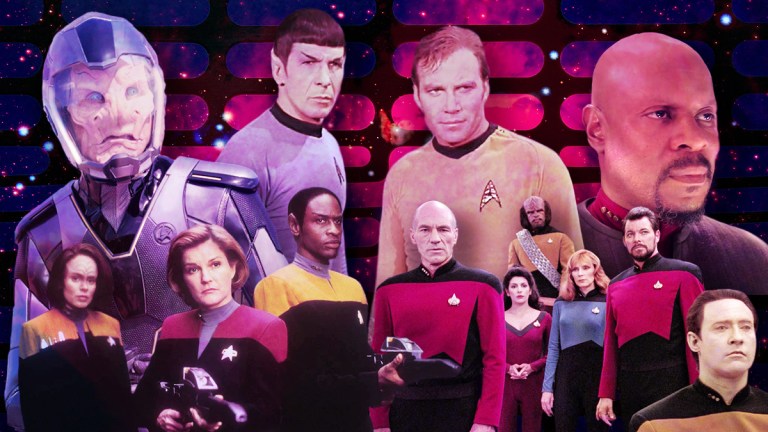
Since its debut in 1966, Star Trek has boldly gone to nearly every cultural aspect of modern life. The franchise has included 13 feature films with various crews, numerous board and video games, hundreds of action figures, commemorative plates — you name it, and there’s probably a version with a Starfleet logo on it.
But despite all this exploration into other media and fields, Star Trek remains best on television. And after a long drought, the franchise is finally thriving again in its original medium, despite the bumbling of its parent company Paramount. Even with Picard done and Discovery entering its fifth and final season, multiple series are still in production, including the acclaimed Strange New Worlds .
But as the greatest Trek theme song reminds us, it’s been a long road getting from there to here. The Original Series was canceled after a budget-strapped third season in 1969 and only built its following in syndication. Star Trek: The Next Generation overcame its rocky start to launch a renaissance that lasted throughout the 90s, but the cancelation of Enterprise led to 13 years without a new Trek show on TV.
With all of that behind us, and in the midst of a second Star Trek renaissance, it’s time to look back at the best and worst that the franchise has to offer.
Ad – content continues below
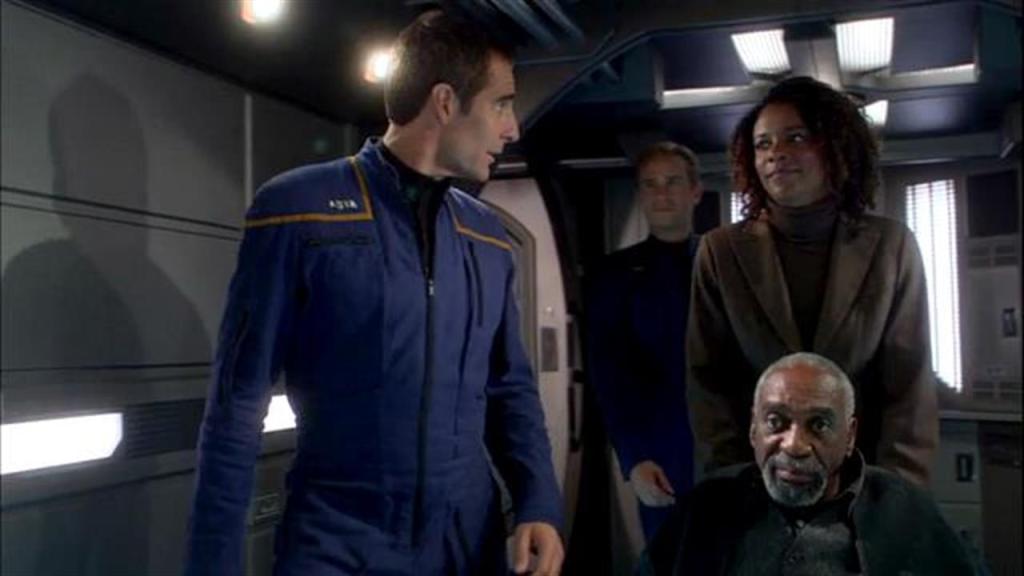
12. Enterprise (2001 – 2004)
Enterprise will always be known as the series that ended the first Star Trek renaissance. What began with The Motion Picture and peaked with multiple excellent television series finally fizzled out with a lackluster series that too often felt perfunctory.
The series certainly had the right idea in mind. Instead of continuing the storyline set out by The Next Generation or revisiting the Kirk era, Enterprise went back to the beginning, showing the rough early days of humanity’s warp-capable exploration and the establishment of the Federation.
Despite those noble intentions, Enterprise mostly floundered, starting with its cast. Trip Tucker made for a fun swashbuckling hero from the beginning, John Billingsley brought a delightful weirdness to his alien Doctor Phlox , and Jolene Blalock brought depths of nuance to the oft-underdressed Vulcan T’Pol, but the rest of the crew got either underutilized or used poorly. The incredibly likable Scott Bakula struggled to get a handle on Captain Archer, Linda Park’s Hoshi Sato got less to do than TOS Uhura, and Travis Mayweather had no qualities beyond being born in space.
However, Enterprise did eventually become a worthy Trek series. The Temporal Cold War gave the NX-01 more immediate relevance to other entries and the Xindi Civil War allowed the series to tackle questions raised by its post-9/11 present. However, even these advancements got overshadowed, partially by Ronald D. Moore leaving Trek to make the morally complex competitor Battlestar Galactica and by the producer’s decision to end the series by foregrounding Riker on the holodeck. In the end, Enterprise ’s time never came.

11. The Animated Series (1973 – 1974)
We don’t know what it was like to watch The Animated Series during its original run, but it must have been magical. A beloved series, seemingly gone forever, gets one more crack. While the cheap TV animation of the 1970s must have been a disappointment to even the show’s first viewers, and surely some lamented the loss of Walter Koenig’s Chekov , who was cut from the show for budget reasons (a script written by Koenig was used for the episode “The Infinite Vulcan”), most would take more Trek in any form available.
And to be sure, TAS was a worthy continuation of the original series. William Shatner, Leonard Nimoy, DeForest Kelley and their co-stars proved to be able voice actors, breathing life into decidedly more static representations of their characters. Even better, the series benefited from scripts by some of the best sci-fi writers of the era, including the ever-reliable D.C. Fontana and Ringworld creator Larry Niven.
To be sure, some of the novelty of TAS has worn off. Star Trek has proven to be a reliable franchise, and fans no longer have to be satisfied with the scraps that the studio tosses them. Even the best animated episodes feel diminished by their medium; less a second chance for the Enterprise crew and more a lesser version of the franchise we’ve come to love.
Get the best of Den of Geek delivered right to your inbox!
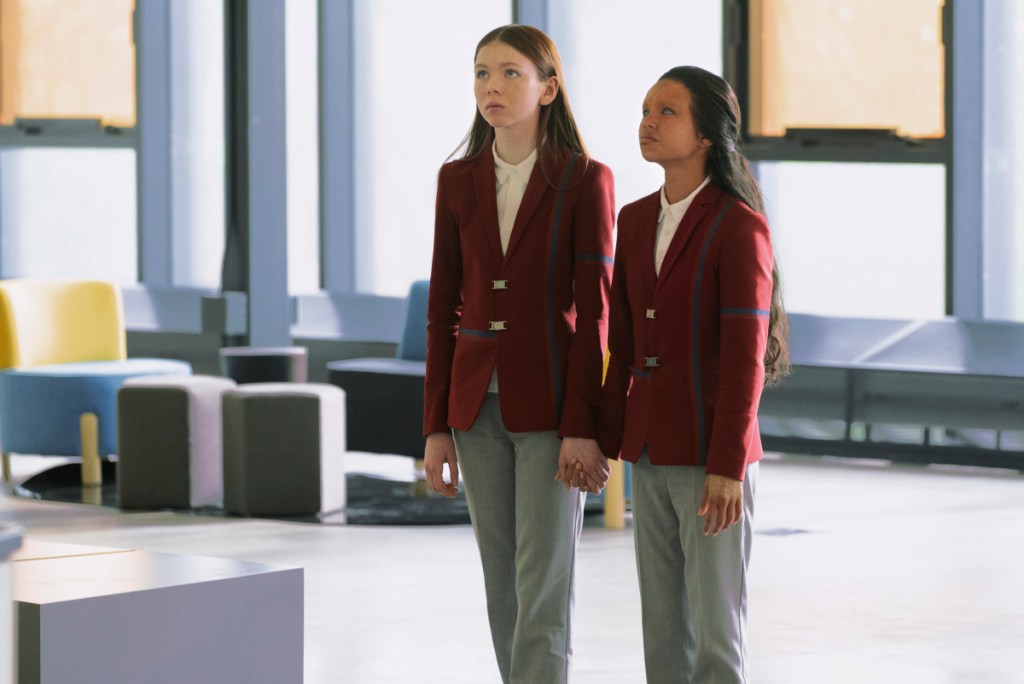
10. Short Treks (2019 – 2020)
Short Treks is exactly what it sounds like: 8-15 minute short movies set in various parts of the Star Trek universe. This small-scale approach means that it’s easy to forgive the Short Treks entries that go awry, and some certainly have. The series closer “Children of Mars” feels like an after-school special with slick music video aesthetics, made all the worse by the fact that it’s a lead-in to Picard season one, perhaps the worst season of Trek ever. The great composer Michael Giacchino finds some delightful turns in the Pixar -inspired “Ephriam and Dot,” but it’s a tonal disaster that makes the Discovery crew look like monsters.
Fortunately, most of Short Treks ’ ten episodes are pretty great. “Calypso” takes a horror turn with Aldis Hodge playing a crewman alone on a haunted ship. The hilarious “The Trouble with Edward” stars H. Jon Benjamin as an insecure scientist whose arrogance gives tribbles their mass reproduction abilities. And “Q&A” foregrounds the wonderful Strange New Worlds , as Spock and Number One bond over show tunes while stuck in a turbo lift.
Unfortunately, the inessential nature of Short Treks cuts against these stronger entries as well. Buried someplace on the Paramount+ app, Short Treks rarely have strong relevance to mainstream stories, and thus can be easily ignored, the good and the bad.

9. Picard (2020 – 2023)
Picard ended with a miracle season, a perfect mixture of fan service and proper character development. Deftly helmed by showrunner Terry Matalas , Picard season three caught up with the beloved Captain and his crew twenty years later to find them grown older and different, not just stuck in their old routines. Combined with exciting newcomers, especially the stick-in-the-mud Captain Liam Shaw , Picard season three whet viewers’ appetites for more adventures, hopefully in a series called Star Trek: Legacy .
Notice how I keep specifying “ Picard season three”? Because up until that season, Picard was an absolute disaster, the worst that the franchise ever put on screen. To be fair, it’s easy to understand Patrick Stewart’s trepidation at bringing back the old crew , worrying that the show would be a sad rehash of thirty-year-old stories. But in trying to avoid easy nostalgia, the first two seasons of Picard seemed to hate the very franchise it continued. The first season featured the brutal on-screen dismemberment of Icheb, a domesticated Riker with a pizza oven, and Starfleet officers decrying the “pure fucking hubris” of Picard. Season two was even worse, with its ‘Q has dementia’ plotline and a misguided approach to the Borg Queen.
Fortunately, the Captain eventually righted the ship and gave us the story we wanted. Notably, the third season didn’t achieve success by avoiding darker moments. Picard has painful confrontations with Ro Laren and Beverly Crusher, the loss of a child threatens to tear apart Riker and Troi, and Worf straight-up beheads a dude. But all of these unpleasant notes come from a place of respect for the characters, building on what came before instead of destroying it for shock value.
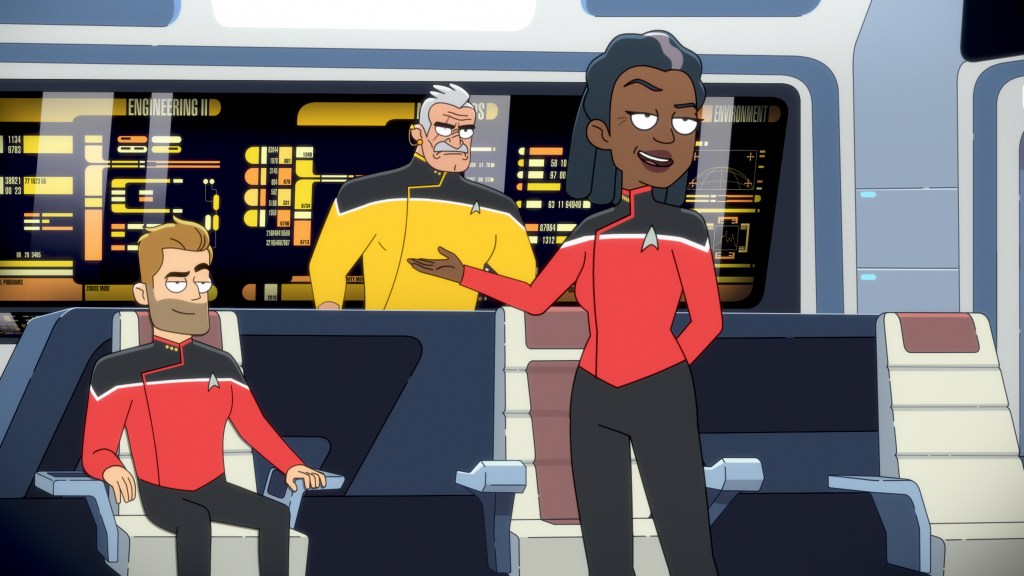
8. Lower Decks (2020 – Present)
There’s a unique joy to watching the Star Trek animated series Lower Decks , something akin to getting back together with old friends. Created by one-time Rick and Morty showrunner Mike McMahan, Lower Decks follows a quartet of ensigns on the USS Cerritos, a Starfleet ship tasked with mundane missions. With lower stakes, the characters have more downtime, allowing them to debate the merits of TNG ’s Rambo riff Roga Danor or play a Klingon DVD game hosted by Martok (voiced again by J. G. Hertzler). In these moments, Trekkies can’t help but chuckle with recognition. How is it that anyone else in the world laughs about these arcane parts of Trek lore?
But at the same time, Lower Decks can get somewhat exhausting. The jokes come fast and furious, as leads Tawny Newsome, Jack Quaid , Eugene Cordero, and Noël Wells sometimes shout their lines (a fact referenced in the recent crossover with Strange New Worlds ). And at times, the multitudinous in-jokes can become the point of the episode, banking way too much investment in the humor of a Tom Paris commemorative plate.
However, Lower Decks has also proven itself to be capable of genuine character exploration. Over the course of the series, Newsome’s Beckett Mariner has revealed herself not to be a too-cool-for-school rebel from an 80s “slobs vs snobs” comedy, but an incredibly capable future officer whose difficult relationship with her mother drives her to self-sabotage. Wells’s Tendi fights against stereotypes about Orion pirates and sex slaves to establish herself as a good-hearted scientist. In these moments, LD finds its jokes in character motivations, not just in winking references.
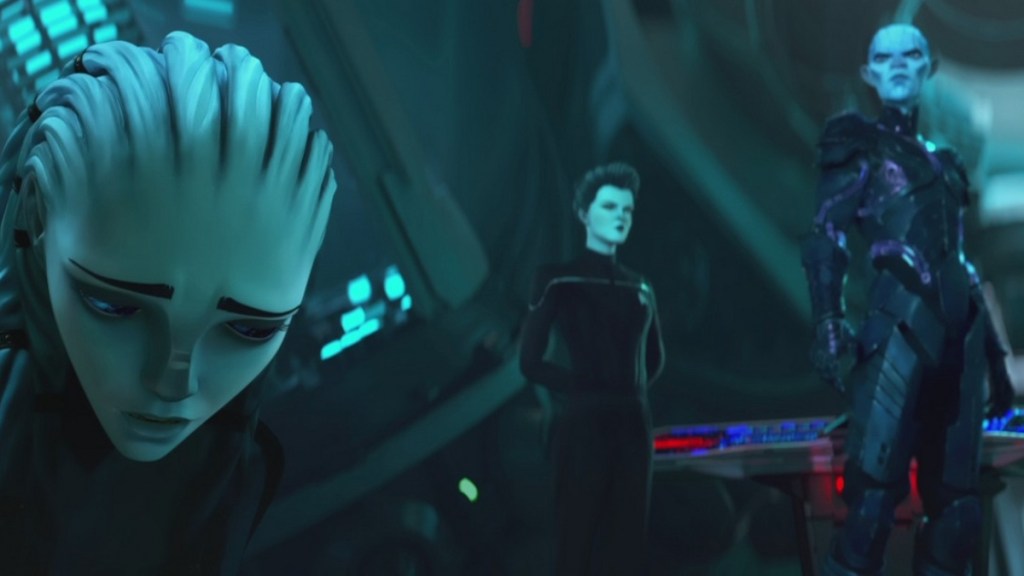
7. Prodigy (2021)
We really hate putting Prodigy so low. As a children’s animated series with ties to the still-underrated Voyager , it’s easy to see why so many Trekkies have skipped over it. That oversight certainly had something to do with Paramount’s boneheaded decision to remove it from Paramount+, the so-called “Home of Star Trek .” But those who did catch Prodigy , especially with their Trek -agnostic kids, discovered a truly delightful series that captured everything great about the franchise.
Set deep in the Delta Quadrant, Prodigy follows a group of alien teens , led by Dal R’El (Brett Grey) and Gwyn (Ella Purnell), who escape a prison colony via the abandoned Starfleet craft the USS Protostar. With help from a holographic Captain Janeway , the kids learn to embrace the ideals of the Federation, while also uncovering their connection to the evil overlord the Diviner (John Noble). The kids’ idealism and desperate situation allows them to reaffirm Starfleet’s first principles, even as they encounter adults from the Federation who have forgotten the meaning behind the symbols they wear.
By making outsiders the focus, Prodigy serves as a perfect entryway into Trek for its younger primary audience. But that doesn’t mean it avoids deep cuts. The main cast counts among its number a Tellurite (voiced by the always hilarious Jason Mantzoukas) and a Medusan (Agnus Imrie). Everyone from Spock and Crusher to Odo and Chakotay have appeared as holograms, and the series even featured the return of one-offs Admiral Jellico and the Outrageous Okona. Through Prodigy , even the most uninitiated Trek fan gets to see the franchise’s goofiest characters and most inspiring ideals.
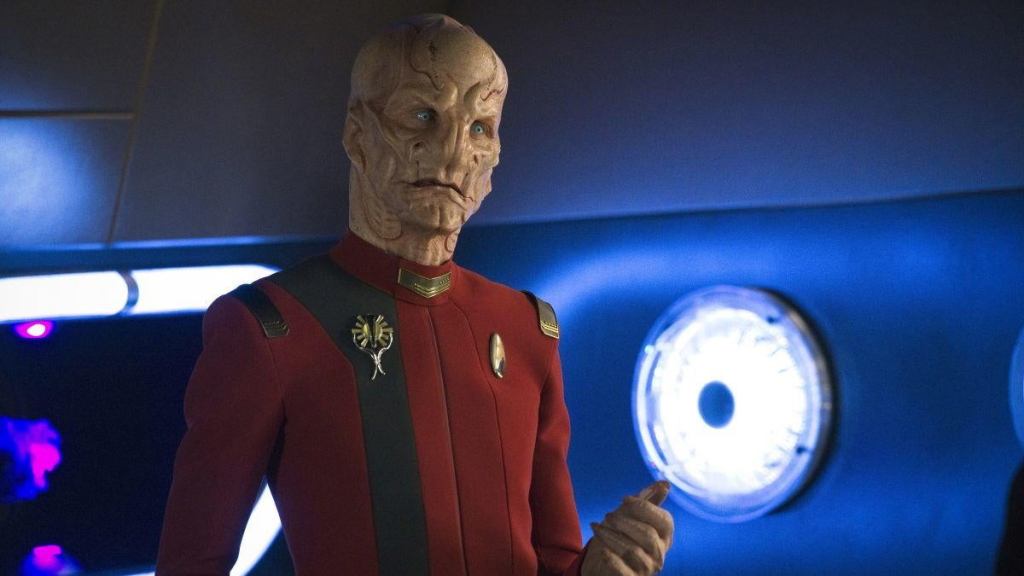
6. Discovery (2017 – 2023)
Strangely, Discovery only gets better as other Star Trek series embrace the standard form. When it first launched under the direction of the often wonderful but always idiosyncratic Bryan Fuller , Discovery aggressively separated from and connected to everything that came before. Instead of taking advantage of its likable cast, Disco focused almost entirely on Michael Burnham (Sonequa Martin-Green), the heretofore unmentioned adopted sister of Spock. Season-long serialized arcs often built to disappointing reveals (all the dilithium in the 32nd century burned because a Kelpian had a temper tantrum?) and nobody asked to watch a topless Klingon woman commit sexual assault.
But as Strange New Worlds and Lower Decks become more prominent during the second Trek renaissance, Disco ’s oddities can be accepted as the experiments they were meant to be. After all, Fuller intended the series to be an anthology, focusing on different characters and timelines each season. That offbeat spirit remained in the show, even after Fuller left production. As it heads into its fifth and final season, Disco remains committed to taking Trek into new, uncharted territory.
Nowhere is that more clear than in its most controversial aspect: the crying. Emotion has always been a key part of Star Trek , represented by McCoy in the triumvirate with Kirk and Spock. But with Disco , emotion became a valid form of problem-solving, taking its place beside the franchise’s favored approach, logical thinking. Even if the crying in Discovery doesn’t work for everyone, there’s no denying that it serves the franchise’s core goals by finding new ways of understanding humanity.
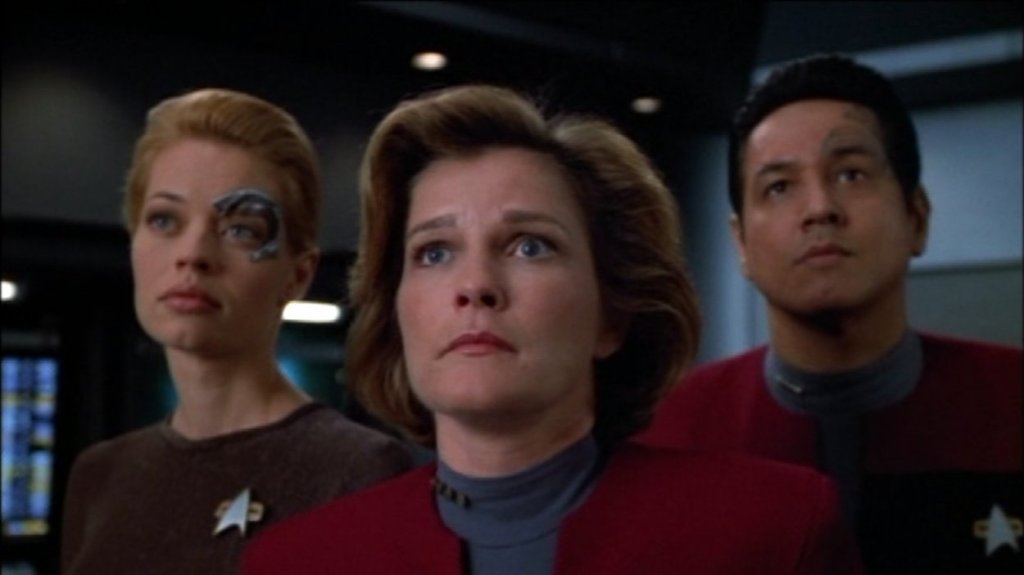
5. Voyager (1995 – 2001)
Most Trek series get off on the wrong foot, but few screw things up like Voyager . Despite a fantastic premise, in which Captain Janeway strands her crew in the Delta Quadrant and is forced to work with Maquis dissidents, the series stumbles through some terrible decisions. Not only does it try to push the incredibly stupid and ugly Kazon as the chief enemy race (the way-better Vidiians are right there!), but it also acts like Neelix, who is controlling and petty with his two-year-old girlfriend Kes, is a lovable goof. Even for a Rick Berman-produced show, that’s creepy.
You do have to get over the fact that the show chooses standalone episodes over serialization, basically killing any larger tension and most character development, but the show quickly makes it easier to forgive that shortcoming by telling some fantastic single episodes. By the time the fantastic Jerry Ryan joins the show in season four as ex-Borg Seven of Nine and the Kazon get left behind, Voyager delivers some all-time great Trek episodes, including “Year of Hell” and “Blink of an Eye.”
Latest TV reviews
Star wars: the acolyte episode 5 review: the first revenge of the sith, supacell review: black british sci-fi would captivate even without the superpowers, house of the dragon season 2 episode 2 review: the bloody aftermath and sullied white cloaks.
Even better, the series settles into fleshing out its primary characters. Yes, this does mean that some go by the wayside — not just the departed Kes, but also Chakotay becomes a big nothing, Paris and B’Elanna get pushed into the domestic bliss corner, and Kim stays an ensign. But the tensions between Seven of Nine, Janeway, and the Doctor make for a classic Trek trio, allowing the show to explore the nature of humanity while also making the Captain the most adventurous of Starfleet leaders. Plus, Voyager gives us the best Trek kid ever in Naomi Wildman and no we will not hear counterarguments.
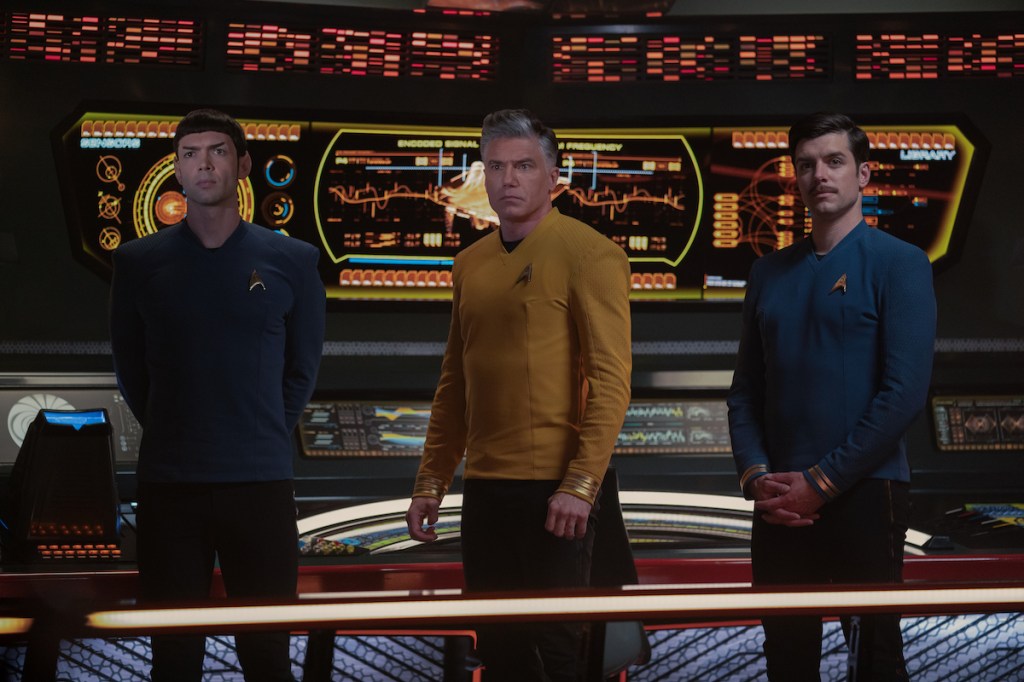
4. Strange New Worlds (2022 – Present)
Aside from TOS , nearly every Trek series has started off with a bad season or two. But that’s not the case with Strange New Worlds , which has not had a single bad episode yet.
SNW returns to the early days of the USS Enterprise, following the adventures of Kirk’s predecessor Captain Christopher Pike and a crew that includes young Spock and Uhura. What could have been a reactionary retreat to a safe era of Trek , complete with a straight white guy in the captain’s chair, has turned out to be Trek at its best. Anson Mount makes for not only an affable, big brother of a leader as Captain Pike , but he’s also a remarkably generous performer. Time and again, Mount finds new ways of supporting his scene partners, whether it’s playing a baffled straight man when Spock gets overwhelmed by his human side or reassuring his security chief La’an with words of gentle wisdom.
Thanks to Mount’s ability to share the spotlight, SNW has been able to develop the best ensemble cast of any Trek series, a remarkable feat given its use of well-known characters. Ethan Peck has successfully established his own take on Spock, playing a more emotional version of the character that still feels like someone who will grow up to be Leonard Nimoy . Celia Rose Gooding plays Uhura as an incredibly talented Ensign who doesn’t yet know that she’ll become the legendary Starfleet comms officer. Babs Olusanmokun, Jess Bush, and Rebecca Romijn fully round out characters barely glimpsed in TOS .
With this outstanding cast and crew, SNW puts a modern sheen on TOS themes and even episodes, without diverging too hard from what came before. Case in point: the season one finale “ A Qu a lity of Mercy ,” which revisits the classic episode “Balance of Terror” in an alternate reality. It’s our love for Pike and other characters that makes us want them to sacrifice a better life in order to restore the original timeline, even if it means Pike must accept his fiery fate.
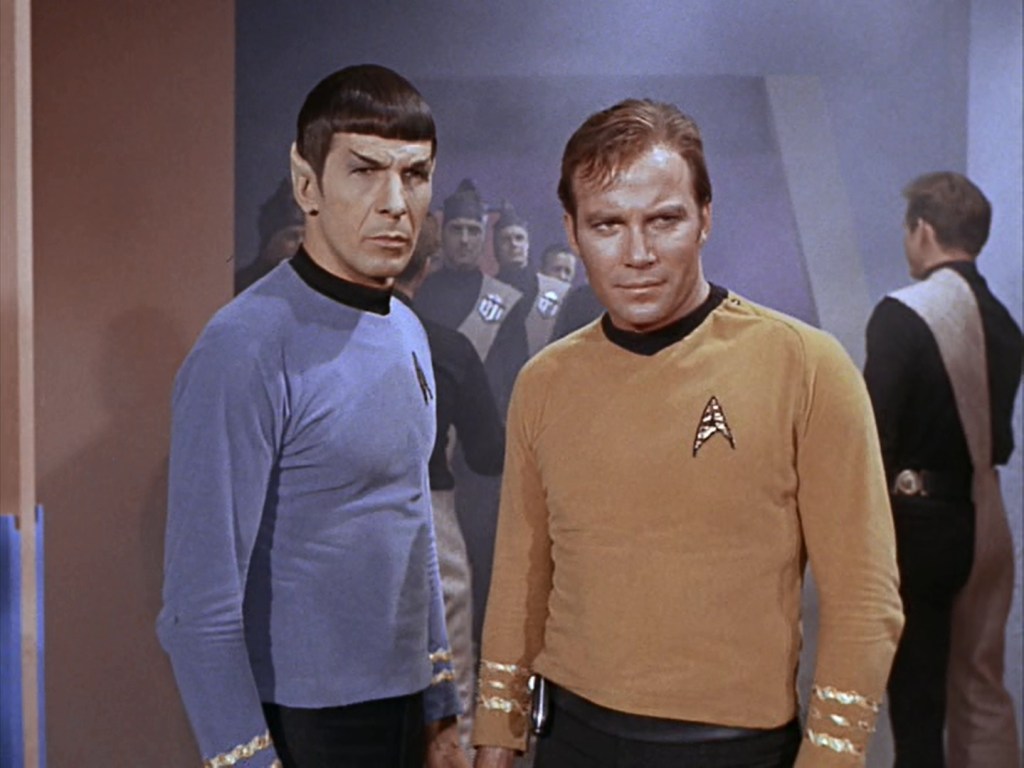
3. Star Trek (1966 – 1969)
Newcomers to the franchise sometimes struggle with the original series, finding it hopelessly dated. TOS does definitely embrace the aesthetics of its time, with its miniskirt uniforms, technicolor background lighting, and, yes, space hippies. But like The Twilight Zone , its closest counterpart of the era, both in terms of themes and influence, Star Trek used its outlandish premise to speak to the heart of the human condition.
At this point, it’s easy to make jokes about William Shatner ’s idiosyncratic delivery, but there’s no denying how well it works for Captain Kirk. Every pregnant pause, every sparkle in his key-lit eyes reveals a genuine love for exploration. When combined with the logical Spock and the irascible McCoy, Star Trek establishes a perfect formula for spacefaring television adventures. Even as they encounter low-budget baddies like the costume-shop Gorn or the blocky supercomputer Landru, Kirk and Co. remain focused on the human element.
Thanks to this approach, TOS perfected the sci-fi tension between high-concept ideas and terrestrial concerns. Gene Roddenberry and writers such as D.C. Fonatana and Gene L. Coon got to grapple with issues such as racism and the Vietnam War with stories about Klingons and Romulans. As rich and fantastic as TOS got, it never lost the humans at the center, making it ripe for continuing adventures and spin-offs.
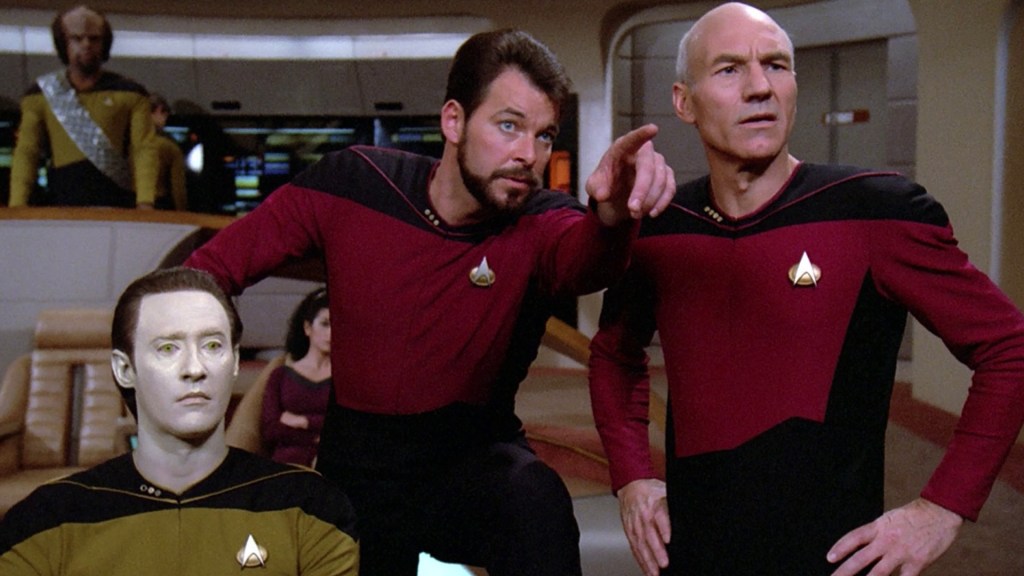
2. The Next Generation (1987 – 1994)
Patrick Stewart didn’t empty his suitcase. That’s how certain he was in the failure of Star Trek: The Next Generation . Stepping in for the hammy masculinity of the established Captain Kirk, the patrician, thoughtful (and bald) Jean-Luc Picard seemed like an ill-fit for the franchise, even with the more traditionally heroic Will Riker in tow. And for the first two seasons, Stewart seemed to be correct, especially when Roddenberry and others tried to restrict the TNG cast to TOS -style stories.
But by the time it hit its third season, TNG perfected the Star Trek formula, embracing what was so great about TOS while also emphasizing its most underutilized asset, the ensemble cast. Instead of putting Picard at the center of a trio, which initially included Data and LaForge, the Captain became the imperfect parent of a family filled with interesting personalities. Debates about morality and philosophy occurred around a table in the ready room, where several voices chimed in on important issues.
This isn’t to say that TNG didn’t grapple with big ideas like its predecessor. “The Measure of a Man” raised questions about the dignity of life, “ Chain of Command ” looked at the cost of war, and “Ensign Ro” considered the morality of resistance. It’s just that all of these episodes came from a place of love and investment in the characters. We tuned in every week not just to seek out new life and new civilizations, but to spend more time with interesting characters whom we loved, making even the most outlandish adventure feel as comfortable as a poker game with old friends.
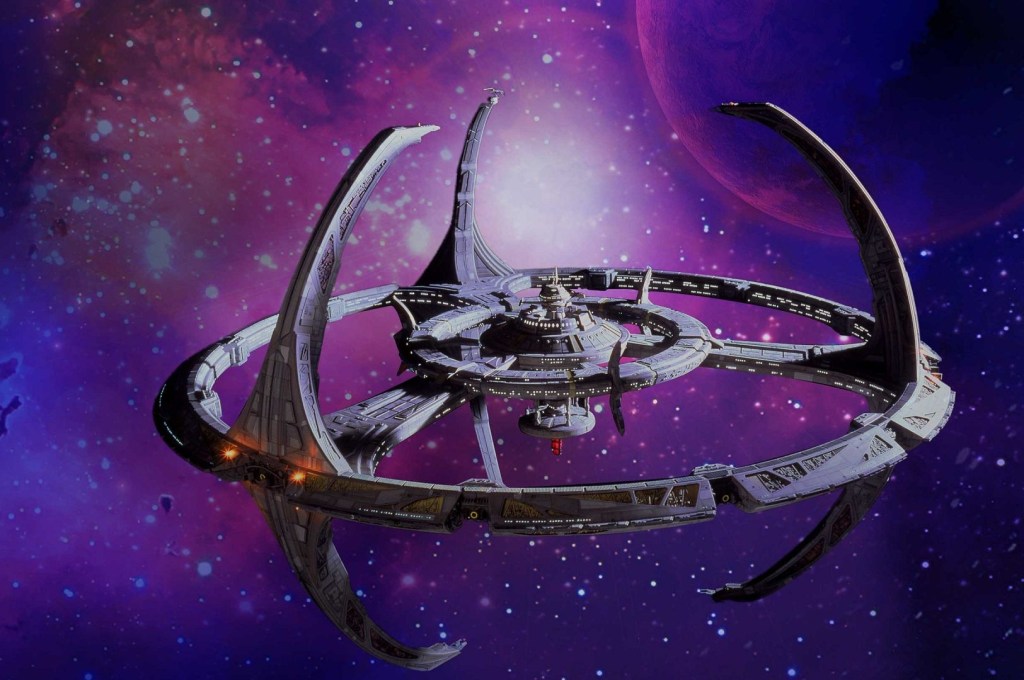
1. Deep Space Nine (1993 – 1999)
What initially seemed like too far a departure from the Star Trek formula has now become the standard hipster answer for ‘best Trek ’. But, you know, Deep Space Nine is the best Trek !
DS9 veered from its predecessors in several important ways. Instead of focusing on a space-faring Enterprise, it remained on the titular space station (although the addition of the Defiant in season three allowed the show to indulge in standard “ship and crew” storylines). It dealt directly with religion, thanks to its engagement with the Bajoran prophets who chose Commander Sisko as their Emissary. And it took a notably darker tone as the space station shifted from the outpost at the edge of Federation space to the frontline of the massive Dominion War.
Despite these diversions, DS9 combined the best of the two previous series. Like TNG , DS9 boasted an excellent cast of interesting characters. As Benjamin Sisko , Avery Brooks played the best dad in television history, a grieving widower whose ideals often put him at odds with his Starfleet superiors. Armin Shimerman , Aron Eisenberg, and Max Grodénchik singlehandedly redeem the Ferengi, turning them from annoying and ugly enemy aliens to complex creatures with their own morality. And Nana Visitor’s Kira Nerys found layers of nuance in her Bajoran freedom fighter forced to work with the Federation.
With these complex characters in place, DS9 told some of the most complex and compelling stories in Trek history, episodes that both challenged and upheld the franchise’s core utopian ideals. “In the Pale Moonlight” found Sisko bending his principles to force a treaty with the Romulans and “Far Beyond the Stars” reaffirmed the importance of science fiction. The show even made space for some of the best comedic episodes in Trek history, such as the baseball romp “Take Me Out to the Holosuite” and the 30th-anniversary special “Trials and Tribble-ations.” Deep Space Nine showed Trek at its most humane, ambitious, complex, and idealistic, making it the best show in the franchise.

Joe George | @jageorgeii
Joe George’s writing has appeared at Slate, Polygon, Tor.com, and elsewhere!
10 Best ‘Star Trek’ Movies and TV Shows of the Franchise (So Far)
By Clayton Davis
Clayton Davis
Senior Awards Editor
- Oscars Invite 487 New Members: Lily Gladstone, Catherine O’Hara, Jessica Alba, ‘RRR’ Director S.S. Rajamouli and More 5 days ago
- Gloria Calderon Kellett, Xolo Mariduena and Edward James Olmos and More Join NALIP’s 2024 Media Summit (EXCLUSIVE) 6 days ago
- ‘Wheel of Time’ Director Sanaa Hamri Talks Finale, Teasing ‘Rings of Power’ Season 2 and Being Open to Making ‘Sisterhood of the Traveling Pants 3’ 1 week ago

Captain James T. Kirk, better known around these parts as William Shatner, turns 90 years old on March 22. The actor, director, producer and writer has had a seven decade careers, with a community of devoted fans that revere not just his place as a figure in the universe but the entire canon of “Star Trek” and its various entities in film and television.
We’ve seen multiple starship captains and leaders over the decades, including Captain Jean-Luc Picard (Patrick Stewart), Philippa Georgiou (Michelle Yeoh), three Pikes (Jeffrey Hunter, Bruce Greenwood and Anson Mount), Jonathan Archer (Scott Bakula), Benjamin Sisko (Avery Brooks), a rebooted James T. Kirk (Chris Pine) and the ultimate badass Kathryn Janeway (Kate Mulgrew), arguably the best of them all.
The entire franchise has spawned seven spin-off television series, 13 feature films and two animated series. The original series ran from 1966 to 1969 on NBC and was canceled just after three seasons. After which, we moved to an animated series (1973-1974), “Star Trek: The Next Generation” (1987-1994), “Deep Space Nine” (1993-1999), “Voyager” (1995-2001). “Enterprise” (2001-2005), and the three still ongoing “Discovery” (2017), “Picard” (2020) and “Lower Decks” (2020).
In the film sector, the original series delivered six films — “The Motion Picture” (1979), “The Wrath of Khan” (1982), “The Search for Spock” (1984), “The Voyage Home” (1986), “The Final Frontier” (1989) and “The Undiscovered Country” (1991). “The Next Generation” provided four – “Generations” (1994), “First Contact” (1996), “Insurrection” (1998) and “Nemesis” (2002) while “The Kelvin Timeline” or rebooted version has given three “Star Trek” (2009), “Star Trek Into Darkness” (2013) and “Star Trek Beyond” (2016), with all three having the highest box-office grosses of any film in the whole franchise. The 2009 film is also the only one to win an Academy Award for best makeup (Barney Burman, Mindy Hall and Joel Harlow), along with “The Voyage Home,” garnering the most nominations at four.
There are still more in development under Paramount Plus and on the studio side. “Star Trek: Prodigy,” an animated series co-written and created by Dan Hageman and Kevin Hageman that focuses on a group of teenagers who get onto an abandoned starship, is set to drop later in 2021. From creators Akiva Goldsman, Alex Kurtzman and Jenny Lumet, “Star Trek: Strange New Worlds” is a spin-off of “Discovery” and a prequel to the original series, following Captain Christopher Pike (Ansel Mount) and the crew of the USS Enterprise. Rebecca Romijn and Ethan Peck will also reprise their roles as Number One and Spock. Still yet to be confirmed, there is reportedly a Khan Noonien Singh limited series on the table, which explores the storyline from “The Wrath of Khan,” tentatively titled “Ceti Alpha V.”
Live long and prosper, Mr. Shatner.
Check out the full ranked list.
Star Trek: First Contact (1996)

Released : November 22, 1996 Written by : Brannon Braga, Ronald D. Moore (screenplay by and story by) and Rick Berman (story by)
Cast : Patrick Stewart, Jonathan Frakes, Brent Spiner, LeVar Burton, Michael Dorn, Gates McFadden. Marina Sirtis, Alfre Woodard, James Cromwell, Alice Krige
Defining moments : “Jean-Luc blow up the damn ship” and Data saying “resistance is futile.”
“The Next Generation” struggled the most when translating from television to the big screen. Of the four features, “First Contact” was the most enjoyable, assembling interesting set pieces and a few memorable one-liners. Deservingly picking up an Oscar nomination for best makeup for Michael Westmore, Scott Wheeler and Jake Garber (losing to “The Nutty Professor”), it’s Jonathan Frakes’ (First Officer William T. Riker) first outing as a feature director. What makes the film a success is it abandons the notion that all roads have to involve James T. Kirk, which is one of the main reasons “Generations” really missteps.
Deep Space Nine (1993-1999)

Series run : January 1993 to June 1999 Created by : Rick Berman and Michael Piller
Cast : Avery Brooks, René Auberjonois, Terry Farrell, Cirroc Lofton, Colm Meaney, Armin Shimerman, Alexander Siddig, Nana Visitor, Michael Dorn, Nicole de Boer
Defining moments : Resistance with the Maquis, The Dominion War and The Mirror Universe
Commanding Officer and later Captain Benjamin Sisko (Brooks) was the best part of a series that wasn’t as consistently entertaining as its predecessors. Brooks is a grieving widower whose wife is killed by the Borg, an we follow him, along with his son Jake (Loft), and the rest of a fun crew that includes the Changeling Odo (Auberjonois), Medical Officer Julian Bashir (Siddig), Science Officer Jadzia Dax (Farrell), Operations Officer Miles O’Brien (Meaney) and a cult favorite Quark (Shimerman). The last two seasons of “The Next Generation” are set in the same years as the first two of “Deep Space Nine,” which then lines up with “Voyager” for the last five seasons.
Discovery (2019)

Series run : Premiered September 2017 (still running) Created by : Bryan Fuller and Alex Kurtzman
Cast : Sonequa Martin-Green, Doug Jones, Shazad Latif, Anthony Rapp, Mary Wiseman, Jason Isaacs, Wilson Cruz, Anson Mount, David Ajala, Rachael Ancheril
Defining moments : The betrayal of Lieutenant Commander Michael Burnham
This series is still finding its footing and has lots to proud of thus far. It’s the first of the franchise to focus on a First Officer rather than the Captain, taking place about ten years before the original series. In the universe, we typically see someone going against orders for the “greater good.” Still, this series has taken that premise and expanded it with Commander Michael Burnham (Green), leading a mutiny against Captain Phillipa Georgiou (Yeoh) and starting a war against the Klingons, leading to the death of her captain. That alone creates a new type of storytelling for the franchise to explore and could help pull in more viewers of Paramount Plus’ show. It won a Primetime Emmy Award last year for outstanding prosthetic makeup for a series, limited series, movie or special, the first for the show thus far.
The Undiscovered Country (1991)

Released : December 6, 1991 Written by : Nicholas Meyer, Denny Martin Flinn (screenplay by), Leonard Nimoy, Lawrence Konner, Mark Rosenthal (story by)
Cast : William Shatner, Leonard Nimoy, DeForest Kelley, James Doohan, Walter Koenig, Nichelle Nichols, George Takei, Kim Cattrall, David Warner, Christopher Plummer
Defining moments : The final sign-off (“If I were Human, I believe my response would be, go to hell…if I were you human.”)
The original series saga’s final installment in feature-length form is enjoyable, showcasing a possible peace between the Klingon Empire and the Federation until a secret agenda is revealed that puts all our favorite heroes at risk. It also marks the final group appearance of the major cast members of the original series, with the late Christopher Plummer as the one-eyed Klingon General Chang, who is having the time of his life. We also have a cameo appearance by Christian Slater, whose mother, Mary Jo Slater, was the film’s casting director. The film was ultimately nominated for two Oscars (best sound effects editing and makeup) and, at the time, was the highest opener for the franchise. Before “Avengers: Endgame,” a reminder that the moving closing credit signature sequence was delivered in “The Undiscovered Country.”
Star Trek: The Next Generation (1987-1994)

Series run : September 1987 to May 1994 Created by : Gene Roddenberry
Cast : Patrick Stewart, Jonathan Frakes, LeVar Burton. Denise Crosby, Michael Dorn, Gates McFadden, Marina Sirtis, Brent Spiner, Wil Wheaton
Defining moments : Tasha Yar’s death in episode “Skin of Evil”
The evolution of “Star Trek” was helped immensely by “The Next Generation,” which delivers the classically trained Patrick Stewart as Jean-Luc Picard, with one of the entire franchise’s best crews. Sleeker, with more interesting characters (admittedly not as well explored as they could have been), the show also encompasses one of the most notable deaths of any of the television outings with Tasha Yar (played by Denise Crosby). In the 23rd episode of the first season, we’ve already grown a connection to the Enterprise-D crew. With a behind-the-scenes request by Crosby to be removed from her contract, the act gave us one of the most emotional episodes of the franchise. Also…the creature Armus is TERRIFYING.
The Search for Spock (1984)

Released : June 1, 1984 Written by : Harve Bennett
Cast : William Shatner, DeForest Kelley, James Doohan, George Takei, Walter Koenig, Nichelle Nichols, Merritt Butrick, Christopher Lloyd
Defining moments : Spock’s “death.”
Let the great debate begin. Before #FilmTwitter quarreled about the merits of “Star Wars: The Last Jedi” (spoiler alert: it’s the second-best of the entire franchise), there was a discussion on the qualities of the third installment of the Kirk saga. It was a huge sequel weekend in June 1984, as it opened against the second weekend of “Indiana Jones and the Temple of Doom” and the fourth week of “The Natural,” emerging victorious. It also marks the directorial debut of Leonard Nimoy, who was the first cast member ever to helm one of its films. The visual effects are really where the movie comes alive, showcasing beautiful sequences developed by Industrial Light & Magic. What the film does is give heft and agency to the friendship between Kirk and Spock, and although the death of Kirk’s son is done haphazardly, the action sequences are pulse-pounding.
Voyager (1995-2001)

Series run : January 1995 to May 2001 Created by : Rick Berman, Michael Piller, Jeri Taylor
Cast : Kate Mulgrew, Robert Beltran, Roxann Dawson, Jennifer Lien, Robert Duncan McNeill, Ethan Phillips, Robert Picardo, Tim Russ, Garrett Wang, Jeri Ryan
Defining moments : “Same to you old friend” from “Year of Hell” episode with Janeway and Tuvok
Nostalgia and purists will say that the original “Star Trek” is the best because without that, we don’t have anything else that follows. While correct, in terms of quality, acting, and sheer audacity of the canon, “Voyager,” is behind-the-scenes, the best of them all. Kate Mulgrew’s Captain Janeway is vivacious, and she’s undoubtedly one of the best actresses to grace our screens (as also seen in Netflix’s “Orange Is the New Black”) and Tuvok (played brilliantly by Tim Russ) is simply amazing. Also, “Seven of Nine” was my everything in my childhood, leading into my teenage years.
Star Trek: The Original Series (1966-1969)

Series run : September 1966 to June 1969 Created by : Gene Roddenberry
Cast : William Shatner, Leonard Nimoy, DeForest Kelley
Defining moments : “The Doomsday Machine”
You have to respect the origins of a franchise, and we should properly genuflect before the series that started it all. The entire cast goes for it, with little budget and strange scene constructions, but it has more highs than it does lows, featuring numerous memorable moments. Many will say that the defining episodes of the series fall somewhere between “City on the Edge Forever” (with the death of Edith Keeler) or the Kirk and Spock battle in “Amok Time” (thanks to “The Cable Guy” with Jim Carrey), but “The Doomsday Machine” has the most tension and an outstanding turn from guest star William Windom as Commodore Matt Decker.
The Wrath of Khan (1982)

Released : June 4, 1982 Written by : Jack B. Sowards (screenplay and story by) Harve Bennett (story by)
Cast : William Shatner, Leonard Nimoy, DeForest Kelley, James Doohan, Walter Koenig, George Takei, Nichelle Nichols, Bibi Besch, Merritt Butrick, Paul Winfield, Kirstie Alley, Ricardo Montalbán
Defining moments : Spock’s “death”
If “Skin of Evil” defines the emotions on television, then “The Wrath of Khan” represents the silver screen for the franchise property. Our favorite Vulcan’s self-sacrifice, paired with Kirk’s eulogizing friend, is a tough one to stomach. It obviously is undone with the next entries of the cinematic universe, but it holds up immensely as a moving tribute to a beloved character. Sadly, no major awards love came for the film, which in many circles stands as the best in the franchise. Add the bombastic score of James Horner, and you receive amazing results.
Star Trek (2009)

Released : May 8, 2009 Written by : Roberto Orci, Alex Kurtzman
Cast : John Cho, Ben Cross, Bruce Greenwood, Simon Pegg, Chris Pine, Zachary Quinto, Winona Ryder, Zoe Saldana, Karl Urban, Anton Yelchin, Eric Bana, Leonard Nimoy, Chris Hemsworth
Defining moments : The final battle (“Fire everything!”)
Let’s get this out of the way nice and early.
Star Trek” (2009) received four Oscar nominations – for sound mixing, sound editing, visual effects, and makeup, which it won – it’s the one film of the franchise that should have been nominated for best picture, especially in the first year of a guaranteed 10 films for the Academy’s top category. I would also put it on a ballot for adapted screenplay and film editing. You don’t get an action-packed film like this rebooted entry that focuses beautifully on the beloved characters’ origin stories, giving them alternate timelines that don’t feel forced and still capture the spirit of what makes the franchise so great. SAG Awards should have also jotted it down for best cast ensemble. While the sequels have never recaptured that early magic, J.J. Abrams has proven he knows how to set up a story arc properly (sticking the landing is still up for debate). I only hope as Paramount Plus progresses forward in the universe, they take plays from the Kevin Feige playbook and give themselves a long roadmap that will pay off to something truly extraordinary.
More from Variety
‘family portrait’ review: formally astute ensemble piece extracts the unsettling essence of a wealthy clan, car buyers want more screens as in-vehicle entertainment rises, survey data: do consumers want gen ai in entertainment content, more from our brands, in defense of camila cabello — and letting the pop girlies try new things, rimac is launching a self-driving ride-share service. here’s what we know., lebron opts out but plans to re-sign with lakers, per report, the best loofahs and body scrubbers, according to dermatologists, greenleaf mvp lynn whitfield shares a discouraging spinoff update: ‘but keep our fingers crossed’, verify it's you, please log in.
- Tickets & Showtimes
- Trending on RT
TAGGED AS: films , movies , television , TV

(Photo by ©2023 CBS Studios Inc. All Rights Reserved.)
For Star Trek Day, we decided to have a look at how all of the Star Trek films and TV shows across the entire universe rank together. Interestingly, the most recent entry in the franchise came out on top. Star Trek: Strange New Worlds — led by Anson Mount as Captain Christopher Pike, Rebecca Romijn as Number One, and Ethan Peck as Science Officer Spock — boasts two Certified Fresh seasons at 99% and 97% on the Tomatometer. Not too bad for the youngster of a franchise whose history goes back 57 years to its inception with the original Star Trek series created by Gene Roddenberry.
Related: • Star Trek TV Series Ranked by Tomatometer • All Star Trek Movies Ranked by Tomatometer
It’s worth noting that while SNW has a 98% average Tomatometer on 84 reviews across two seasons, the 2009 reboot film Star Trek in the No. 2 position is Certified Fresh on 356 reviews. Some might argue that the film’s volume of reviews makes it the top title, but if we want to start nitpicking on the franchise level, the series also represents 57 hours of programming compared to the film’s 2 hours and 7 minutes. Perhaps the audience score can settle the debate: a 78% average for the series versus 91% for the film. And should No. 3, The Animated Series , even be counted with its relatively meager 18 reviews?
And no “probably” about it, Star Trek V: The Final Frontier is officially — by Tomatometer standards anyway — the worst of the franchise.
What do you think? Tell us which is your favorite Star Trek movie or series in the comments.
Star Trek: Strange New Worlds (2022) 98%
Star Trek (2009) 94%
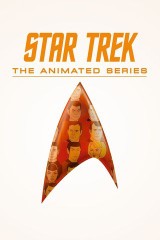
Star Trek: The Animated Series (1973) 94%
Star Trek: Prodigy (2021) 94%
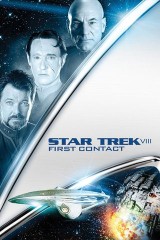
Star Trek: First Contact (1996) 93%
Star Trek: Lower Decks (2020) 92%
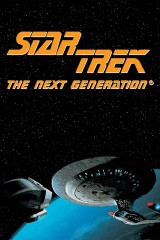
Star Trek: The Next Generation (1987) 92%
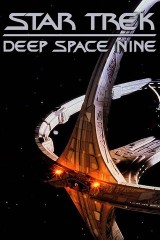
Star Trek: Deep Space Nine (1993) 91%
Star Trek: Picard (2020) 89%
Star Trek Beyond (2016) 86%
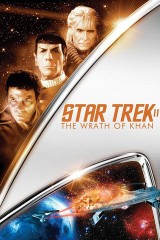
Star Trek II: The Wrath of Khan (1982) 87%
Star Trek: Discovery (2017) 84%
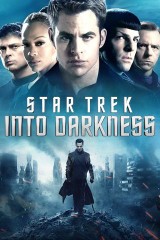
Star Trek Into Darkness (2013) 84%
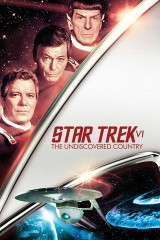
Star Trek VI: The Undiscovered Country (1991) 83%
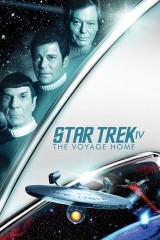
Star Trek IV: The Voyage Home (1986) 82%
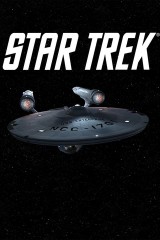
Star Trek (1966) 80%
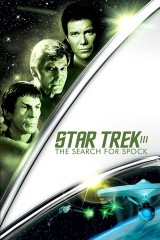
Star Trek III: The Search for Spock (1984) 79%
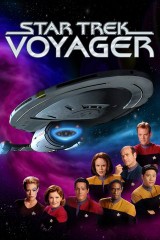
Star Trek: Voyager (1995) 76%
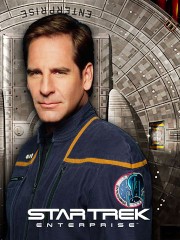
Star Trek: Enterprise (2001) 56%
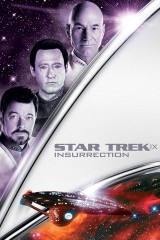
Star Trek: Insurrection (1998) 55%
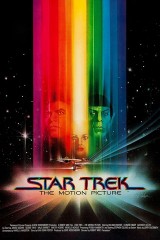
Star Trek: The Motion Picture (1979) 53%
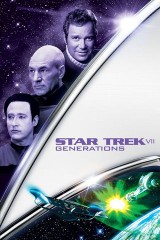
Star Trek Generations (1994) 48%
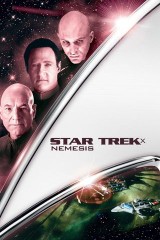
Star Trek: Nemesis (2002) 38%
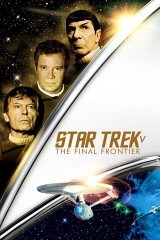
Star Trek V: The Final Frontier (1989) 23%
Star Trek movies and series can be viewed by subscription on Paramount+ , and purchased on demand on Vudu , Prime Video , Apple TV , and elsewhere.
Related News
The Bear : Season 3 First Reviews: Still One of the Best Shows on TV
A Quiet Place: Day One First Reviews: A Tense, Surprisingly Tender Thriller Anchored by Fantastic Performances
MaXXXine First Reviews: A Gnarly, Potent Satire with a Magnetic Mia Goth at Her Best
More Countdown
Kevin Costner’s Best Movies and Shows Ranked by Tomatometer
Best Movies of 2024: Best New Movies to Watch Now
25 Most Popular TV Shows Right Now: What to Watch on Streaming
Movie & TV News
Featured on rt.
June 28, 2024
June 27, 2024
The Bikeriders Director Jeff Nichols on His Filmography and How He Lucked Out with Jodie Comer and Austin Butler
Top Headlines
- Kevin Costner’s Best Movies and Shows Ranked by Tomatometer –
- Best Movies of 2024: Best New Movies to Watch Now –
- 25 Most Popular TV Shows Right Now: What to Watch on Streaming –
- 30 Most Popular Movies Right Now: What to Watch In Theaters and Streaming –
- All 73 Disney Animated Movies Ranked –
- All Adam Sandler Movies Ranked –
The Definitive Voice of Entertainment News
Subscribe for full access to The Hollywood Reporter
site categories
‘star trek’: 20 greatest episodes from the original series.
Whether you’re a long-time fan or looking for a starting point, let this top 20 episodes list from the original series of ‘Star Trek’ be your guide to the stars.
By Aaron Couch , Graeme McMillan September 20, 2016 6:00am
- Share on Facebook
- Share to Flipboard
- Send an Email
- Show additional share options
- Share on Reddit
- Post a Comment
- Share on Whats App
- Share on Pinterest
- Share on LinkedIn
- Print the Article
- Share on Tumblr

In honor of Star Trek 's 50th anniversary this month, The Hollywood Reporter counted down the top 100 episodes of Star Trek — ranking them across all six TV series with help from the stars and writers who made them so beloved.
Now we're going to break it down even further — this time organizing the episodes by era. Every day through Friday, we'll be releasing a new list specific to each series, with the order is based on our original list of 100.
Here, we look at the best of the original series, which ran from 1966-69 saw Gene Roddenberry's vision brought to life by actors William Shatner (Spock), Leonard Nimoy (Spock), DeForest Kelley (Bones), Nichelle Nichols ( Uhura ), Walter Koenig ( Chekov ), George Takei ( Sulu ), and James Doohan (Scotty).
Below you'll find Shatner and Koenig reveal their favorite episodes, as well as hear from Star Trek Beyond director Justin Lin, two iconic Trek writers and many more.
Related Stories
'star trek': 100 greatest episodes, "spectre of the gun".
"We had bee spending too much money by the network's reckoning, so we had less to spend on this particular episode," recalls Walter Koenig of the hour, which saw an away team forced to battle in an Old West-style gunfight. "It gave my character some interesting work. He got the girl, he died and came back to life. I loved the whole concept."
'Star Trek': Walter Koenig on Lean Years After Cancellation and How Writing Ultimately Saved Him
"the galileo seven".
Not only does this episode give us the first appearance of a shuttlecraft in Trek lore, it introduces a version of the concept that would become key to the franchise decades later — that there is a push and pull between the needs of the many and the needs of the few. The Enterprise is on a mission to deliver relief supplies to a colony. Meanwhile, seven crewmembers — including Spock and Bones — crash land on a hostile planet, and Kirk must grapple with holding out hope for them and delivering the relief supplies.
"A Taste of Armageddon"
"This was the first Original Series episode I ever saw and it still blows my mind," says Jordan Hoffman, U.S. Film Critic for The Guardian and host of ENGAGE: The Official Star Trek Podcast . "Kirk is escorting a diplomat to a system of planets that have been in conflict for centuries. However, to protect their society’s infrastructure and maintain their culture, they don’t fight with weapons. Computers determine where phantom missiles hit and if your number comes up, you are ordered into a disintegration chamber. It is up to the Enterprise to intervene (which they totally aren’t supposed to do) and stop this insanity. It’s a rich concept with thrills, action, great speeches and even some humor. (Indeed, Spock takes the time to make a solid joke before sending someone crumpled to the floor with his Vulcan nerve pinch.)"
"The Doomsday Machine"
If Star Trek had shown Starfleet at its best until now, audiences got to see the flipside in this episode, in which Commodore Matt Decker (William Windom ) turns into an outer space Ahab chasing the cosmic Moby Dick of the episode's title: a "planet killer" that had nearly destroyed his own ship and killed everyone on board except for him. For an episode with such stakes, it's a surprisingly subtle story: While we should be worried about whether the planet killer can be stopped, the real tension comes from watching Decker struggle to deal with his trauma.
"The Corbomite Maneuver"
The first episode to be filmed after the two different pilots for the series, " Corbomite " manages to sum up everything that makes the original series so special, with a tense yet optimistic take on the idea of first contact between the Enterprise and an alien race that shows how fearless, compassionate and sneaky Captain James T. Kirk can be when pressed, and a Twilight Zone -esque last-second twist. As if that wasn't enough to make this episode worthwhile, it features the first times that DeForest Kelley and Nichelle Nichols played McCoy and Uhura — although by the time the episode aired, they were well-established characters to the loyal audience.
"Journey to Babel"
"I've always loved 'Journey to Babel,' by Dorothy Fontana," says writer David Gerrold when asked about his favorite Star Trek episode. "Because it reveals so much about Spock, and his past, and his parents." That's putting it mildly; before this episode, it's unlikely that anyone would have given much thought about the parents of any of the crew, but the introduction of Spock's estranged parents — one of whom was human, the other suspected of murdering a fellow diplomat on board the Enterprise — changed the way audiences looked at the characters forever: suddenly, they were more than just their jobs, and had inner lives and struggles that everyone could relate to. And all because the most alien of all of the crew had proven himself to be just as human as the rest of us.
"All Our Yesterdays"
While the final episode of the original series — "Turnabout Intruder" — is generally considered to be a low point for the show, the second last episode throws Spock, McCoy and Kirk back in time and puts them all out of their comfort zones as a result, with McCoy having to be the practical one, Spock becoming overwhelmed by emotions and Kirk on his own against the authorities. Yes, the title sounds like a soap opera (It's actually from Shakespeare, specifically Macbeth ), but this is a particularly strong Star Trek episode through and through.
"The Enterprise Incident"
Justin Lin, who directed this summer's Star Trek Beyond , picks this tale of intrigue as his favorite.
"A good old-fashioned spy thriller set in the Neutral Zone. What’s not to love?" Lin asks. "We get to see my favorite version of Kirk: the tactician. His ruse is brilliant and daring, but it’s Spock who steals the show in his interaction with the female Romulan commander. We see him in rare form, opening up his human and—dare I say—sexual side. Of course, Kirk’s ploy succeeds and the cloaking device is stolen, but Spock derides the fleeting nature of such military victories and says to the female commander something emblematic of everything great about Star Trek : 'I hope that you and I have exchanged something more permanent.' "
The episode was loosely inspired by a real-life incident where the USS Pueblo was attacked by North Korean forces after being accused of sailing into its territory in January 1968.
"The Menagerie"
Mr. Spock commits mutiny on the Enterprise in order to get Christopher Pike, his former commander, back to the forbiden planet Talos IV. We eventually learn that years earlier, Pike and Spock visited the planet, where Pike was horribly mutated — and Spock is trying to get his former commander there to be healed.
"It is a story of Spock’s loyalty to his former commander as well as to Captain Kirk and of Spock’s bravery as he risks his own career and reputation," recalls Adam Nimoy , son of Leonard Nimoy ad director of For The Love of Spock , which hits theaters Sept. 9. "Although he refuses to admit to it, Spock sets aside logic to do the right thing, and I just loved it."
How Nearly Refusing 'Star Trek III' Reinvigorated Leonard Nimoy's Career
"amok time".
For fans who'd spent the show's first year swooning over Leonard Nimoy's pointy-eared alter-ego, second season opener "Amok Time" was everything they could've hoped for and more: Not only did they get to go back to Spock's home planet, they also got to see two things they'd dreamt of but never expected: Spock in the throes of passion — apparently, Vulcans are very like dogs in heat every seven years — and Spock fighting Kirk to the death … or, at least, that's what it seemed like at the time. Written by noted sci-fi author Theodore Sturgeon, this episode showed that Trek 's second year would be, if anything, even bolder than its first.
"The Devil In The Dark"
"The Horta has a funny story," says original series story editor D.C. Fontana of the episode's alien. " Stuntman , actor, creature creator Janos Prohaska did creature work for us. [Writer] Gene Coon, Gene Roddenberry and I were in the office and Janos came in and said, 'Come outside, I want to show you guys something.' So we went outside, and here's this a lump of what looked like foamy bubbles. He said, 'Just watch,' and laid a rubber chicken out on the street, and crawls into this rubber bubble suit and crawls towards the rubber chicken and the chicken disappears and a trail of bones comes out the back. Roddenberry , Coon and I were laughing our heads off, and Gene Coon said, 'I've got to do something with that.' "
That something turned out to be the Horta , an alien threat who isn't so sinister after all.
"You think it's a monster killing the miners, and you find out it's a mother protecting its young!" says Fontana. "That was the first time we did the Vulcan mind meld, and that turned out well, but we also found that this alien isn't what you think it is. There's a human aspect that we can understand and begin to work with this thing."
"The Naked Time"
[youtube https://www.youtube.com/watch?v=M58aP5DtNqY]
A swashbuckling (and shirtless) Sulu is perhaps the single most enduring image from the original series, with the officer infected with a virus provoking him to act out his inner most desires. George Takei had just three weeks of "frantic fencing lessons" to prepare for his scenes, he recalled in his 1994 autobiography, To The Stars . Days before shooting, director Marc Daniels dropped another surprise: he would be performing the scenes shirtless. "Straightaway, I got down horizontally on the floor, put my feet on the couch, and began pumping out push-ups to build up a photogenic chest," Takei recalled in his book.
"Where No Man Has Gone Before"
[youtube https://www.youtube.com/watch?v=QT4fm0f2lZY]
After the first Star Trek pilot failed to catch fire, Roddenberry enlisted Gary Lockwood, who was about to shoot 2001: A Space Odyssey and had worked with the Star Trek creator on The Lieutenant. Trek producers believed Lockwood's involvement could help seal the deal — and they also brought on a new captain (Kirk) as well as Mr. Scott and Sulu . In the story, Kirk must grapple with the value of human life after an old friend and shipmate Gary Mitchell (Lockwood) gains dangerous (and growing) power from the edge of the galaxy.
"The pilot sells, and 20 years later Roddenberry said to me that Gary Mitchell was the character that got Star Trek on television," says Lockwood.
[youtube https://www.youtube.com/watch?v=4SK0cUNMnMM]
On the surface, it's an episode about Kirk fighting a giant lizard man, but it's about so much more. Namely: humanity, ingenuity and ultimately, mercy. After being forced to fight to the death, Kirk spares the life of the Gorn . Those impressive Gorn sounds were courtesy of Ted Cassidy, best known as Lurch on another ' 60s classic, The Addams Family . The image of Kirk fighting the Gorn is so indelible that even if you don't know the alien's species, you know his green skin.
"The Trouble With Tribbles"
[youtube https://www.youtube.com/watch?v=B2T1QX7BEyg]
Writer David Gerrold credits his interest in ecology with the origins of this classic episode. "I'd heard about rabbits getting out of control in Australia," he remembers, " and I thought, this is a very weird, very funny effect of introducing an invasive species into an environment without an appropriate predator. So, I was thinking for Star Trek , not all the aliens we meet are going to be scary or ugly — some of them are going to be cute and friendly and we're not going to recognize what kind of danger they are until it's too late." The teleplay was Gerrold's first professional credit, and he worked hard to make it the best that he could. "I had studied the Star Trek structure very carefully and put every scene on a 3 by 5 card until each scene demanded that the next scene followed," he says. "As funny as the script turned out, I was proudest of the structure of the episode. You could take all the jokes out, and it would still work as an adventure."
"Let That Be Your Last Battlefield"
[youtube https://www.youtube.com/watch?v=STQNi7ArRl8]
It's understandably challenging for William Shatner to pin down a favorite episode among all the greats, but when pressed, he chooses this one. The hour sees guest star Frank Gorshin play an alien, whose face is half black and half white and who hates those of his species with the colors reversed.
"That beautiful concept, without shaking a finger, illustrated the ridiculousness of race hatred, and it was very entertaining as well. The magnificence of the idea is obvious," says Shatner . The actor says part of the brilliance of Trek is its ability to entertain without preaching.
"We use to say, 'You send a message by telegram. Make [your show] entertaining," says Shatner . "But when you can combine both, like that idea, it becomes both dramatic and obvious. And you become aware. Those were the best of the Star Trek episodes."
"Mirror, Mirror"
[youtube https://www.youtube.com/watch?v=_oOqQ38XLv8]If Star Trek gave anything to the world, it's the idea that evil versions of characters have goatees, an idea ironically put forward by the Spock of the Mirror Universe — who isn't actually evil , per se. That's a good thing, because if he had been, it's possible that Kirk, Bones, Scotty and Uhura might have been trapped in the morally-flipped alternate timeline for good, having to deal with the stomach-bearing outfits for women, the workplace harassment nightmare that is the Agonizer and George Takei's wonderfully over-the-top Evil Sulu for the rest of their fictional lives. A fun look at the roads not taken (including a more military-focused Starfleet), this episode would go on to inspire sequels in both Deep Space Nine and Enterprise .
"Space Seed"
[youtube https://www.youtube.com/watch?v=B_c1Odol9xw]
No Star Trek episode has paid off quite like this one. Ricardo Montaban's single appearance on the original series as the 1990s warlord Khan Noonien Singh set the stage for the undisputed greatest Star Trek film ever, The Wrath of Khan , set 15 years after Kirk and the Enterprise stumbled upon the Botany Bay. "Space Seed" sees Kirk fight his intellectual and physical superior — and win despite the long odds. Nothing is more Kirk than that.
"Balance of Terror"
[youtube https://www.youtube.com/watch?v=JGn948_PXTU]
The acclaimed episode was inspired by submarine warfare and introduces the Romulans , with whom the Enterprise engages in a claustrophobic game of cat and mouse. The episode tackles themes such as the futility of war and xenophobia, with Mr. Spock facing discrimination from his own crew when it is revealed that Romulans and Vulcans not only look similar, but also share a common heritage.
"City on the Edge of Forever"
[youtube https://www.youtube.com/watch?v=KFqD7s-A6VU]
Never mind the behind-the-scenes controversy. Credited writer Harlan Ellison was heavily rewritten by Roddenberry , D.C. Fontana and others before the episode was shot, and decades later sued CBS for a share of profits from the episode. Just enjoy one of the true classic hours of science fiction TV as a dazed and confused McCoy travels back in time and accidentally rewrites history, forcing Kirk and Spock to follow and learn firsthand how hard it is to do the right thing for the greater good.
"I knew this episode was going to be special, not because I’m prescient, but because a couple of months earlier, I had interviewed series creator Gene Roddenberry for the Daily Sundial , the campus newspaper at San Fernando Valley State College," recalls journalist Fred Bronson, who would go on to form a friendship Roddenberry . "Aside from telling me that the purpose of television was to sell toothpaste, Roddenberry talked about an episode that had been recently filmed that he said was good enough to be a motion picture — and long enough as well, as they had to delete a lot of footage in order to make it fit the hour-long slot."
For fans of unexpected celebrity appearances, the love interest in this episode? None other than Joan Collins
"The best episodes of Star Trek (or any series) were always the ones where you absolutely believed everything that was happening was real and that you were not being manipulated by the writer," says Bronson. " 'The City on the Edge of Forever' felt authentic from the opening scene on the bridge of the Enterprise to the heartbreaking ending, when Capt . Kirk must allow the love of his life, social worker Edith Keeler , to die in a traffic accident. For years, I couldn’t watch reruns of that final scene without bursting into tears. From Spock’s declaration that trying to create a mnemonic circuit in the America of the 1930s was working with 'equipment…hardly very far ahead of stone knives and bear claws' to Kirk’s explanation to a police officer that Spock’s ears were the result of a childhood accident involving a 'mechanical rice-picker,' the dialogue of this classic episode is etched in my brain as the story that will live forever as Star Trek ’s finest hour."
'Star Trek' Oral History: When Captain Kirk Fought Jesus
Thr newsletters.
Sign up for THR news straight to your inbox every day
More from The Hollywood Reporter
Eric dane says he was “let go” from ‘grey’s anatomy’ because he “wasn’t the same guy” they hired, martin mull, funnyman and ‘fernwood 2 night’ star, dies at 80, ‘the bear’ star lionel boyce on marcus’ eulogy scene, season 3 cliffhanger, and whether anyone on the show is ok, ariana madix on intense ‘love island usa’ season 6 drama: “i hope to host this show forever”, will forte boards tina fey’s ‘four seasons’ series at netflix, tv ratings: biden-trump debate draws 51m viewers, way below 2020.
The 21 Best Star Trek Original Series Episodes, Ranked
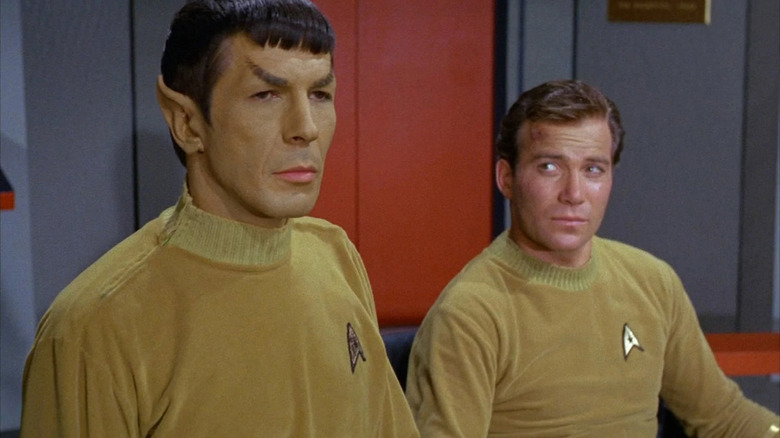
"You know. 1966? 79 episodes, about 30 good ones," said Philip J. Fry of "Futurama" to the jarred, floating head of Leonard Nimoy. This is his animated opinion, of course, but a better question isn't how many are good, but how many of the original "Star Trek" episodes are great . Would you believe 21?
Determining greatness is subjective of course. Popularity isn't a fair indicator of quality, and some fan favorites are guilty pleasures, while others are fun but defective in ways that knock them down from great to merely good. Any episode's overall quality depends on multiple factors — the uniqueness of the premise, the quality of the writing, the story beats, the characterization, guest stars, action, music, production values, and even visual effects.
Speaking of visual effects, we're not talking about the 15-year-old "remastered" CGI, which already look dated and cartoonish. We're going O.G. all the way. The criteria here is ranking these as the total package rather than the sum of their parts. With that in mind, here's a perhaps controversial list of the 21 greatest "Star Trek: The Original Series" episodes.
21. A Piece of the Action (Season 2, Episode 17)
Although humorous moments abound throughout the original "Star Trek," there aren't many outright comedy episodes. In fact, there are only three: "I Mudd," "A Piece of the Action," and "The Trouble with Tribbles." Most fans I know vote the straight "Tribbles" ticket, but that episode is merely cute-funny, whereas the over-the-top "A Piece of the Action" is actually genuinely funny. The script by Gene L. Coon is more absurd than "Tribbles" and features more comic business. The cherry on top was its helmer, James Komac, who was a gifted comedy writer and director of hundreds of episodes of shows including "Welcome Back, Kotter" and "Chico and the Man" (which he created).
This episode is almost a meta-commentary and spoof on the "Star Trek" schtick of "strange new worlds," which end up being monocultures thinly based on Earth's history. Here we see why the Prime Directive exists: An entire civilization has modeled itself on the popular mythos of Roaring '20s Chicago mobs. It's literally Planet Cosplay and an unintentional spoof of fandoms then and now. Two things keep it at this end of the list — it's shamelessly riffing on 1964's "Robin and the 7 Hoods," and it's almost irredeemably dumb. Fortunately, it's dumb fun, and fun enough to be among the best. "Right?" "Riiiiight."
20. Space Seed (Season 1, Episode 22)
You might be surprised that this comes in so low in a list of greats, but that it merits inclusion at all relies solely on the sheer screen presence and magnetism of its guest star. Khan Noonien Singh is an arrogant egotist and tyrant , but Ricardo Montalbán's confident performance makes him watchable. Minus him, the story defects would relegate this episode to merely "good." Many put this in their top 10, but I suspect that's because it basks in the reflected glow of its cinematic follow-up, "The Wrath of Khan."
The script is serviceable but unmemorable and commits the sin of making our heroes foolish instead of making Khan's intelligence and cunning the real danger. Kirk hands this unknown and suspicious character unfettered access to the ship's technical library on a silver platter, and historian Marla McGivers is a pushover who betrays all her shipmates because she's a fangirl of brutish dictators.
Weak story aside, the episode does have strengths. All the performances are good, and the story moves along at a brisk pace. There's memorable dialog, and McCoy really shines when he isn't cowed by Khan holding a scalpel to his neck. There's also some of the best miniature effects work on the show, going to the expense of a custom-made model of the Botany Bay. Montalbán is what makes it a best episode at all, but he alone can't elevate it.
19. The Conscience of the King (Season 1, Episode 13)
This least "Star Trek"-y of "Treks" scores points for being just that. The series premise allows it to be a semi-anthology, able to shift genres without breaking format, so one week it's a psychological drama about the duality of human nature, another time it's about cold war proxies or planet-killing doomsday machines by way of "Moby Dick" or — as in this case — a Shakespearean tragedy about mercy and revenge. Just as Hamlet must determine whether or not his uncle Claudius murdered his father, so must Captain Kirk determine if actor Anton Karidian is the man once known as Kodos the Executioner.
Writer Barry Trivers cleverly frames his story within the play that informs it, a bit of dramaturgical license that permits a more theatrical approach. Take, for example, this bit of dialogue from Lenore Karidian: "There's a stain of cruelty on your shining armor, Captain. You could have spared him, and me. You talked of using tools. I was a tool, wasn't l? A tool to use against my father."
This episode exemplifies a shadowy aspect of Kirk's affairs rarely discussed in how he weaponizes romance to get what he wants. The ultimate irony is that he plays Karidian's daughter, Lenore, in order to get close to her father, only to learn that she's been playing him. That it's so different is a double-edged blade that simultaneously makes it a best episode, but nowhere near the top. It was a great stretch for the show.
18. The Immunity Syndrome (Season 2, Episode 18)
This one barely edges out the not-dissimilar and more popular "The Doomsday Machine." Both feature the crew of a sister ship annihilated by a huge alien thing endangering life throughout the galaxy. But where "Doomsday" is a straightforward adventure story driven by an Ahab-like guest star, "Immunity" is more personal, as it features some great and properly motivated Spock and McCoy conflict.
Too often, Bones would goad Spock for no reason, but here, their back and forth is professional. We've got two scientists vying for an opportunity to study this alien organism, each feels himself the most qualified to take on what promises to be a suicide mission, and each, perhaps, is choosing to make the sacrifice rather than let the other die. But it's Kirk who has to make the final, heartbreaking choice of which of his friends to send. That's classic "Trek."
Given its budget and the visual effects tech of the time, "Star Trek" was rarely able to get across truly alien life forms, but this is a notable exception, and the conceit that the Enterprise must enter the alien entity as a virus infects a cell is a nice twist. The visual effects of the space amoeba thing are fabulous and weird, something the 2007 remastered CGI does not improve on.
17. Day of the Dove (Season 3, Episode 7)
The third season of "Star Trek" has no classic episodes, but a few come close. "Day of the Dove" is the best of the bunch. The simple premise of exploiting bigotry between our heroes and their Cold War counterparts, the Klingons, works better than it ought. If you want to look for a message, the alien entity that fuels the very hatred and violence it feeds upon can be read as a stand-in for the military-industrial complex, which fans the flames of conflict in order to sell weapons in a perpetual feedback loop. Alternatively, you can just take it for a MacGuffin.
The nefarious influence of the alien entity memorably amplifies the slightest biases of the Enterprise crew, and it's uncomfortable to hear blatant racism coming of out our noble heroes' mouths, especially Scotty's attack on Spock. Michael Ansara plays Kang as no mere mustache-twirling bad guy but as a shrewd enemy starship commander, an honorable warrior, and a fine opposite to Kirk. By turns personable, calculating, and violent, he's a model Original Series Klingon. Frankly, I'd rather watch him than Khan; your mileage may vary. It's got action. It's got character conflict for days. It's the best the third season has to offer, but it's not as great as the first- and second-season entries coming up.
16. Tomorrow Is Yesterday (Season 1, Episode 19)
The original "Star Trek" didn't play with time travel much, and when it did, the results were either very good or they were horrid, with the backdoor pilot "Assignment: Earth" being the low point. On the flip side, you've got "Tomorrow Is Yesterday," which features the most offbeat teaser of the series, following an Air Force F-104 interceptor, with the visual punchline that the bogie it's after is the USS Enterprise.
What follows is illogical as all get out, but the gimmick of the Enterprise being tracked as a UFO and having to undo the temporal damage it's done by being photographed and accidentally crushing that Air Force interceptor is great and the story milks it for all it's worth. No real depth here, but the fun is all in the plot events and reactions of the crew.
There's some great in-character stuff in the episode, including Spock's statement that he too doesn't believe in "little green men" and his one-star ranking of the Air Force film of the Enterprise as "bad photography." Kirk's playfully resigned responses to his Air Force interrogator are great too. And, hey, Sulu even gets to get off the bridge. The main weakness is the "how does that work?" ending gimmick of beaming people back into their own bodies. Great, but not a classic.
15. Balance of Terror (Season 1, Episode 14)
A fan favorite for good reason, "Balance of Terror" depicts the loneliness of command as Kirk tries to seek and destroy a marauding alien vessel without triggering an outright war. Seeing some of the "lower decks" types makes the Enterprise feel more real and lived-in and sells that Kirk's every decision has repercussions beyond the bridge. But it's Mark Lenard's perfectly pitched turn as the unnamed Romulan commander that's most memorable here. Torn over the ramifications of the performance of his duty, he's Kirk's equal in every way, and you can believe that he loses this battle not by dint of any personal failings but merely because his ship is outmatched by the much quicker and faster-firing Enterprise.
For 1966, the effects are great and largely still hold up. The Romulan ship is simple and distinctive, and the music is spot on. The main thing keeping it out of the top 10 is that it so baldly swipes elements of the films "Run Silent Run Deep" and "The Enemy Below," slapping pointed ears on the German Kriegsmarine story from the latter film, borrowing its war-weary commander and a subordinate fanatically loyal to their political leader. In "Arena," the show paid for the rights of the story it was cribbed from and credited the author. No such screen credit graces this obvious lift.
14. The Ultimate Computer (Season 2, Episode 24)
Kirk is infamous for offing overzealous computers (see: Landru in "Return of the Archons," Nomad in "The Changeling," and the androids of "I Mudd"), but his personal best computer kill is in "The Ultimate Computer." Here, he doesn't merely melt down the M5 Multitronic unit by confronting its flawed logic regarding its purpose; he aims a precise surgical strike at the chink he spots in its programming armor — appealing to the morality inherent in the memory engrams its all too human creator imprinted it with, causing it to reason it must die to pay for the sin of murder.
This episode is character-driven, with Kirk confronting his own redundancy and possible irrelevancy even as Spock and McCoy make their loyalty and friendship clear. Guest star William Marshall's turn as the deranged Dr. Daystrom is a standout, ranking among the best of the show.
All this drama is supported by some fine action, as M5 reduces a redshirt to a puff of smoke, photon torpedoes a robot ship, and then nearly destroys four sister ships of the Enterprise, actually killing the entire crew of one. Even the light ending — which often play as callous given the events which precede them in many episodes — is acceptable here because it's about Spock and McCoy, not Kirk. But it's still Kirk vs. the Computer, and those are never "Star Trek" at the very top of its game.
13. The Cage (Original Pilot)
Forget "The Menagerie" with its paper-thin envelope around the first pilot, repetitive courtroom scenes, and forced cliffhangers, all of which render it a solid but not great installment. On its own, "The Cage" is not just a great launchpad for what "Star Trek" is and would become but an imaginative and well-executed story in its own right. Gene Roddenberry's script is smart, with the atrophied Talosian aliens a satirical stand-in for TV audiences who might rather live other people's fantasies than experience adventures of their own. While it's a bit talky and static in places, when they're in action, it's great stuff — notably the laser cannon scene and Pike's illusory fight on Rigel VII.
Visually it's terrific. This was the most expensive episode of the series ever made, and it shows. The sets, costumes, makeups, and many special effects are top-notch for a show of the era particularly the matte shot of the Rigel VII fortress. The pacing's a bit loose, the characters don't pop due to the largely meh casting, and "THE WOMEN!" Number One and Yeoman Colt secretly wanting to bone the Captain is cringeworthy. However, guest star Susan Oliver's performance is the standout here, followed by Leonard Nimoy as Spock. Ultimately, it's just as well that the far more energetic William Shatner stepped in to replace Jeffrey Hunter's less-than-charismatic version of Captain Pike .
12. Arena (Season 1, Episode 18)
If any episode of "Star Trek" is truly iconic, this is it. The action set piece on Cestus III is the biggest of any in the series, with running and jumping and explosions galore, a redshirt vaporization, a detonating tricorder, and a photon torpedo-sque mortar. Once back on the Enterprise, Kirk's dogged determination to overtake and destroy the enemy ship demonstrates the obsessive nature of his character, but communication with his alien foe plants a seed of doubt which ultimately empowers him to practice what he preached in "A Taste of Armageddon: " We're human beings with the blood of a million savage years on our hands, but we can stop it. We can admit that we're killers, but we're not going to kill today. That's all it takes. Knowing that we won't kill today."
Kirk doesn't kill, and it saves the day. It lands here amongst the best because the story ends with the overused first-season gimmick of the godlike entity — the others being Gary Mitchell, Charlie-X Evans and his Thasian truant officers, Trelane the god-child, and the Organians — but the Metrons are more a plot device than anything. The Gorn is a great and worthy adversary, even as its slow-motion gestures are laughable. Spock hanging a lantern on Kirk's cannon-building is a bit much, but hey, he's the costar and has to do something.
11. Where No Man Has Gone Before (Season 1, Episode 3)
It might be a surprise seeing "Where No Man Has Gone Before" on this list, but despite the second pilot weirdness of different uniforms, series crew regulars appearing not at all (McCoy, Uhura) or in different jobs (Sulu is an astrophysicist), and Spock's not-quite-there characterization and more severe makeup, the core "Star Trek"-ness is there in spades. Kirk makes a risky decision in the first act and must deal with the building consequences for the balance of the show, finally shouldering personal responsibility for his decision in the worst way possible: In order to save his ship and crew, he's forced to kill a subordinate shipmate and friend.
The episode looks great (being far more expensive than any regular production episode), repurposes the planet set built for the even more expensive first pilot, and features more optical effects than would be the norm for a production episode. Most importantly, William Shatner's Kirk projects leading-man charisma of the sort that's arguably what sold the show. It also delivers on Gene Roddenberry's original high-concept pitch of a "'Wagon Train' to the stars," where stories would focus on strong guest stars interacting with the recurring cast. The script is not without its flaws, and had Gary Mitchell been a tad more likable, the drama would have played even better. Still, two thumbs way up.
10. A Taste of Armageddon (Season 1, Episode 23)
"New civilization" planet stories rarely yielded great episodes, often setting up straw man civilizations for Kirk to knock down, but this one bucks the trend with a story smart enough to rank among the best. Kirk vs. the Computer legendarily has Kirk talk the machine to death, but now and again, he goes for the direct approach. Here, the computers coldly run simulations and select innocents to die, and Kirk has zero compunction about blasting them, finally forcing two civilizations to finally attempt to negotiate peace after 500 years of a "war" where death has been made so neat and tidy they see it as a necessary evil rather than something to stop.
Goodies include Scotty's head-butting with Ambassador Fox, Kirk's arguments about war with Anan 7, and Kirk threatening to have the Enterprise rain destruction down on a planet that's not faced a real attack in centuries. The moral? Any war held at arm's length is mere statistics, something the American people had grown accustomed to until television thrust the reality of Vietnam into their living rooms each evening. That's a lesson we must learn over and over again in conflicts where we increasingly use long-range and smart weapons to strike people we never even see. It's a message as relevant today as when it was first aired.
9. The Corbomite Maneuver (Season 1, Episode 10)
Effectively the "third pilot" of "Star Trek," this was the first regular production episode to go before the cameras, and it had the luxury of a rehearsal day, a solid director, and a fine script. It even ends with a quintessential "Trek" twist: Our implacable foe ends up being an erstwhile friend. By rights, this should've been the first episode to air as it sets up the whole show, but it was nowhere near ready at the premiere, in part due to the sheer number of optical effects in post-production. Dr. McCoy is wonderful from his first appearance, and his camaraderie and professional conflict with Kirk set the stage for their entire relationship.
The weird flagship Fesarius is pure alien goodness, and the Balok puppet is iconic. Memorable business includes Sulu's countdown, Spock's logic and resulting lack of imagination, Scotty's comment about Spock's parents, and McCoy and Kirk's conflict over Bailey. A highlight is the briefing room scene, with its lived-in atmosphere with piles of tapes and empty cups of coffee showing instead of telling us how hard the crew has been working on their predicament. Likewise, the Enterprise feels like a real lived-in ship, with corridors bustling with the crew, something the show would lose as fixed costs increased and studio budgets didn't grow to match. It's one of the 10 best, held back only because it drags in some spots.
8. The Galileo Seven (Season 1, Episode 16)
Albeit loosely inspired by the 1939 survivor drama "Five Came Back," this episode charts its own course as Spock tries and fails to resolve a potentially lethal situation with logic alone. It's rare that adventure shows of the time would depict a lead character failing, but that's just what "The Galileo Seven" does.
As in "The Corbomite Maneuver," we are again shown that Spock's logic can serve as blinders that prevent him from seeing all the possibilities, even as he tells Scott, "There are always alternatives." As such, when they become stuck on a mysterious planet, he expects the giant natives to react rationally to a show of force and brings them right down on the party. He's likewise ill-equipped to deal with the emotional frailties of the crew under his command, especially the insolent and insubordinate Lt. Boma, memorably played by Don Marshall, later of "Land of the Giants."
The B-story with Kirk desperately trying to locate the lost shuttle against a ticking clock demonstrates the sorts of no-win scenarios a ship captain must face. The production scores visually for the full-size shuttlecraft, as well as the visual effects depicting it and its sister crafts' departure and return to the Enterprise hangar deck.
7. The Naked Time (Season 1, Episode 4)
The fourth episode aired, "The Naked Time" is the foundational character-building segment of the series, peeling away the surface of Kirk and Spock and revealing a bit of what makes them tick. It's also entertaining as hell, with a slow burn as the crew is at first blissfully ignorant of the inhibition-inhibiting compound brought aboard and then having to deal with the resulting chaos. Sulu's descent into madness is charming, and George Takei was always at his most charismatic when he got to play unhinged. Sadly, neither Uhura nor Rand's secret selves get explored, and poor Chapel is reduced to pining for Spock as her primary character trait for most of the series.
The only weak spot here is that the "science" part of science fiction went out of the airlock. A collapsing planet is as preposterous an idea as the notion that the Enterprise is forced to constantly alter its orbit to study it. But guest crewman Kevin Riley is fun, and Scotty gets two great lines here, the first being, "I can't change the laws of physics," and the second an example of technobabble that's simple and audience-friendly: "You can't mix matter and antimatter cold!"
6. The Devil in the Dark (Season 1, Episode 25)
"The Devil in the Dark" is unique for being the only one to open with no sign of the Enterprise or her crew. Effectively a redo of series opener "The Man Trap," this episode succeeds where its predecessor fails not merely because the crew act more rationally but because a narrative twist turns the titular "Devil" into a sympathetic character. The Kirk-Spock dynamic is on fine display here as Spock first wishes to capture the creature alive and Kirk wants it dead, but Spock's feelings for his captain override his desire for scientific knowledge the instant he believes Kirk is in danger.
Spock urges his captain to "kill it!" even as Kirk susses out that the creature may be more than a monster. This is the first instance of Spock mind-melding with a wholly alien life form, a gimmick that would be taken to preposterous extremes in "Star Trek: The Motion Picture." Leonard Nimoy's "pain!" emoting is a bit over the top even for the time and keeps the episode out of the top five. Otherwise, he and William Shatner display the chemistry that made the show work even when the scripts let them down. This script does not let them down.
5. Journey to Babel (Season 2, Episode 10)
This world-building episode fires on all cylinders and never misses a beat. If writers then or now needed a model for how to write "Star Trek," this is it, and it's hands down the best episode penned by Dorothy "D.C." Fontana. There's a story conflict as the Enterprise ferries quarrelsome ambassadors and their aides to the titular "Babel" conference over a matter of Federation business. There's an interpersonal conflict between not just Spock and his parents but also between Spock and Kirk and Bones over relinquishing command.
There's physical conflict as ambassadors brawl, one is murdered, and Kirk is ambushed and wounded. We meet lots of aliens, see a bit of galactic politics, and get a nail-biter of a finish as McCoy tries to perform delicate surgery while Kirk struggles to keep it together amidst attacks by a seemingly unstoppable, unknown ship.
Mark Lenard returns not as a Romulan but as Spock's Vulcan father, Ambassador Sarek, who picks up on Leonard Nimoy's Vulcan portrayal and crafts one uniquely his own. Memorable too is Reggie Nalder, whose burn-scarred face and Austrian accent accentuate his alienness in the role of the blue-skinned Andorian delegate Thelev and established Andorians as Federation members , who would not be explored on TV for decades. Spock's family drama is a bit conventional for an alien culture, and just a dash more of the Vulcan alienness we got in Ted Sturgeon's "Amok Time" would have made this perfect.
4. The Enemy Within (Season 1, episode 5)
With a script that takes a pinch of "Strange Case of Dr. Jekyll and Mr. Hyde" and adds a dash of "All About Eve," "The Enemy Within" really delivers on the "Star Trek" promise to be an "adult" show by exploring the uncomfortable idea that even the noblest have a dark side and that our shadow selves are necessary parts of being human. The scenes with Kirk, Spock, and McCoy crackle with intellectual and emotional tension, and Spock finding Kirk's condition so "fascinating" neatly propels the drama while hinting at his own duality. William Shatner's twin performances as the understated compassionate Kirk and the scenery-chewing "imposter" demonstrate his range.
A few missteps are the weird editing — where events happen out of order, such as when Spock states they have an intruder aboard long after they've established the transporter duplicated the dog-thing — Rand being expected to stand up for herself in front of her alleged attacker, Kirk, and the silliness of Spock reporting that the malfunctioning transporter duplicated the thermal heaters beamed down and not thinking to beam down blankets or other insulation to help keep the stranded Sulu and company from becoming human popsicles. Additionally, Spock's closing crack at Rand about the imposter's qualities was and remains cringeworthy.
3. Mirror Mirror (Season 2, Episode 4)
This is the poster child for episodes that manage to become classics despite the premise being as dumb as a box of rocks. Absolutely nothing about the scenario makes a lick of sense. There's a parallel universe where all the same people end up on the same ship despite having vastly different histories and a culture of assassination. The starships in both universes happen to be on the same planet and beaming the same four people at the exact same time, and our parallel-universe leaping characters and their barbaric counterparts somehow switch wardrobes — and presumably underwear — mid-transporter beam.
What saves it is the sheer entertainment value of this gaudier imperial Starfleet and the skewed versions of familiar regulars inhabiting it. Evil Sulu's a sweaty seducer, mirror Chekov is a back-stabbing opportunist, and bearded Spock was a meme before we knew we had memes. The best Uhura performance can be found here, and Nichelle Nichols should be remembered for this over that overrated and involuntary interracial kiss. The only thing that could have made it better was had Yeoman Rand been brought back as "the Captain's Woman." The big speech to mirror Spock about the illogic of waste is Kirk at his Kirkiest, and that's the perfect capper on a perfectly entertaining classic that ranks right near the top.
2. Amok Time (Season 2, Episode 1)
The Vulcan episode to rule them all is one of those rare world-building episodes of the original series, except here the strange new world is Spock's home planet. Vulcan civilization is memorably introduced in a most unexpected way — by demonstrating that the coolly logical Spock is anything but when it's time to swim upstream and spawn. However, Spock's mate-to-be, T'Pring , employs the logic our Vulcan hero adores in order to escape her obligations to him and make her own choices.
Everything about the scenes on Vulcan works splendidly, from matriarch T'Pau's officiating and T'Pring's challenge to the big Kirk-Spock battle. Okay, and the wonderful and memorable OTT music is the icing on the cake. The first half on the Enterprise has some nice comic moments, as well as some solid Kirk-Spock-McCoy interaction, but as with many episodes where a mystery is involved, the tension of the first half doesn't play quite as well on repeat viewings.
Fortunately, the drama and conflict on Vulcan are top-notch and hold up. The punchline in sickbay is a classic because the bigger the dramatic tension, the bigger the comic release, and given all the action on the planet, the funny tag feels totally earned for a change.
1. The City on the Edge of Forever (Season 1, Episode 28)
No surprise here, as it tops a great many lists, but "The City on the Edge of Forever" excels not only because the core drama is compelling but because of the care with which it was put together. The most expensive regular production episode of the series, all the money is up there on the screen, from the period costumes to the backlot shooting, new sets, stock footage, and the flashing Guardian time donut. William Shatner, Leonard Nimoy, and DeForest Kelley are all in fine form here. Guest star Joan Collins isn't great, but she's fine.
Story-wise, the fish-out-of-water situation, the incredibly high stakes, and the crushing inevitable tragedy make this the exemplary segment. Even gutted by ham-fisted staff rewrites by the "Trek" staff (in my opinion), Harlan Ellison's core story premise remains moving in spite of the on-the-nose sermon by Edith, the racist joke at Spock's expense, and the complete absence of the tragic Trooper character on whom the irony of who amongst us "matters" hinged. Kirk's episode-closing "let's get the hell out of here" was not any kind of TV first, but it was the perfect minimalist button that the story needed. What more was there to say?
The Top 100 best Star Trek episodes ever (according to IMDb)

1. Star Trek: The Next Generation
The inner light.

2. Star Trek
The city on the edge of forever.

3. Star Trek: The Next Generation
The best of both worlds: part 1.

4. Star Trek: Deep Space Nine
Trials and tribble-ations.

5. Star Trek: The Next Generation
The best of both worlds: part 2.

6. Star Trek: Deep Space Nine
In the pale moonlight.

7. Star Trek
Mirror, mirror.

8. Star Trek: The Next Generation
Yesterday's enterprise.

9. Star Trek: Deep Space Nine
The visitor.

10. Star Trek: The Next Generation
The measure of a man.

11. Star Trek: Deep Space Nine

12. Star Trek: The Next Generation

13. Star Trek
Balance of terror.

14. Star Trek: The Next Generation
Cause and effect.

15. Star Trek
The trouble with tribbles.

16. Star Trek

17. Star Trek: Deep Space Nine
Call to arms.

18. Star Trek: The Next Generation

19. Star Trek: Voyager
Blink of an eye.

20. Star Trek: Voyager

21. Star Trek: Deep Space Nine
The way of the warrior.

22. Star Trek: Enterprise


23. Star Trek: The Next Generation
Chain of command, part ii.

24. Star Trek: Deep Space Nine
The die is cast.

25. Star Trek
The doomsday machine, more to explore, recently viewed.
The 10 best Star Trek: The Original Series episodes of all time
Boldly go where no binge-watcher has gone before.
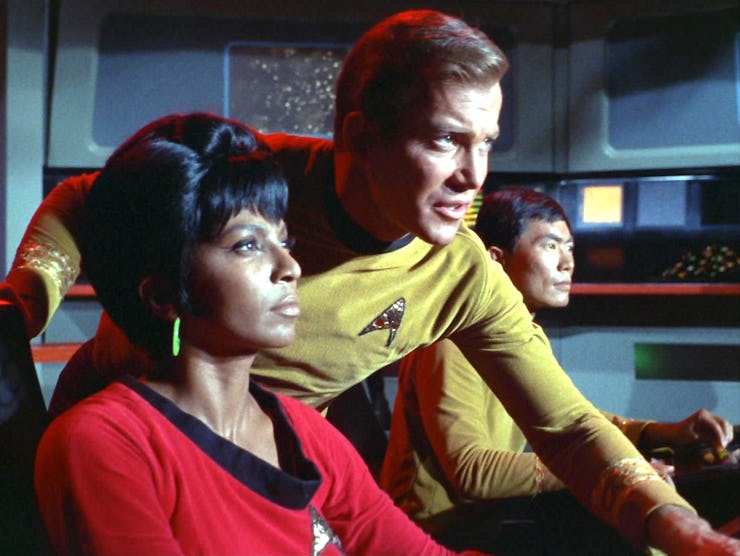
Star Trek took televised sci-fi mainstream.
That isn’t hyperbole. It’s historical fact. While shows like The Outer Limits, The Twilight Zone and Lost in Space preceded Star Trek , none of those shows broke through and created a fandom as widespread and enduring as the original adventures of the starship Enterprise .
Since 2011, Netflix has made Star Trek: The Original Series available for streaming in the US. But that era will end on September 30, 2021.
If you’re a sci-fi fan, or even a Star Trek fan who has never really delved into The Original Series , this is your last chance to watch the show on Netflix. Out of the 79 installments in TOS , which episodes should you actually binge?
To get a good sense of what The Original Series is actually like, here are 10 essential episodes. These might not be everyone’s “best” episodes of TOS , but if you watch these ones in this exact order, it’s the fastest hack to get at what all the Trekkie fuss is about. Only mild spoilers ahead for Star Trek: The Original Series .
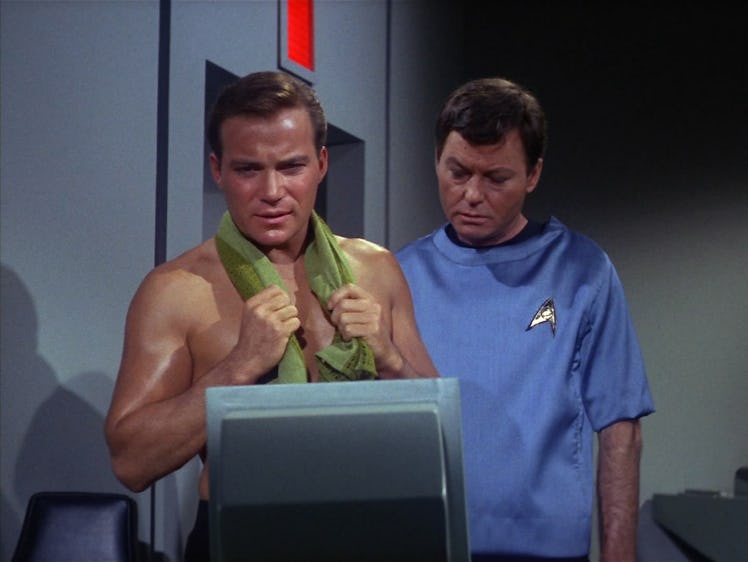
Kirk and Bones get ready to boldly go.
“The Corbomite Maneuver”
On Netflix: Season 1, Episode 11
Netflix wants you to start watching TOS with “The Cage.” Resist! This is not a great way to start the series.
“The Cage” was an unaired pilot for Star Trek , later retconned into a flashback within the episode “The Menagerie.” While some fans may argue you’ll want to watch “The Cage” to get the backstory of the series, starting with “The Cage” will just confuse you as to why people like this show. Tonally, it’s nothing like the rest of TOS . And the cast, other than Leonard Nimoy as Spock, is totally different.
For this reason, start with “The Corbomite Maneuver.” Why? Well, even though it was the 10th episode ever aired, this episode was the first regular episode ever filmed. Unlike the two pilot episodes (“The Cage” and “Where No Man Has Gone Before”) the actors in this episode are, for the most part, in the roles we know and love them for. The episode begins with Spock saying something is “fascinating” and then, after the title credits, Kirk is walking around without his shirt. The vibe of this episode is amazing, the tension is excellently handled, and the final twist is utterly absurd. This is what classic Trek feels like.
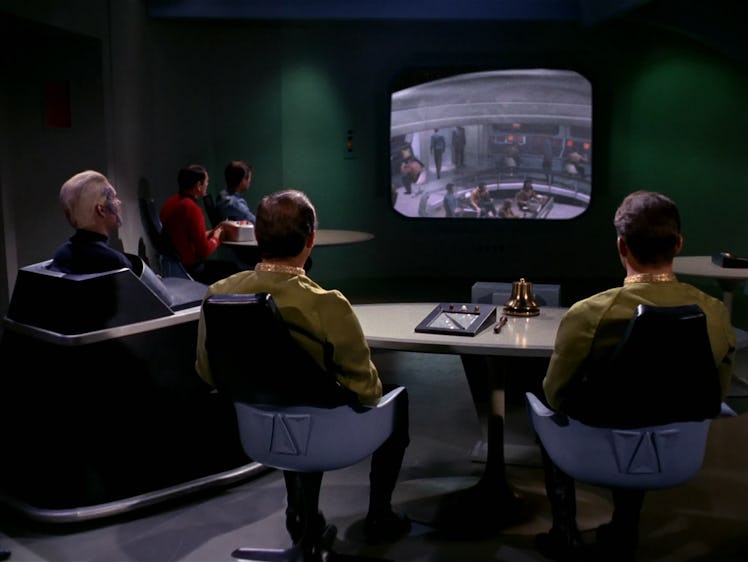
The earliest instance of people on Star Trek watching Star Trek.
“The Menagerie Parts 1 and 2”
On Netflix: Season Episodes 12 and 13.
Here’s where you can get your dose of “The Cage” and fully understand Spock’s relationship to his captain before Kirk: Captain Christopher Pike. Although this is a two-part episode, the time pretty much flies by.
Because Strange New Worlds comes out in 2022, this story is essential to understanding where Spock was before TOS , not to mention who the hell Number One is. The way this episode frames “The Cage” in the context of the regular series is also super-smart; basically, the regular characters watch parts of another episode of Star Trek.
Also, across the franchise, any Star Trek episode that involves a courtroom drama of some kind is usually a winner. Weirdly, combined with “Amok Time,” this episode might lead you to believe that Spock tries to hijack the Enterprise all the time. He doesn’t. But it sure seems that way.

Spock being awesome in the phaser control room.
“Balance of Terror”
On Netflix: Season 1, Episode 15
Everyone loves to talk about the Klingons in Star Trek , but before the Klingons were ever introduced, the first and best big Trek baddies were the Romulans. As episodes of TOS go, “Balance of Terror” is tightly plotted and emotionally affecting.
Because long-time fans take this episode for granted, we tend to forget about the innovative reveal of the Romulans in general. If you don’t know why the reveal about the Romulans is huge, I won’t spoil it here. Let’s just say it was very gutsy for TOS to create an evil empire that had very close ties to one of its greatest heroes. Also, the slow-burn spaceship battles absolutely slap.
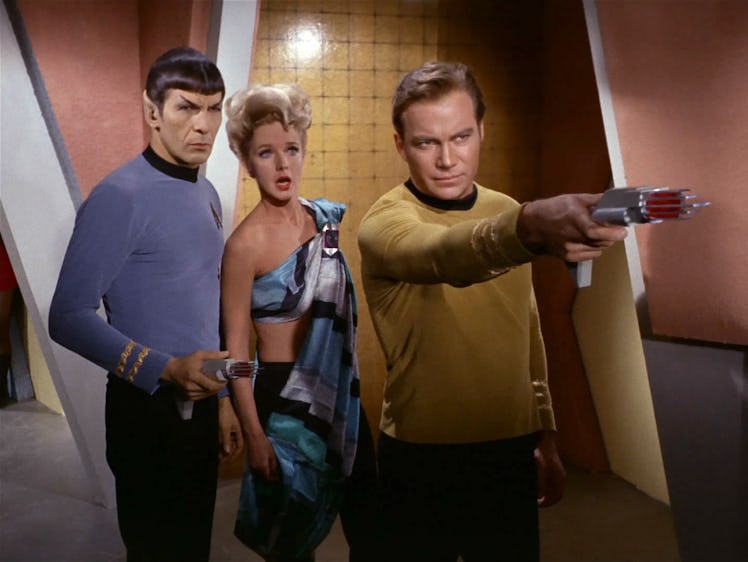
Don’t mess with Kirk.
“A Taste of Armageddon”
On Netflix: Season 1, Episode 24
This is a bit of a sleeper episode of TOS , and it’s massively underrated. Almost every good thing about classic Star Trek happens in this episode. Revealing the premise is a bit of a cheat, but let’s just say the plot involved Kirk and Spock fighting against a culture totally reliant on algorithms and automation.
The twist in this episode is all about what things this particular culture has automated. And when Kirk and Spock figure the culture’s secret, the space sh*t hits the fan big time.
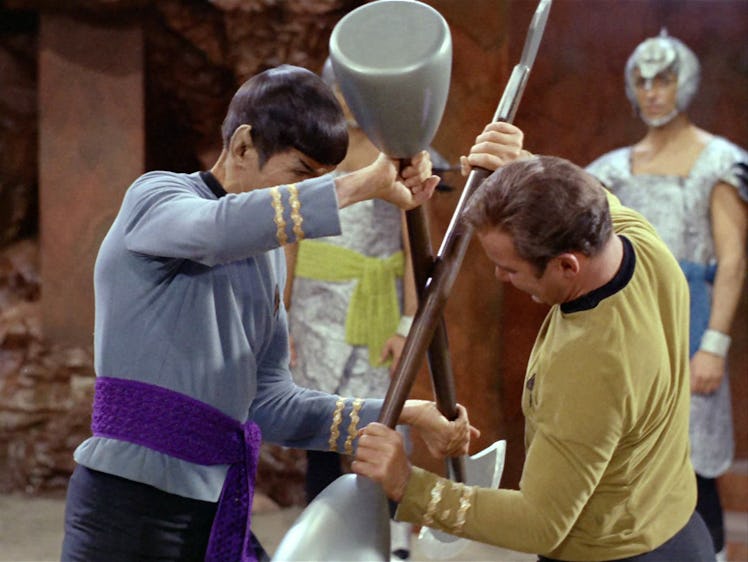
Kirk and Spock don’t always fight to the death, but when they do, they do it in style.
“Amok Time”
On Netflix: Season 2, Episode 1
A classic. You already probably know that Spock and Kirk are supposed to fight to the death in this one. But if you don't know why, exactly, this episode will blow you away. This is the first time we get “live long and prosper,” and a ton of background on the planet Vulcan. From Discovery to the reboot movies , a ton of Trek flows from this single episode.
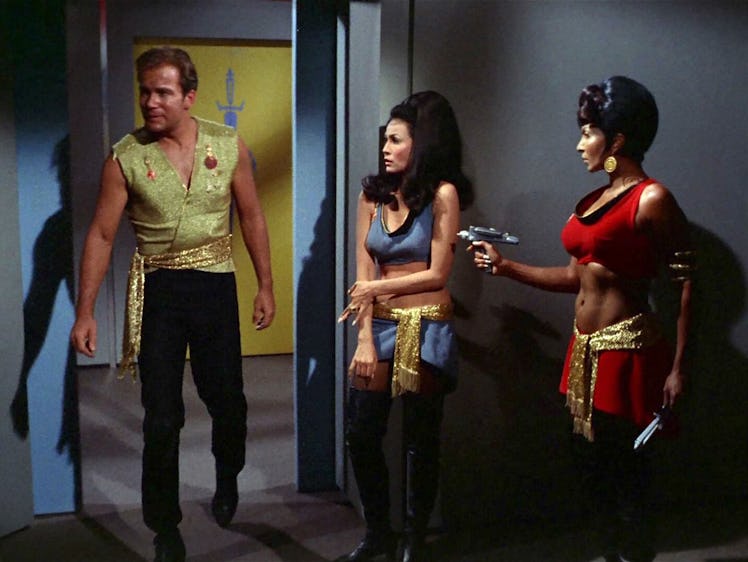
There’s a lot of ass-kicking in this episode. You’ve been warned! It may be too awesome to handle!
“Mirror, Mirror”
On Netflix: Season 2, Episode 4
In The Original Series , this one episode was the only visit to the evil universe in which Starfleet is basically a conquering force, and Spock has a little goatee. The Mirror Universe returned big time in both Deep Space Nine and Discovery , and all the rules of that hyperbolic dimension were established here. This episode is over-the-top and full of heart, two elements that made TOS the memorable and charmingly upbeat franchise launcher it was. But seriously, this episode is very over the top. Be ready.
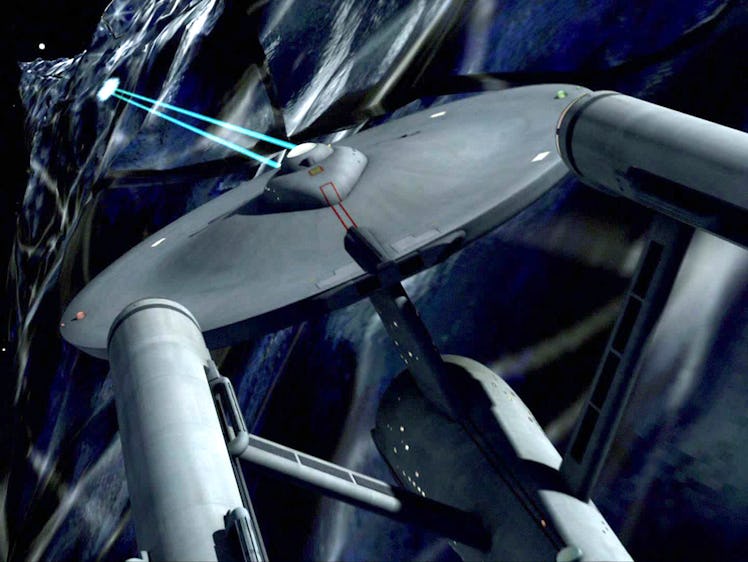
The Enterprise versus the Star Trek version of the Death Star.
“The Doomsday Machine”
On Netflix: Season 2, Episode 6
As the title suggests, the Enterprise faces off against a giant automated weapon even more powerful than the Death Star! When this episode first aired in 1967, the titular “Doomsday Machine” didn’t look very cool.
However, the remastered version of this episode (which is the Netflix version) looks fantastic. Plus, in this episode, you get another Federation starship, the USS Constellation ! Finally, although The Wrath of Khan calcified the franchise’s obsession with Moby Dick , that tradition started right here.

Uhura meets the first tribble. Watch out!
“The Trouble With Tribbles”
On Netflix: Season 2, Episode 15
You’ve heard of this one. There are these fuzzy little balls called tribbles, and they’re all over the place. Although the kitsch in this episode is cranked all the way up to eleven, the episode totally holds up. Come for the tribbles, but stay for Kirk’s awesome cutdowns throughout the entire episode. A lighthearted romp that is a classic Trek outing for a reason. Also, the Klingons are silly AF in this one.
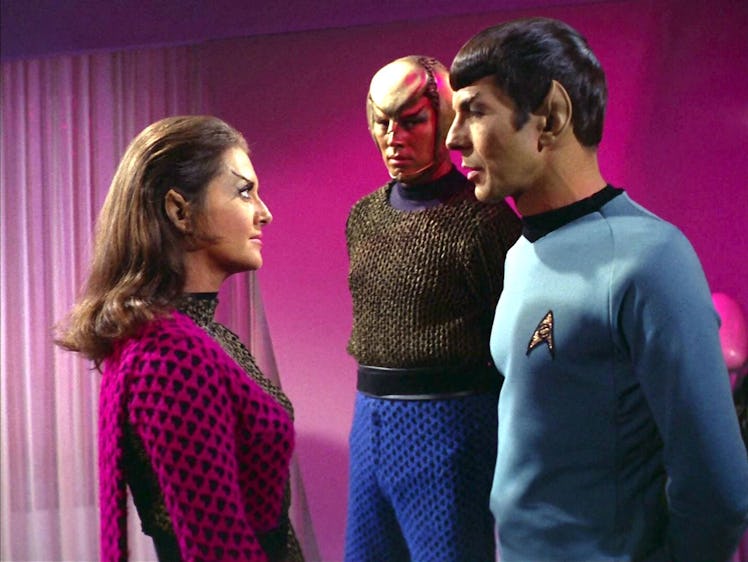
Spock and the Romulans.
“The Enterprise Incident”
On Netflix: Season 3, Episode 2
Season 3 of TOS is often derided by hardcore fans, and sometimes for very good reasons. Overall, the batting average of TOS Season 3 is fairly low compared to the previous two seasons.
However, the excellent espionage episode “The Enterprise Incident” is not only super-fun but also a semi-direct sequel to “Balance of Terror.” This list is biased in favor of the Romulans over the Klingons, and this is one Romulan episode that delivers.
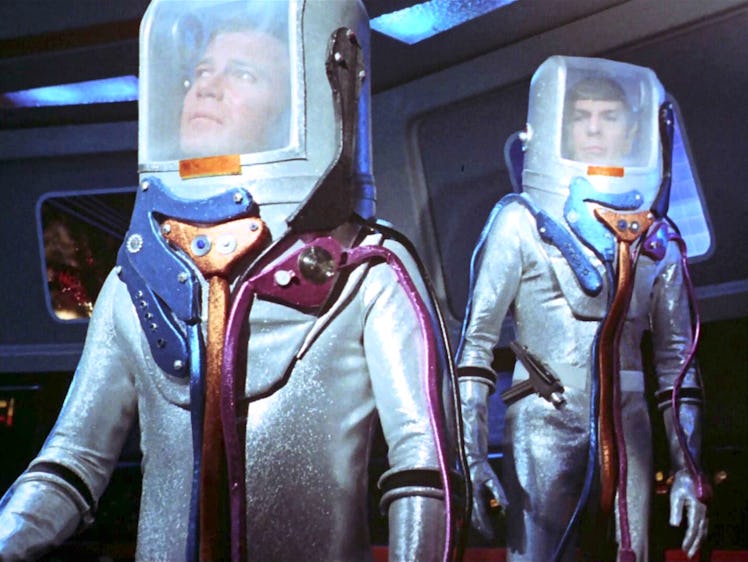
Kirk and Spock rock the best spacesuits in all of Star Trek.
“The Tholian Web”
On Netflix: Season 3, Episode 9
Perhaps not the most tightly written episode of TOS , “The Tholian Web” is beautiful from a visual standpoint. From the zany all-silver spacesuits to the concept of tiny ships weaving an energy web around the Enterprise , to a certain character haunting the crew members as a space ghost, this episode has it all.
Don’t think about the plot too much. Just embrace the gonzo visual sci-fi aesthetic of classic Trek, and you’ll have a great time. As a bonus, “The Tholian Web” later became a backdoor canon Rosetta Stone for two episodes of Enterprise and nearly half of Discovery Season 1.
There’s obviously a lot more TOS to love and enjoy, so if you are curious about other great episodes after you binge these ten, think about hitting up: “The Devil in the Dark,” “The City on the Edge of Forever,” “The Naked Time,” “Shore Leave,” “Arena,” “Journey to Babel,” “A Piece of the Action,” “A Private Little War,” “The Galileo Seven,” “For the World Is Hollow and I Have Touched the Sky,” and “ All Our Yesterdays.”
Star Trek: The Original Series is streaming now on Netflix and leaves on September 30, 2021. It also streams on Paramount+ from now until presumably the heat death of the known universe.
This article was originally published on Sep. 18, 2021
- Science Fiction
- Stranger Things Season 5
- Deadpool and Wolverine
- The Batman 2
- Spider-Man 4
- Yellowstone Season 6
- Fallout Season 2
- The Last of Us Season 2
- Entertainment
The 10 best Star Trek: The Original Series episodes, ranked
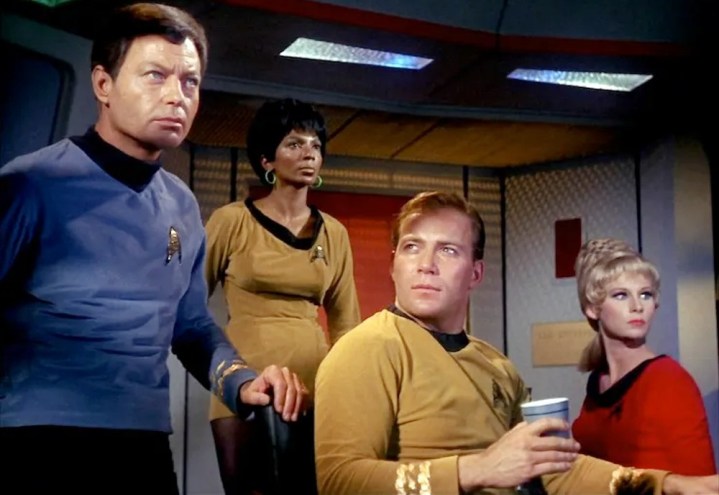
It’s hard to imagine today, but back in the late 1960s, the original Star Trek was not considered a hit. The ambitious science fiction series was constantly on the brink of cancellation and was cut short only three years into its planned five-season run.
10. Mirror, Mirror (season 2, episode 4)
9. a taste of armageddon (season 1, episode 24), 8. the menagerie, parts i and ii (season 1, episodes 12 and 13), 7. the doomsday machine (season 2, episode 6), 6. the corbomite maneuver (season 1, episode 11), 5. the devil in the dark (season 1, episode 26), 4. the trouble with tribbles (season 2, episode 15), 3. where no man has gone before (season 1, episode 4), 2. the city on the edge of forever (season 1, episode 29), 1. balance of terror (season 1, episode 15).
However, it’s important to put Trek ’s apparent failure into historical context as, given that most markets in the U.S. had only three television channels to choose from, even a low-rated show like Star Trek was being watched by about 20% of everyone watching television on a Thursday night, or roughly 10 million households. This year’s season of HBO’s Succession was viewed by roughly 8 million households a week , which makes it a hit by today’s standards. Star Trek ’s audience only grew once it went into reruns in the early 1970s, and by the time Star Trek: The Motion Picture hit theaters in 1979, it was a genuine cultural phenomenon. Today, the Star Trek franchise is considered one of the crown jewels of the Paramount library.
Though arguably outshined by its most prosperous spinoff, Star Trek: The Next Generation , Star Trek: The Original Series holds up remarkably well for a vision of our future imagined nearly 60 years in our past. It’s a space adventure series that tackles social or political issues from what was, at the time, a daring and progressive perspective informed by the contemporary civil rights movement, sexual revolution, and backlash against the Vietnam War. Conveying these values through fanciful science fiction didn’t only allow its writers to get away with a lot of subversive messages, it also delivered them in a way that remains fun to watch decades later — fun enough that fans are willing to forgive when its ideas, or its special effects, crumble under modern scrutiny.
These 10 episodes, however, unquestionably stand the test of time, and thanks to the continuity-light nature of mid-20th century television, any one of them could be your first Star Trek episode. (Be aware, however, that the order in which classic Trek episodes are listed varies depending on the source. For our purposes, we’re using the numbering from streaming service Paramount+ .)
Even if you’ve never seen an episode of Star Trek , you’re bound to be at least a little familiar with Mirror, Mirror through cultural osmosis. In this 1967 classic, Captain Kirk (William Shatner), Dr. McCoy (DeForest Kelley), Lt. Commander Scott (James Doohan), and Lt. Uhura (Nichelle Nichols) are accidentally transported to an alternate universe, where they encounter dastardly evil versions of their beloved shipmates. Instead of the benevolent United Federation of Planets, this ship serves the fascist Terran Empire, which threatens to annihilate a peaceful planet for refusing to submit to itsrule. Our heroes are forced to pose as their evil counterparts while they search for a way home and try to avert the genocide they’ve been ordered to perform.
This all sounds heavier than it is — like much of classic Trek , Mirror Mirror is very camp, with brightly colored costumes, over-the-top performances, and a general sense of fun. The cast is clearly having a ball playing the wicked versions of their characters (or playing the good versions of their characters playing the wicked versions), and it’s no wonder why multiple future incarnations of Trek would return to the Mirror Universe, usually for wacky adventure episodes. (For a more grim and brutal take on this same concept, visit the back half of Star Trek: Discovery ’s first season.) However, Mirror, Mirror still comes complete with Trek ’s famous humanist optimism, as Kirk tries to convince this universe’s menacing, bearded Spock (Leonard Nimoy) that regimes ruled by fear are unsustainable and, therefore, illogical. Given enough time, peace and cooperation will always win out over hate and violence.
A Taste of Armageddon may not appear on many “Best Of” lists, but it’s 100% pure, uncut Star Trek . In this episode, Kirk and company visit Eminiar VII, a seemingly peaceful planet that is, in fact, embroiled in a centuries-long war with a neighboring world. Rather than fire actual bombs at each other, the combatants conduct simulated attacks, determine the hypothetical death toll, and then order the “dead” citizens to report to disintegration chambers. When Kirk and his landing party are recorded as casualties, they decide to put an end to Eminiar VII’s supposedly “civilized” method of warfare.
While Kirk arguably has no right to interfere with how this sovereign planet conducts its affairs, the point of A Taste of Armageddon is to reflect on America’s attempt to make constant military conflict more palatable, or even invisible to the average American. Or, in a larger sense, it’s a commentary on the ease with which a culture can become accustomed to death and violence, so long as it’s part of an established routine. Because these simulated bombings leave homes, industry, and even the military infrastructure itself totally unharmed, it’s easy to forget that Eminiar VII is even at war — that is, until it claims your life or the life of someone you love.
When even these losses are framed as necessary sacrifices to maintain normalcy, it minimizes the incentive to make peace. Kirk (and, by extension, writers Robert Hamner and Gene L. Coon) argues that war is revolting no matter how much you dress it up, and that it must be brutal, terrifying, and omnipresent for all involved, or else it will never stop. The past half-century of perpetual U.S. military intervention abroad has proven this thesis to be chillingly accurate.
If you’re watching Star Trek on Paramount+, you’ll notice that the episode it has listed as “season 1, episode 1,” The Cage , isn’t exactly the show you were expecting. Instead of the famous Captain James T. Kirk, the USS Enterprise is under the command of Captain Christopher Pike (Jeffrey Hunter), and apart from Mr. Spock — who smiles?! — the rest of the crew is also unfamiliar. That’s because The Cage is Star Trek ’s original pilot episode, which was rejected by NBC, leading to a second pilot being commissioned with a new cast and modified tone. The Cage wouldn’t air as its own episode until 1988, but during production of Star Trek ’s first season in 1966, a budget crunch led to writer/creator Gene Roddenberry repurposing footage from the already-completed pilot into a new script in the form of flashbacks.
This fiscally minded decision endowed Star Trek and its characters with a history, instantly making the universe a bigger and more interesting place. The two-part Menagerie sees Spock, the only remaining character from the original cast, commandeer the Enterprise for the sake of its previous captain, Christopher Pike. On the way to a forbidden planet, Spock uses mysterious footage from an adventure 13 years in the past to explain his rash actions.
If you’ve already watched The Cage , then The Menagerie will seem like a glorified clip show, in which Kirk and company spend half the runtime watching a previous episode. However, before the streaming era, The Cage was usually the last episode of The Original Series that a fan would see, rather than the first. In recent years, however, The Cage and The Menagerie have taken on a new role, as bookends to the adventures of Christopher Pike, as portrayed by Anson Mount on modern spinoff Star Trek: Strange New Worlds . Strange New Worlds (as well as the second season of Star Trek: Discovery ) take place after The Cage , but before The Menagerie , allowing us to get to know Kirk’s predecessor in his own context, as well as developing the bond between Pike and Spock that will eventually drive the Vulcan to mutiny. Even without any of this context, however, The Menagerie is an exciting two-hour event, an eras-spanning mystery that will make you wonder why NBC passed on the Star Trek pilot in the first place.
Due to the production constraints of 1960s television, the original Star Trek didn’t often aim for large-scale, awe-inspiring space action. The Doomsday Machine is the closest that classic Trek ever came to “epic,” and as compelling a story as it is, it’s also Exhibit A as to why such a thing was impractical with the resources available. Though its original effects required no small amount of ingenuity (they couldn’t afford to give their Enterprise model battle damage, so they bought one off the rack from a toy store and distressed it), the results look mighty corny on a modern high-definition television.
Still, the episode gained fame as boasting the largest-scale action of the series, as the Enterprise teams up with her badly damaged sister ship, the USS Constellation, to take on a huge planet-eating weapon. It also presages a theme that would become common in Star Trek feature films , as the Constellation’s grief-stricken Commodore Matt Decker (guest star William Windom) embarks on a foolhardy quest for revenge against the monster that bested him. (Trek would revisit Herman Melville’s Moby-Dick in Star Trek II: The Wrath of Khan and Star Trek: First Contact .)
The episode still works in a cheesy B-movie sort of way, which some fans would argue is the way it should still be enjoyed. However, when the series was remastered for high definition in the mid-2000s, the decision was made to recreate most of the special effects shots for the series using modern technology, since the originals were never expected to hold up to modern standards. Most of these recreations are very faithful, to the extent that uninitiated viewers might not even realize they’d been replaced. In the case of The Doomsday Machine , however, the producers and effects artists returned to the episode’s original script and attempted to realize writer Norman Spinrad’s initial vision for the space battle sequences. The team at CBS Digital doesn’t sacrifice the overall aesthetic of the series, but they do give us a peek at what The Doomsday Machine — and by extension, the entire Original Series — might have looked like with a feature film budget.
There may be no better introduction to the character of James T. Kirk than The Corbomite Maneuver . The first episode produced after the series was picked up (though it didn’t air until later in the season), The Corbomite Maneuver finds the Enterprise at the mercy of a massive alien vessel and accused of trespassing in its territory. Unable to outrun or outgun his mysterious adversary, Kirk does what he will later become famous for doing — he cheats. Or, rather, he changes the conditions of the contest from one of technological superiority to one of cunning and guile. In the process, we get to learn a bit about how each of the main characters handles the intense stress of a seemingly hopeless scenario, contrasted against the more relatable Everyman Lt. Bailey (guest star Anthony Call). Though the action rarely leaves the bridge of the Enterprise, it is, in its own way, one of the most thrilling episodes of the series.
Moreover, The Corbomite Maneuver sets the tone for Star Trek as a series. It’s an hour of adventure that is punctuated by moments of thoughtful introspection, warm friendship, and corny jokes. Its depiction of Starfleet and the Enterprise are clearly inspired by military tradition, but the message of the episode is one of compassion and patience rather than conquest. These are scientists, not soldiers, and while they experience fear and doubt, none of their human frailties are a match for their curiosity. If this is what the future of humanity looks like, we want to be a part of it.
When Star Trek is running on full thrusters, it is equal parts silly and profound. In The Devil in the Dark , the Enterprise is sent to the aid of a mining colony where workers are being hunted and killed by an unstoppable monster made of rock. We know that the monster is made of rock because the characters say so; It looks a lot more like it’s made of spray-painted Styrofoam and a shag rug. But as the tension rises and the mystery deepens, the goofiness of the rock monster becomes irrelevant, or even a boon to the story.
Though it begins as a hunt for a merciless alien creature, The Devil in the Dark becomes a story about prejudice and the universality of what we (in our limited earthly experience) would call “basic human rights.” This message is conveyed through cheesy 1960s TV production values and some very hammy acting, but the results are pure and unpretentious, the sort of storytelling that is equally impactful on a jaded adult and a wide-eyed child.
Here in the post-post-postmodern 2020s, we’re all total pros at deconstructing genre tropes. The practice of subverting the audience’s expectations as to what kind of story they’re watching or who the good guys and bad guys are wasn’t new in 1967, either, but in the sci-fi film and television of the era, the big scary monster is usually just a big scary monster. The Devil in the Dark exemplifies one of Star Trek ’s most enduring themes: that the unknown might seem terrifying, but if you take the time to understand it, it’s actually beautiful.
Star Trek is always science fiction, but its format offers a lot of flexibility in terms of how to interpret that genre. Even within the course of a single series or season, most Star Trek shows alternate between a variety of tones and secondary genres, from grim political drama to steamy romance, or in the case of this episode, kooky workplace comedy. The Trouble with Tribbles pits Captain Kirk and his gallant crew against their most stubborn foe yet — bureaucratic red tape. Assigned to look after a container of grain that Federation administrators insist is gravely important, the Enterprise becomes entangled in a very silly misadventure involving an invasive species of adorable, self-replicating furballs. For a captain accustomed to dealing with high-stakes diplomacy and galactic defense, this is his worst workweek ever.
As lousy a time as Kirk is having, The Trouble with Tribbles is tremendous fun. It is neither the first, nor the last broadly comedic episode of Star Trek , but it is the gold standard by which all Trek comedies are measured. Like any good Trek, it has stakes, a fun science fiction premise, and charming moments of character, but everything is set just a little bit askew, and the characters have noticed. It isn’t parody, it’s situation comedy, only a situation that you’re unlikely to find yourself in unless you’re the crew of a Federation starship. Almost every subsequent Trek series would chase that Trouble with Tribbles heat at least once ( Star Trek: Lower Decks is basically The Trouble with Tribbles: The Series ), with varying levels of success, but the original remains an untouchable classic.
After The Cage was rejected by NBC, Desilu Studios (under the leadership of comedy queen Lucille Ball herself) took a second swing at the series, with a new cast and a faster paced action-adventure story. This second pilot, Where No Man Has Gone Before , introduces William Shatner as Captain James T. Kirk, as well as George Takei as Lt. Sulu, James Doohan as Scotty, and Leonard Nimoy’s new, more stoic interpretation of science officer Spock.
The episode sees Kirk’s friend and mentee, helmsman Gary Mitchell (guest star Gary Lockwood), bombarded with cosmic radiation that grants him increasingly godlike powers. As Gary grows more dangerous and cruel, Kirk must weigh his love for his friend against his duty to his crew. The scenario immediately establishes the dynamic between Kirk and Spock (compassionate leader versus his coldly practical advisor), though Spock’s regular debate partner, the emotionally driven Dr. McCoy (DeForest Kelley), would not appear until Trek was ordered to series.
Where No Man Has Gone Before is a little less fun and colorful than the episodes that followed, with a tone more closely resembling heady 1950s sci-fi films like Forbidden Planet or The Day the Earth Stood Still . In a way, it’s the classic Trek episode that feels the most like Star Trek: The Next Generation ; It’s talky, deliberately paced, just a little bit sterile. In Where No Man Has Gone Before , the galaxy is not only wondrous, but also eerie and unsettling. Had this been the tone the series stuck with, it might not have become a global sensation, but as a single episode, it stands out as one of the very best.
To some Trekkies, ranking The City on the Edge of Forever anywhere but at No. 1 is unthinkable. This time travel tale – written by sci-fi author Harlan Ellison and then heavily revised by Trek story editor D.C. Fontana — won Star Trek its first Hugo Award, and is widely considered to be the finest hour in the history of the series, if not the franchise as a whole. The episode’s legendary status is well-deserved, but we don’t quite have the heart to declare it the ultimate Star Trek episode, on account of how little of it takes place in the 23rd century or aboard the Starship Enterprise. The City on the Edge of Forever is an outlier, and as such, naturally stands apart from the pack, giving it an edge in any conversation about Star Trek . Its placement here at No. 2 is sort of a counter to that advantage.
Make no mistake, however — despite mostly being set in New York in the year 1930, City on the Edge is Star Trek to its core. Sent back in time to correct an accidental alteration of Earth’s history, Kirk and Spock take up residence in a homeless shelter run by idealistic philanthropist Edith Keeler (guest star Joan Collins). Keeler turns out to be the key historical figure whose destiny must be fulfilled, but there’s a problem — Kirk has fallen in love with her. This romance complicates the mission, as Kirk and Spock are confronted with a grave moral dilemma with their entire reality hanging in the balance. Keeler is a visionary who believes in the beautiful future that Kirk calls home. But, in order for that future to exist, must something terrible be allowed to happen in her present? It’s an emotionally gripping tale that, if it had been told on a modern television show, would have changed its characters forever.
Star Trek is built on a central contradiction. It’s an adventure series about officers in a fleet that we are told, unconvincingly, is not a military organization, aboard a vessel that carries enough firepower to demolish a continent. It’s a show about peace in which things have a habit of blowing up. To reconcile this cognitive dissonance, one need only look to this key episode of The Original Series , Balance of Terror . In this early chapter, the Enterprise witnesses an Earth base being destroyed by an old enemy, the Romulan Empire. The Romulan ship has the ability to become invisible both to scanners and the naked eye, and attempts to escape to its own side of the neutral zone between their two territories before it can be apprehended.
The Enterprise is ordered to capture or destroy the Romulans before they make it home. Whether or not they succeed, there may be war. Kirk has his orders, and as we soon discover, so does the Romulan commander (guest star Mark Lenard), who is no happier about this turn of events than Kirk is. Throughout the episode, we cut back and forth between the action on the Enterprise and aboard the Romulan vessel, as two keen military strategists attempt to outmaneuver each other and stay alive, both locked in a struggle they’d rather had never begun.
Balance of Terror is a sci-fi twist on a submarine battle, but more than that, it’s a commentary on war, the rivalries between nations, and the wounds and prejudices they create. The Enterprise isn’t loaded with photon torpedoes because Starfleet is itching for a fight — it’s armed because sometimes it has to be, and when Kirk and his crew ride into battle, there’s nothing glorious about it. On the other side of any conflict is a person or people who have their own mission, their own values, and perhaps even their own reservations about fighting. It is not possible to avoid every fight, to preempt every war with diplomacy. But when blood is shed, there is no victory and there are no winners. There is tragedy, and there are survivors. And, finally, there’s the hope that the next time these two nations clash, they’ll be a little more willing to talk to one another.
Editors’ Recommendations
- 10 best Star Trek: Discovery episodes, ranked
- 10 best Planet of the Apes movies, ranked
- 10 best movies of 2024 so far, ranked
- 7 best Star Trek villains, ranked
- 7 best Star Trek parodies, ranked

It's safe to say The X-Files is one of the most famous and prolific shows in TV history. Running for 11 seasons over 25 years -- and even spawning two theatrically released feature films -- the show was a massive success. And thanks to our modern streaming era, The X-Files continues to live on, being discovered by newcomers and rediscovered by fans who love rewatching their favorite episodes.
While some X-Files episodes receive eternal praise and adoration (like season 3' Clyde Bruckman’s Final Repose and season 5's Bad Blood), others have sadly never gotten their proper dues. If you're an X-Files fan or just anyone who loves sci-fi and a good spooky mystery, check out these underrated episodes that often sit unfairly in the shadows of the more notable ones. 10. Mulder and Scully Meet the Were-Monster (Season 10, Episode 3)
This week marks the 25th anniversary of The Sopranos, one of the all-time great dramas that helped put HBO on the map with its original series. There were HBO shows before The Sopranos, but this is the one that was a breakout hit, and it increased HBO's prestige and standing in the industry. Series creator David Chase had made his name in network television, but no other shows like The Sopranos existed. It was R-rated television in an era before that was a common occurrence.
The Sopranos also made its leading man, the late James Gandolfini, a star for his performance as Tony Soprano, a family man and mob boss who is forced into therapy when his anxiety completely overwhelms him. That set off a six-season run that firmly established The Sopranos' place in TV history. In honor of the show's 25th anniversary, we're sharing our picks for the 10 best episodes of The Sopranos. 10. All Due Respect (Season 5, Episode 13)
Every Star Trek series is someone’s favorite (Star Trek: The Animated Series stans, we see you), but when it comes to the 18-year Golden Age of Trek between 1987 and 2005, the prequel series Enterprise is easily the least beloved. Airing on UPN for an abbreviated four-season run, Enterprise was meant to shake things up after three consecutive series set in the late 24th century. Imagined as a sort of origin story for Star Trek in the style of The Right Stuff, creators Rick Berman and Brannon Braga wanted to capture the danger and excitement of United Earth’s early interstellar space program, even planning to spend the entire first season on Earth preparing for the launch of Starfleet’s very first Starship Enterprise. The network, however, had other ideas, insisting that Berman and Braga not meddle with the consistently successful Star Trek formula. Thus, despite taking place two centuries earlier, Enterprise became, essentially, “more Voyager,” which in turn had been “more Next Generation,” a once-great sci-fi procedural that was nearly a decade past its peak. That’s not to say that the series didn’t improve throughout its four-season run. After two years of struggling to justify the show’s very existence, Berman and Braga swung for the fences with a radically different third season that reinvented Enterprise (now renamed Star Trek: Enterprise) as a grim and gritty serialized drama unpacking the aftermath of a 9/11-scale attack on Earth. While immediately more compelling, the revamp failed to boost the show’s sagging ratings, and it was reworked yet again the following year, and leaned further into the “prequel to Star Trek” angle under new showrunner Manny Coto. This, many fans will argue, is where Enterprise finally found its legs, but it was too little and too late to prevent its cancellation. Still, each iteration of the troubled spinoff had its highlights and our list of the 10 strongest Enterprise episodes is spread fairly evenly throughout the run of the show. Warning: This article contains spoilers for each listed episode.
10. Babel One/United/The Aenar (season 4, episodes 12, 13, & 14)
Create a free profile to get unlimited access to exclusive videos, sweepstakes, and more!
'Make it so': Star Trek: The Next Generation's 25 best episodes, ranked
These are the best adventures of Captain Picard's TNG crew.
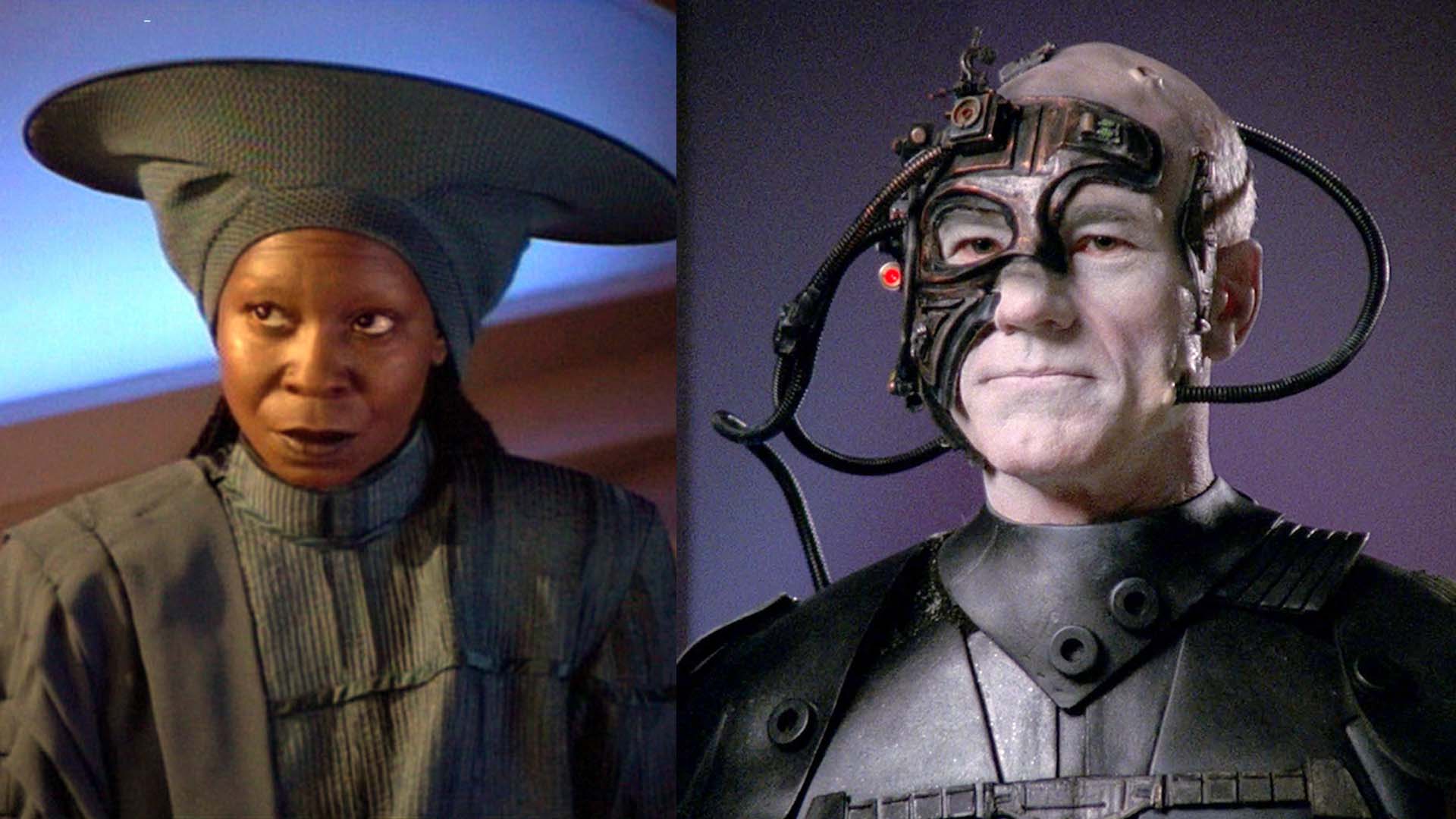
No one expected Star Trek to last longer than the original series’ first three seasons, let alone 55 years.
Even by 1960s standards, the classic show suffered from low-budget sets and, at times, cheesy effects. But what it lacked in spectacle it made up for with ideas; a thematically-rich exploration of heady sci-fi concepts bolstered by occasional space-based action and some of the finest TV characters ever assembled. Trek ’s legacy would endure and spawn 13 feature films and several series, most notably Star Trek: The Next Generation , which is as popular now (or more) than it has ever been, thanks to streaming. In 2021, TNG celebrate some significant milestones: The 30th anniversary of the Season 5 episode "Disaster," Trek 's take on disaster movies like The Poseidon Adventure , the 30th of "Unification, Parts I and II, which marked Mr. Spock's return to television prior to the theatrical release of 1991's Star Trek VI: The Undiscovered Country , and Star Trek: First Contact recently turned 25.
With everyone coming up Star Trek: The Next Generation lately, as well as the franchise itself celebrating its 55th anniversary this year, SYFY WIRE scrolled through our databanks to rank and file the 25 greatest episodes of TNG .
25. “Q Who?” (Season 2)
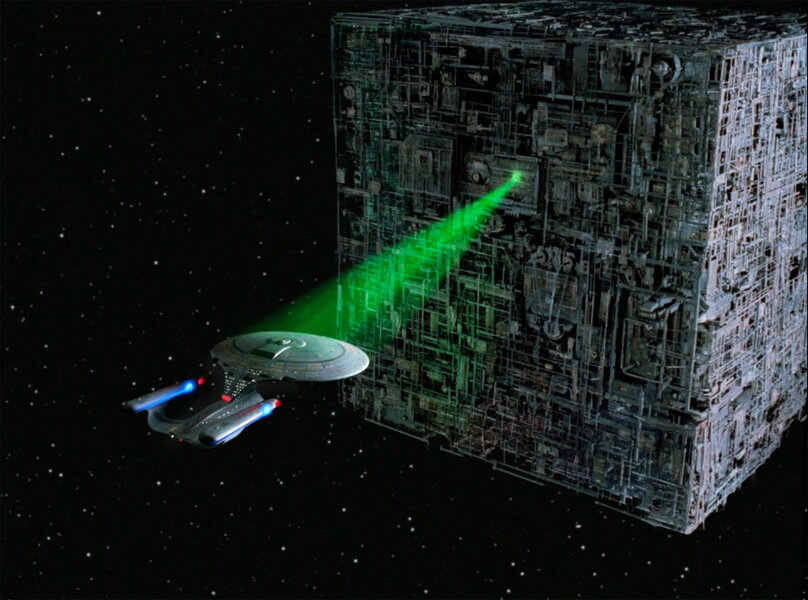
The Borg have never been more scary than they are in “Q Who?”, their first appearance in Star Trek .
When Q is denied a spot amongst Picard’s crew, he punishes the captain’s perceived short-sightedness by snapping his fingers and sending the Enterprise to the unexplored reaches of the Delta Quadrant. There, Picard encounters — and barely escapes — the Borg and their relentless pursuit of perfection by means of assimilation. The moment their cube vessel cuts out a section of the D’s saucer as easily as one would carve a roast, the Borg instantly shot past the Klingons as Star Trek ’s most lethal adversary. Our introduction to the Borg is both bleak and dark, which gives the episode a slow burn, almost haunted house movie-type feel thanks to future X-Files director Rob Bowman’s dread-filled visual style. For the first time on Star Trek , you don’t know how or if the crew will get out of this one. The tension therein makes for one hell of an episode.
24. “The Next Phase” (Season 5)
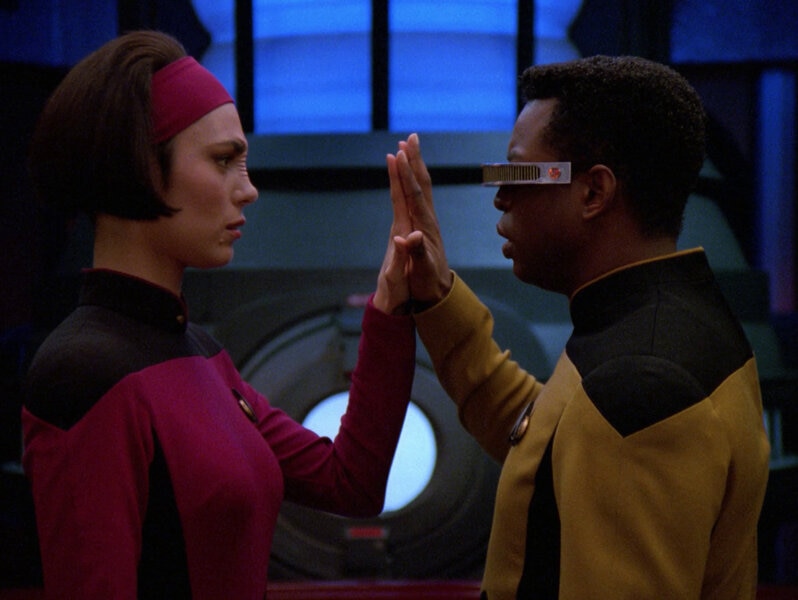
“The Next Phase” is further proof that, when it comes to delivering high-concept entertainment, no Trek show did it better than The Next Generation .
With a plotline rich enough to sustain an entire feature, “Next Phase” pairs the conflict-heavy Ensign Ro (Michelle Forbes) with LeVar Burton’s Geordi LaForge on a mission to free themselves from being phased out of reality before Romulans destroy the Enterprise. Forbes and Burton’s committed performances help ground the out-there premise as the sci-fi complications build to a race-against-time conclusion that is so satisfying, you might catch yourself applauding in approval.
23. “Ensign Ro” (Season 5)
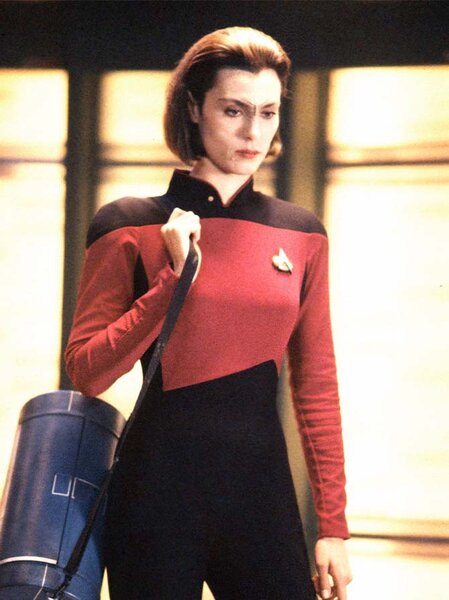
Season Five’s “Ensign Ro” had the unenviable task of introducing the episode’s titular recurring character as means to tee up the Star Trek: Deep Space Nine spinoff. While more plot heavy than usual TNG episodes, Michael Piller’s teleplay delicately balances out the exposition with essential character development scenes between the infamous Ro Laren and her new captain, Picard.
When we first meet the Bajoran Ro, everything about her says “stay away.” Her rebellious Starfleet record precedes her when she first boards Enterprise, which leads to instant friction between her and Riker as Picard recruits Ro for a mission that concerns her people and their enemy, a Nazi-like occupational force known as the Cardassians. Ro quickly became a fan-favorite, thanks to Forbes’ sympathetic and charming performance in what would become a load-bearing episode for the franchise’s expansion in the ‘90s.
22. “Brothers” (Season 4)
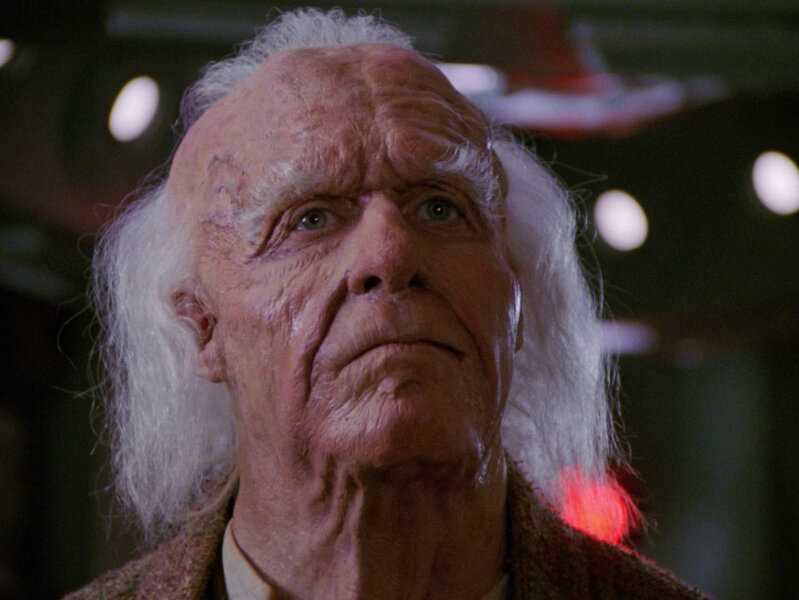
This Season 4 entry fleshes out Data’s backstory with a one-man show for Brent Spiner as he plays three different characters: Data, his very old creator, Dr. Noonien Soong, and Data’s very evil brother, Lore.
After Data inexplicably orchestrates a fake disaster aboard the Enterprise and takes control of the ship’s computer, he confronts both the father he thought was long lost and the brother he can’t seem to lose. Soong wants to give Data an emotion chip, to finish what he started before he dies, just as Data’s family reunion jeopardizes the health of a young boy under Dr. Crusher’s care. If Data doesn’t relinquish control of the Enterprise, this kid will die and his brother will suffer from a lifelong case of survivor’s guilt. Looking past the fact that “Brothers” confusingly avoids dealing with any serious questions surrounding Data’s selfish and potentially deadly actions, the episode serves as an extended Emmy reel for Spiner. He effortlessly dons old age makeup and switches between three generations of Data’s family line in what is a definitive moment in the android’s arc.
21. “Deja Q” (Season 3)
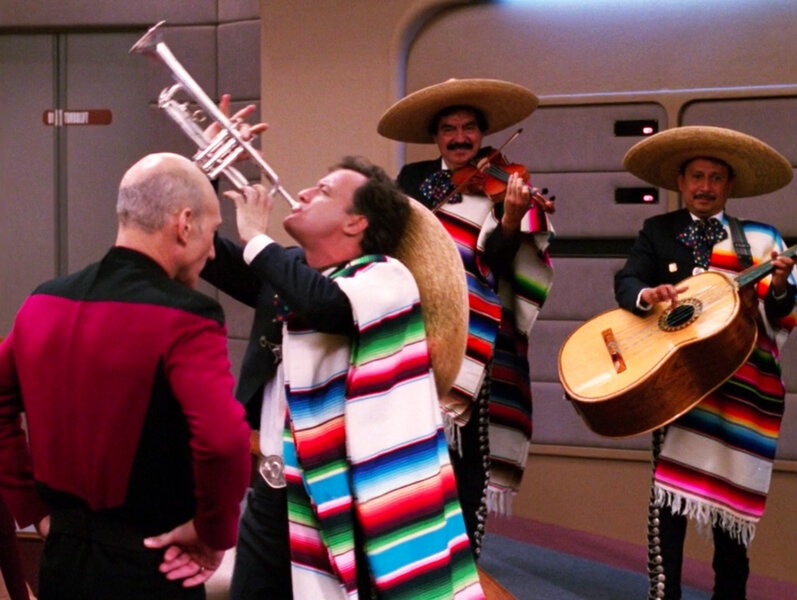
The second best of Q’s visits to the Enterprise, “Deja Q” is a brilliant elevator pitch — what if Q lost his powers — executed to its richest and most dramatically satisfying potential. Stripping Q of his omnipotence gives the mischievous a newfound sense of vulnerability and humility, one he only previously experienced when observing the subjects of his torments. While Q’s appreciation for what it means to be human is brief, it gives John de Lancie interesting opportunities to invest his iconic baddie with more nuance as Q goes from selfless to selfish in this entertaining (and very meme-friendly) outting.
20. “Reunion” (Season 4)
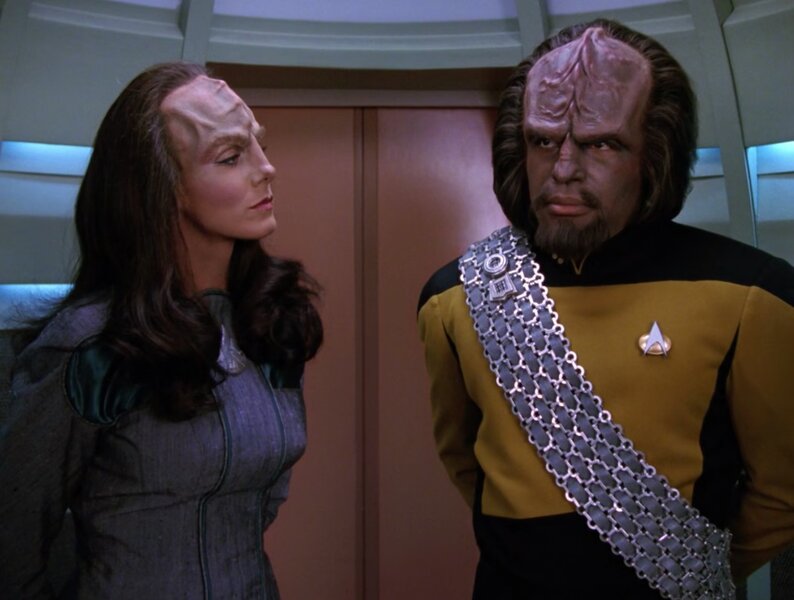
Worf-centric episodes of TNG like “Reunion” or “Sins of the Father” are to Star Trek what the last two Captain America movies are to Marvel: World-building game changers. “Reunion” pushes major plotlines whose consequences will eventually ripple effect throughout the next three decades of Star Trek , as Worf’s personal vendetta against his rival, the Duras family, brings more intrigue to the Enterprise and tragedy to our favorite Klingon.
It also pushes Worf into a relationship with his estranged son, Alexander, as the two must learn to live together when a conspiracy that threatens to tear the Klingon Empire apart results in the death of Alexander’s mom and Worf’s over, K'Ehleyr (the scary-talented Suzie Plakson). The mystery plot here clicks into place like safe tumblers, but “Reunion” truly excels in the moments spent with Worf as his obligations as a Starfleet officer get in the way of his code as a Klingon warrior. Especially when, during one of Trek ’s darkest moments, Worf exercises his right to avenge his one true love by straight-up murdering her dishonorable killer.
19. “The Drumhead” (Season 5)
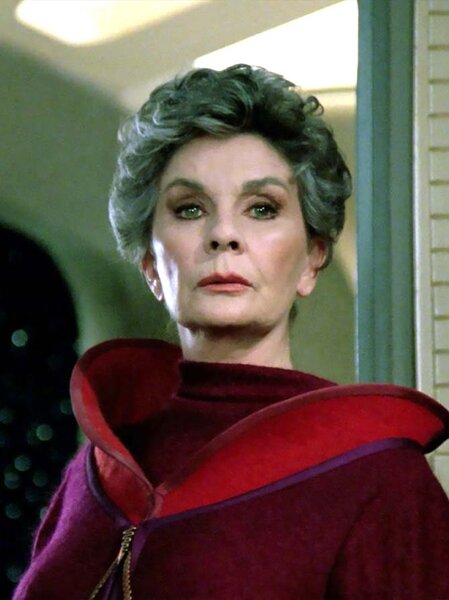
As bottle episodes go, they don’t get much better or more powerful than “The Drumhead.”
It’s The Crucible on the Enterprise as Picard spars with one of the Federation’s legendary legal minds and investigators when she suspects there is a Romulan conspiracy taking root on the flagship. The circumstances surrounding her suspicions achieve Red Scare-levels of paranoia as TNG puts McCarthyism through a revealing and unyielding sci-fi lens to tell a very timely story of how far people will go to find the truth — even if it means fabricating a version of it.
18. “Lower Decks” (Season 7)
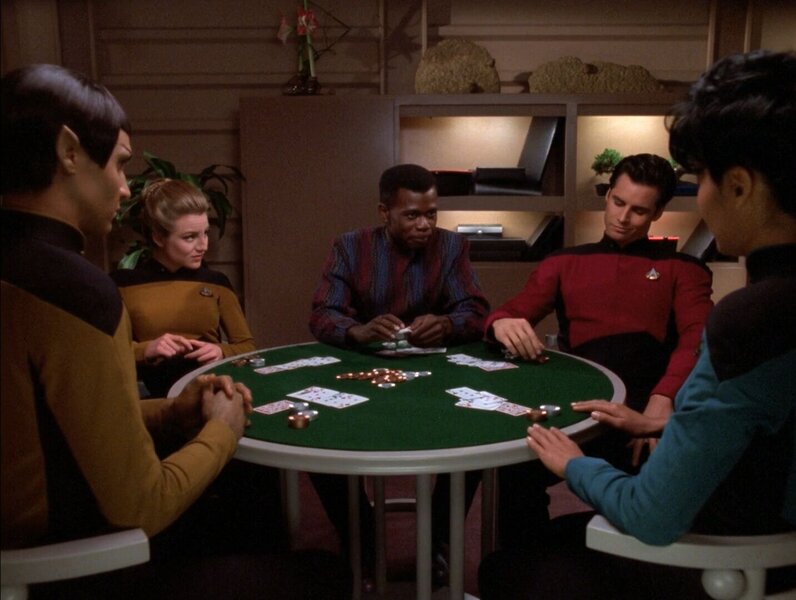
Before the comedic adventures of the animated Star Trek: Lower Decks , Star Trek ’s first attempt to explore the lives of the rank-and-file officers aboard a starship occurred in “Lower Decks,” one of the few standout episodes from the underwhelming Season 7.
“Lower Decks” devotes most of its screentime to a small group of pals who aspire to be on the Enterprise bridge or among the senior staff’s away missions. They soon end up in “be-careful-what-you-wish-for” territory when Picard plucks one of the young officers, the Bajoran Ensign Sito (Shannon Fill), to help him execute a dangerous mission involving the Cardassians. “Lower Decks” acts as a pseudo-sequel of sorts to “The First Duty,” where Picard first encountered Sito during a court martial that tarnished the then-cadet’s career before it started. Her chance at redemption via Picard’s mentorship gives the episode its beating heart, which ultimately breaks ours in the final moments when this earnest officer we’ve been rooting for becomes another casualty under Picard’s command. With this final dramatic twist, “Lower Decks” goes from a welcomed departure from TNG ’s usual story template to one of the show’s most effective episodes.
17. “The First Duty” (Season 5)
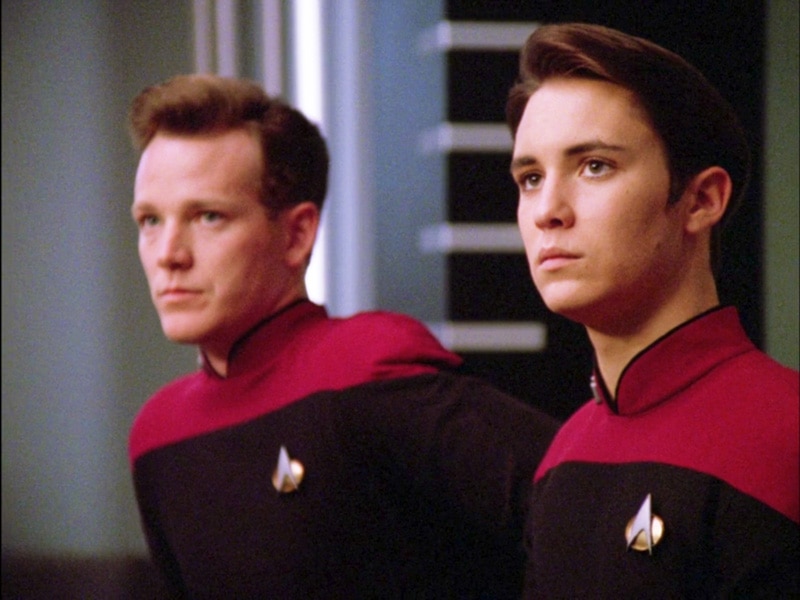
Wesley Crusher continues to give Picard more headaches than anyone is worth, but at least this time it results in a standout episode of Trek .
Ron Moore’s attempt to do A Few Good Men , Star Tre k -style, centers on Crusher and his fellow cadets. On the eve of their graduation from Starfleet Academy, they find themselves in the middle of a tribunal that intends to get to the truth behind why their friend and fellow cadet, Josh, died during a flight exercise. The lies Wesley and his friends tell to escape justice only puts them under more scrutiny when Picard goes digging around the shady circumstances surrounding Josh’s death. That search yields a show-stopping scene between Picard and Wesley, with one hell of a monologue that still gives us chills. “The First Duty” adds some much needed depth and ethical greys to Wesley’s squeaky-clean image, while also affording TNG the rare chance to challenge its “perfect” utopia by proving that even the best of us can succumb to our lesser angels.
16. “The Defector” (Season 3)
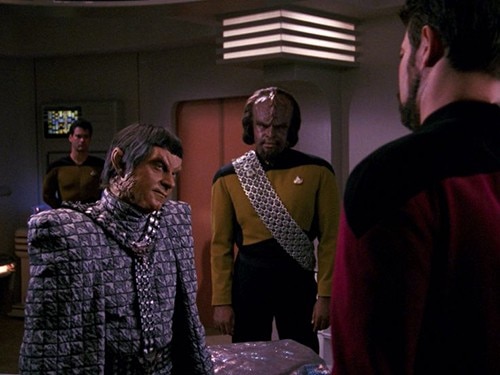
“The Defector” is another exceptional episode from (shocker) writer Ron Moore, which puts a Romulan defector front and center with tragic consequences.
This defector, who Picard struggles to believe is just some low-level officer, risks never seeing his family again in an effort to save his people and Earth’s from what appears to be another costly war brewing between the two adversaries. In the course of vetting the defector’s statements, Picard finds more questions than answers. That investigation comes with one hell of a gut punch: Eventually, the Romulan officer realizes his people betrayed him . They used him as bait, leaking somewhat false information as a way to test his loyalty to the Empire and gleam intelligence off Starfleet’s response to their partial ruse. “The Defector” is a powerful tale of one man’s journey from brave hero to duped traitor, with a mystery plot that keeps audiences at the edge of their seats as the final scenes send them reaching for some tissues.
15. “Disaster” (Season 5)

Designed as an homage to classic disaster movies like The Poseidon Adventure , Ron Moore’s underrated “Disaster” gives the Enterprise the Irwin Allen treatment when the starship is crippled after a collision with two quantum filaments (think space potholes). With the ship powerless and adrift, “Disaster” splits up the crew and mines their individual crises for maximum tension by putting these characters outside their comfort zone or into conflict-rich pairings. For example, an injured Picard is forced to help and work with people he normally can’t stand, children, while Counsellor Troi finds herself both in command and way over her head as her inexperience clashes with that of the better-trained Ensign Ro. “Disaster” is the rare Trek outing with no moral or lesson to learn, just good ol’ fashioned, keep-the-plates spinning tension that is just as rewatchable as the epic movies that inspired it.
14. “Relics” (Season 6)
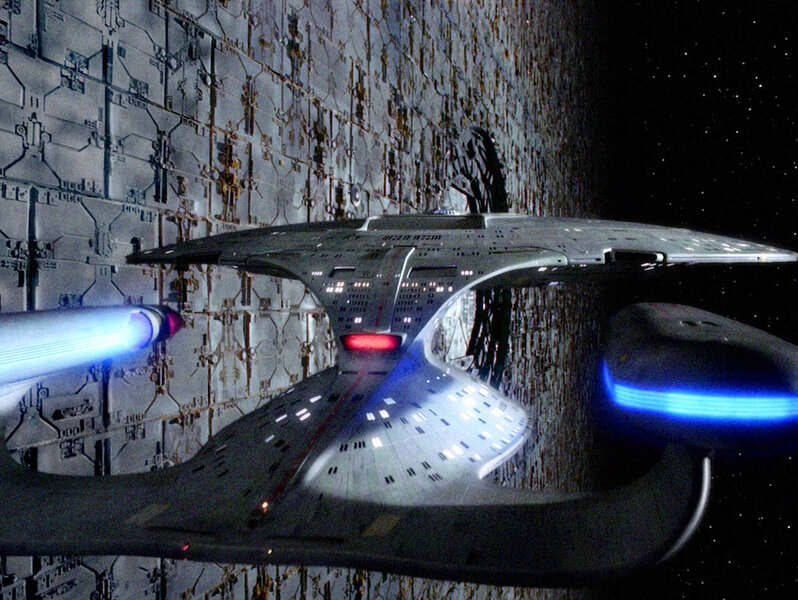
The Next Generation thankfully loosened up on its “no classic Star Trek actors” guest star policy for Season 6’s “Relics,” a thrilling episode written by Ron Moore that brings James Doohan’s Scotty into the 24th Century.
Prior to Scotty, only McCoy and Spock mingled with Picard’s crew, but Scotty’s episode arguably makes the best use out of revisiting these iconic characters. Here, Scotty struggles with being a man out of time and a fish out of water when he is thrust into a conflict of engineering styles with Geordi as the two must work together to free the Enterprise-D from the massive confines of a Dyson sphere. The episode spends considerable time contrasting the two engineer’s styles, giving Doohan more meaty acting moments in this one hour than any episode or movie did before. Scotty, accustomed to saving the day and with plenty of old war stories to prove it, quickly realizes he’s less of an asset on this Enterprise and more of a has-been. He begins to find his place and relevance once again by sharing a drink with Picard on the bridge of The Original Series ’ Enterprise (albeit a holodeck recreation of it).
“Relics” wisely invests Scotty with a rich exploration of what would really happen if one of the 23rd Century’s most famous heroes finds himself questioning his usefulness in the 24th Century. Moore’s script uses one Trek icon to push and challenge his TNG equivalent, giving fans one of the show’s most exciting adventures.
13. “Chain of Command, Parts I & II” (Season 6)
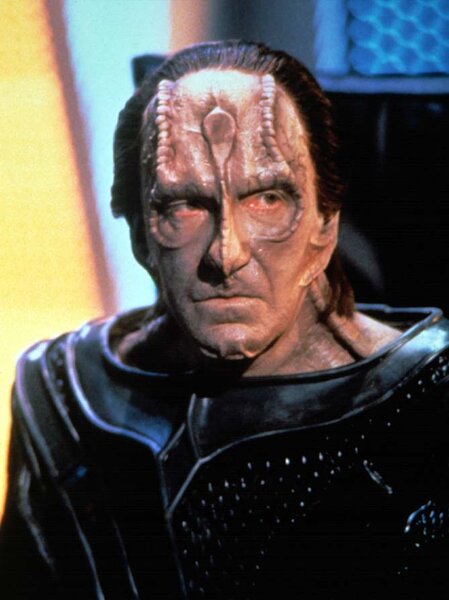
“Chain of Command” is arguably TNG ’s darkest hour, and one of its most thrilling. This two-parter kicks off with one of the shortest teasers in Trek history: Captain Picard loses command of the Enterprise when Starfleet re-assigns him to lead a Black Ops-esque team on a mission deep into enemy territory. That enemy? The Cardassians. Picard’s job is to find out if these baddies are creating a deadly bio-weapon and but his mission goes sideways; he is soon captured and tortured as a POW by a sadistic Cardassian (David Warner) as Riker bristles against the brash command stylings of Picard’s replacement, Captain Jellico ( RoboCop ’s Ronnie Cox.)
The second half of this intense storyline is the strongest and most memorable for fans, as it features the infamous “There are four lights!” interrogation scene. Here, a gaunt and delirious Picard combats his captor’s psychological torture as the Cardassian gaslights Picard into submission by promising him freedom if Jean-Luc will admit he sees five lights when there are only four. This battle of wills is fraught with more tension than any space battle could muster, as “Chain of Command” provides a sobering dose of political commentary by tackling the issues of war crimes and genocide in ways only Star Trek could.
12. “The Wounded” (Season 4)
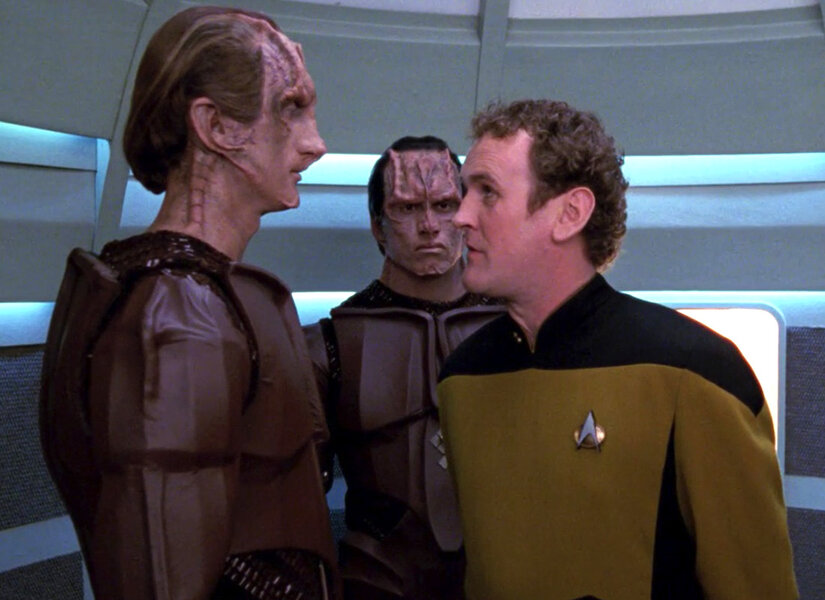
The first appearance of the villainous Cardassians (complete with their funky and quickly-abandoned head gear) is Star Trek: The Next Generation ’s sci-fi take on Coppola’s Apocalypse Now . Only instead of venturing “up river” to terminate a rogue colonel, Picard and Chief O’Brien (Colm Meany) are forced to work with “the bloody Cardys” in pursuit of O’Brien’s former captain, Maxwell ( Shawshank Redemption ’s Bob Gunton). Maxwell has seemingly gone rogue, using his starship to attack what appears to be non-military Cardassian targets.
O’Brien, having fought the Cardassians during a violent war years ago, must grapple with his hate and his duty in an episode that gives the supporting character his first real dramatic showcase. When O’Brien finally has some alone time with the cornered and defeated Maxwell, “The Wounded” earns its namesake as the two sing a melancholic song after sharing war stories of comrades lost that Maxwell’s vengeful PTSD can’t ever bring back. This haunting scene tugs on the heartstrings moments before Picard discovers that the supply ships Maxwell attacked were indeed part of Cardassian efforts to re-arm themselves. It is a revelation that validates Maxwell’s career-ending crusade while also giving the episode one of Trek ’s most bittersweet finales.
11. “The Offspring” (Season 3)
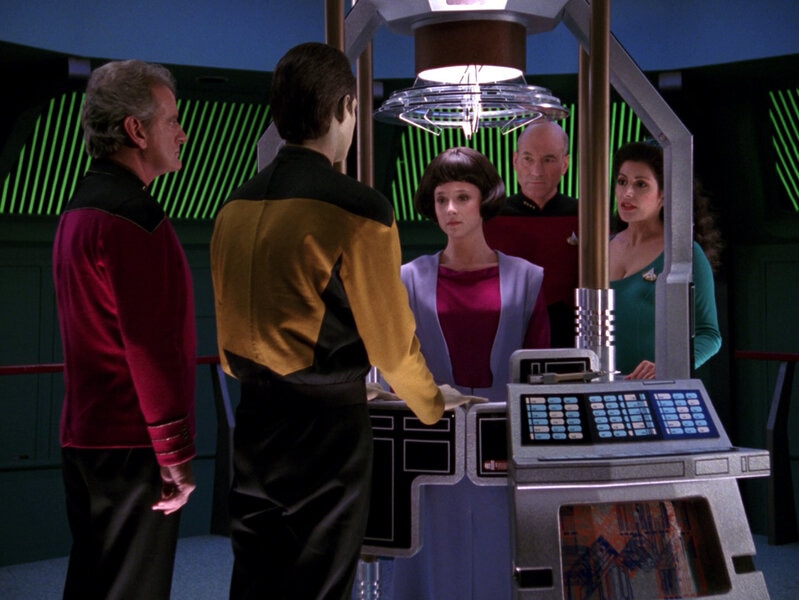
Data’s earnest endeavors to be more human reach a turning point in “The Offspring,” an emotionally-charged episode of TNG where Data creates his daughter, Lal.
Just as the android bonds with his child, a veteran Starfleet admiral arrives on Enterprise threatening to pull them apart when he challenges their right to be a family at all. Star Trek: TNG often finds success in exploring Data’s humanity
through the lens of the very humans who would try and take it away from him. “The Offspring” offers an excellent and tearful portrayal of that conflict as the crew comes to their friend’s aid just as Lal suffers a life-threatening issue. It’s a five-boxes-of-tissues affair when Data and the admiral work offscreen to save Lal. No matter how fast Data’s hands move, they fail to prevent Data from having to learn the hardest of humanity’s lessons: Loss.
10. “Measure of a Man” (Season 2)

Real talk: Star Trek: The Next Generation ’s first two seasons are noble misfires. Their weekly installments have more lows than highs, but one of the few outstanding hours from the series’ early days is the Data-centric “Measure of a Man.”
When another jerkoff Starfleet scientist comes looking to dissect Data to see what makes him tick, Picard must defend his officer’s sentience in court, and settle once and for all if this android is indeed alive or merely Federation property. The stakes couldn’t be higher — Data either gets to live on the Enterprise or under a microscope — and the drama that unfolds from this classic Star Trek premise is riveting. “Measure of a Man,” Melinda M. Sondgrass’ first writing credit for the show, is full of great dialogue and speeches that spark numerous ethical debates: Who is Starfleet to say that Data is sentient or not? Is their mission to explore new life or to play God when they find it? “Measure” never shies away from debating such topics, which have always been at the heart of Star Trek . It all builds to Picard’s passionate, climactic defense in favor of his colleague and friend — a scene that ranks near the top of Patrick Stewart’s long list of great acting achievements.
9. “Darmok” (Season 5)
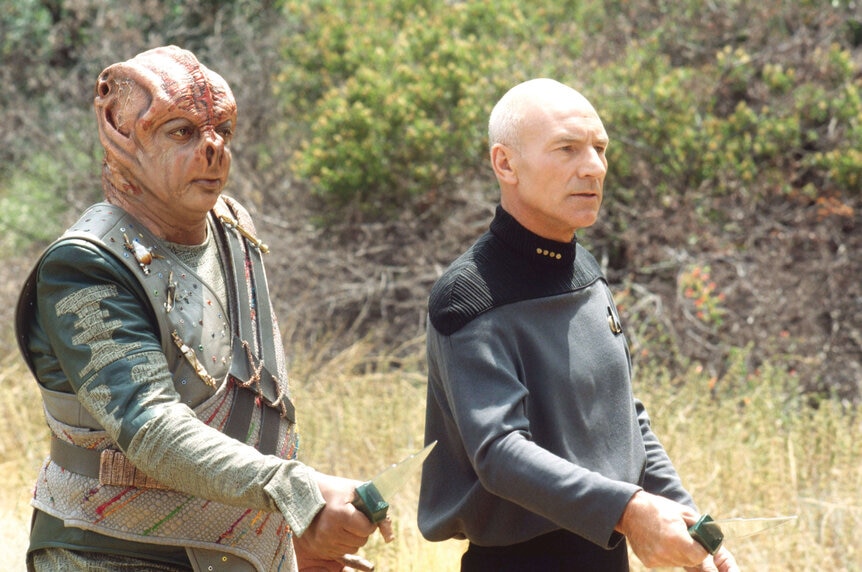
Credit: © Paramount Television/courtesy Everett Collection
Picard’s diplomatic skills are put to the test in “Darmok,” when he is taken against his will and paired with an alien commander who only communicates via metaphor. This “only-on- Star-Trek ” premise offers a potential minefield of narrative obstacles that could easily derail the drama in their execution, but Joe Menosky’s exceptional script for this Season Five episode pulls it off effortlessly.
Picard, stranded on a mysterious planet with Dathon (Paul Winfield), quickly finds that language can be both a tool and a barrier for success, but only after failing several times in his attempt to communicate with his new alien friend. The two can hear each other's words, but not comprehend their meaning, which eventually leads to one of Picard’s finest moments: A campfire story recounting the tale of Gilgamesh. (But only after Dathon tells the mythic story of Darmok and Jalad, at Tanagra). Here, the two strangers forge a strong alliance — just in time to combat a savage threat. “Darmok” deservedly takes its time to tell a story about how similar we are despite our linguistic differences, and every rewatch of this seminal TNG episode never fails to make that point resonate as deeply as it did when it first aired.
8. “I, Borg” (Season 5)
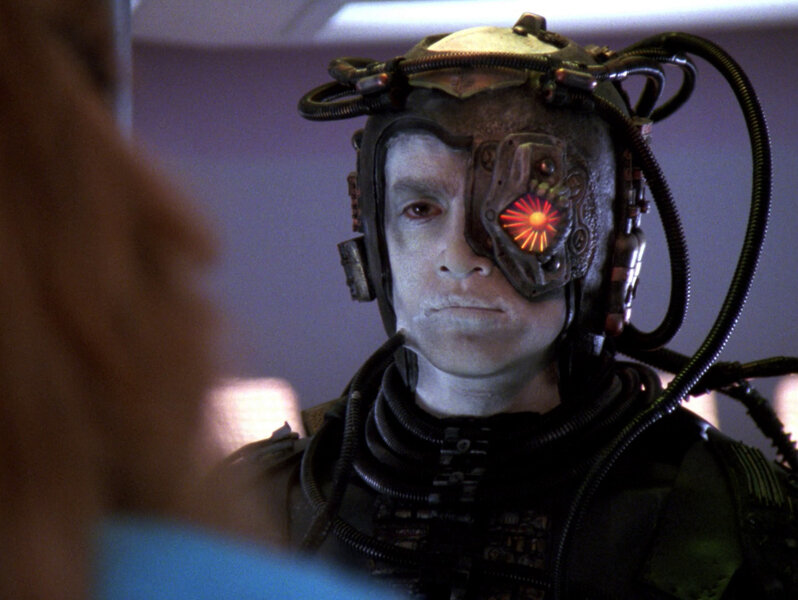
The value of life has been a thematic staple of many Star Trek episodes, but few have tackled it with the high-stakes drama like “I, Borg” does.
When the crew of the Enterprise finds an injured Borg drone, Picard must make a choice: Nurse it back to health or use it as a Trojan Horse that can infect the Borg Collective with a fatal virus. When Picard leans closer to condemning this Borg’s life to save millions of others, “I, Borg” thrusts the captain and his crew into a passionate moral debate that results in one of the series’ most powerful moments when Picard confronts the naive drone, one that Geordi has affectionately named “Hugh”. Up until this moment, Picard was hellbent on using Hugh to destroy the alien race that once assimilated him. But the captain has a change of heart while talking to Hugh as Locutus, Picard’s former Borg self. Here, Hugh breaks from the collective by speaking firmly from the “I” instead of “we,” which sends Picard into a wrestling match with his conscience.
Star Trek rarely colors its heroes in such dark shades, but “I, Borg” succeeds by realistically portraying how someone like Picard isn’t wrong , per say, for wanting to kill those that turned him into a killer. For wanting to punish the Borg for crimes against humanity (and the galaxy) that they have committed and will likely commit again. But can you still be a hero if you do to your enemy what they did to you, and alter and weaponize them? “I, Borg” argues that there are no easy answers to those questions, but the discussion they spark makes for a very profound hour of television.
7. “Tapestry” (Season 6)

Star Trek goes full It’s a Wonderful Life with “Tapestry”, which is arguably the best of the standalone Q episodes.
After a near-death experience, Picard is shown the life he could have lived had he played it more “safe” in his youth. The path not taken leads Picard away from command and into a blue uniform with a career so unremarkable, even Troi struggles to find something nice to say about it. On the road to nowhere fast, Picard turns to Q for a second chance to get back the only life he knows, even if it means dying to get it. “Tapestry,” written by the inestimable Ron Moore, takes an almost Twilight Zone -y approach in telling this story, which is full of heartfelt moments and surprisingly laugh-out-loud comedy. The lesson Picard learns here, about how rewarding taking risks can be, is a universal one — which explains why "Tapestry" often finds its way near the top of fans’ “must-watch” lists.
6. “Family” (Season 4)
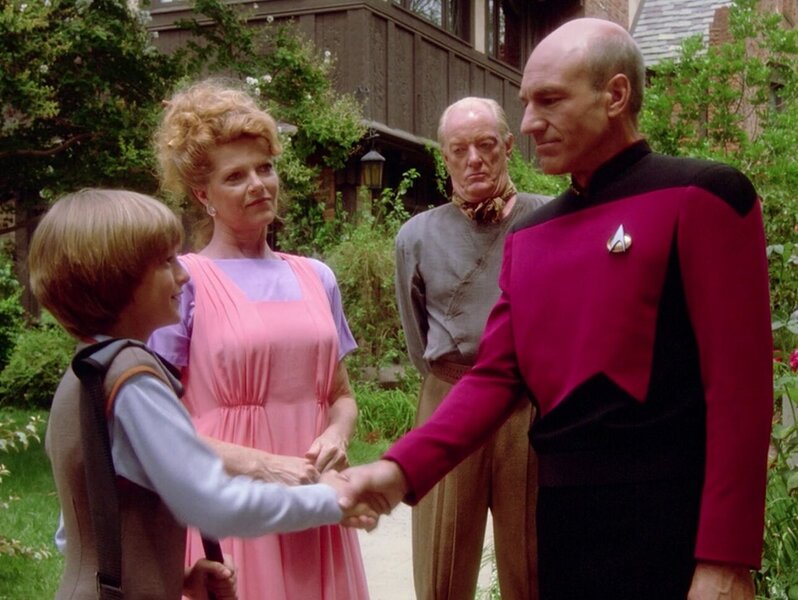
Honestly, it’s a mini miracle that “Family” got made.
Before this exceptional episode from TNG ’s fourth season, the series largely steered clear from serialized storytelling. At the time, executive producer Rick Berman and Paramount television were strongly against “sequelizing” any TNG storylines; “no serialized stories” was an unofficial “rule” of television back then. But writer Ronald D. Moore thankfully saw an opportunity to break that rule with a story that he couldn’t pass up: How would Picard deal with the emotional fallout of his time with the Borg?
With no phaser battles or even a trip to the Enterprise bridge (the only episode in Star Trek ’s run to never have a scene set on the command deck), “Family” pulls off an engrossing hour of television that peels back the curtain on who Picard was, and who he is struggling to be, in the the aftermath of the two-parter “Best of Both Worlds”. Mostly set on Earth, the episode introduces Picard’s family vineyard into Trek canon, as Picard confronts his estranged brother and debates whether or not to leave Starfleet. The only person who can help Picard deal with his trauma is the last person he can stand being with, his brother. Only through their constant bickering does Picard find a sense of satisfying resolution, which gives Stewart one of his most heartbreaking scenes when he finally acknowledges the emotional scars the Borg left him with.
5. “Cause & Effect” (Season 5)
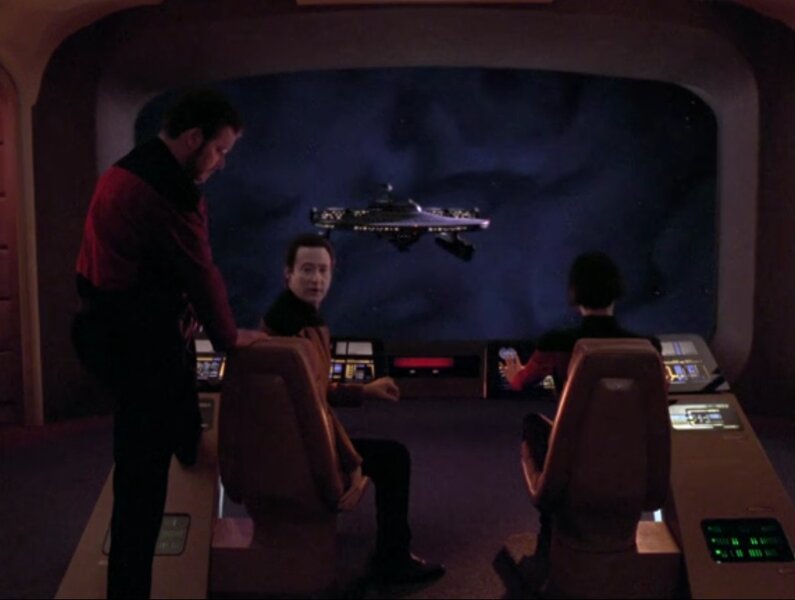
After a jarring teaser that culminates with the fiery destruction of the Enterprise, “Cause & Effect” unfolds with time loop after time loop as Picard and his crew struggle to free themselves from suffering the same terrible fate.
Written by Brannon Braga, TNG ’s go-to scribe for high-concept stories, “Cause & Effect” pulls a Groundhog Day two years before the movie was even a thing. It breaks the show’s traditional storytelling mold by repeating the same disaster and making each loop through a new puzzle that both the audience and the crew must solve. Fans were so “in it” with their favorite characters that many called their local affiliates during the original broadcast with concern that something was wrong with the satellite feed as the episode kept repeating scenes. While audiences take the “time loop concept” for granted today, “Cause & Effect” pioneered it in a way that still registers as one of its best and most entertaining executions.
4. “The Inner Light” (Season 5)
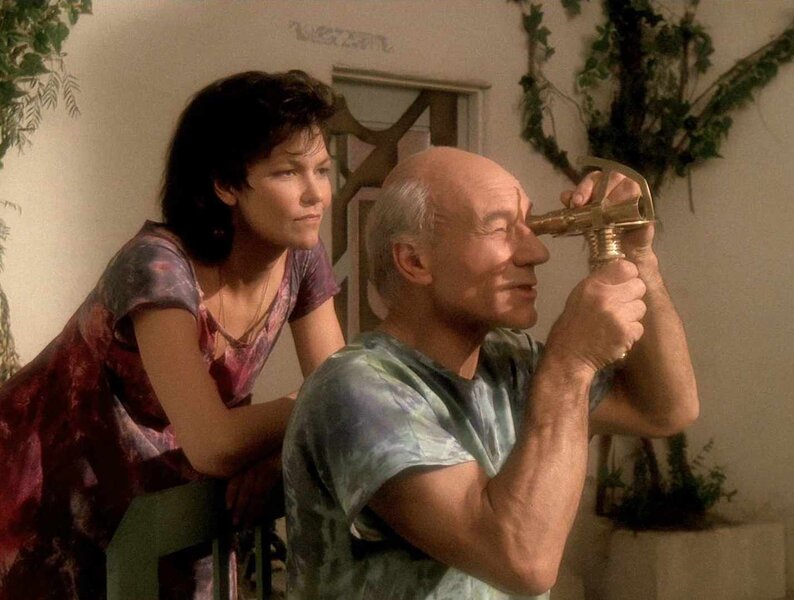
This surprising tearjerker ranks high for fans, thanks in large part to Patrick Stewart’s compelling performance as “The Inner Light” explores the concept of being a living witness to an extinct civilization. In this classic episode, Picard finds himself living the life of a long-deceased man named Kamin, after being zapped by a probe that is seemingly all that remains of Kamin’s civilization.
The probe allows Picard to live a lifetime in 20 minutes, and experience all the things Picard denies himself to be — namely a husband and a father. The majority of the episode takes place on an alien world as it is slowly undone by Star Trek ’s equivalent of global warming, with Kamin trying to help save his planet from pending doom the way Jor-El tried with Krypton. And like his Superman counterpart, Kamin fails — but he succeeds in providing a glimpse into a society that, while being nothing more than a blip in the galaxy’s grand scheme, still has a legacy worth being remembered. That’s the heartfelt and poignant endnote “Inner Light” imparts on viewers, which explains why this episode still resonates decades after it first aired.
3. “Yesterday’s Enterprise” (Season 3)
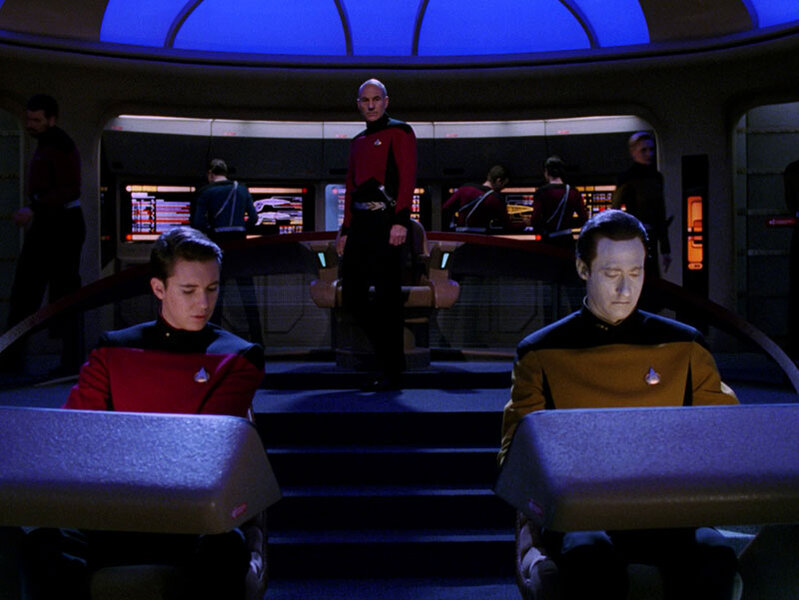
When the long lost Enterprise-C travels through a (what else?) temporal anomaly that alters history, Picard and the crew of the Enterprise-D find themselves in the darkest timeline and at war with the Klingons. The only way to stop this war is to send the C’s Captain Garrett back to when she came from and change history. The only catch? In order to save millions of lives, nearly everyone aboard the Enterprise-C must sacrifice theirs.
That moral and ethical dilemma at the heart of “Yesterday’s Enterprise” makes this hour more than just a novel “What If…?” detour for the show to explore. It affords TNG a chance to give its main characters a more desperate edge as they debate the notions of fate as participants in a reality that should not exist. At the heart of this drama is Picard, who is more militant and beleaguered than ever as he debates with Whoopi Goldberg’s Guinan (and her time-sensitive intuition) about whether or not to send the other Enterprise’s crew to certain death.
The return of Denise Crosby’s Tasha Yar gives her character the proper (and heroic) sendoff she deserves, which gets complicated as Tasha falls in love with a member of the C’s crew around the same time she discovers she died in the original Enterprise-D timeline. The internal struggle over restoring the way things were meant to be, by sacrificing lives history already recorded as lost, is a classic Star Trek premise that “Yesterday’s Enterprise” explores to a very satisfying, and action-packed, conclusion.
2. “The Best of Both Worlds, Parts I & II” (Season 3 & 4)
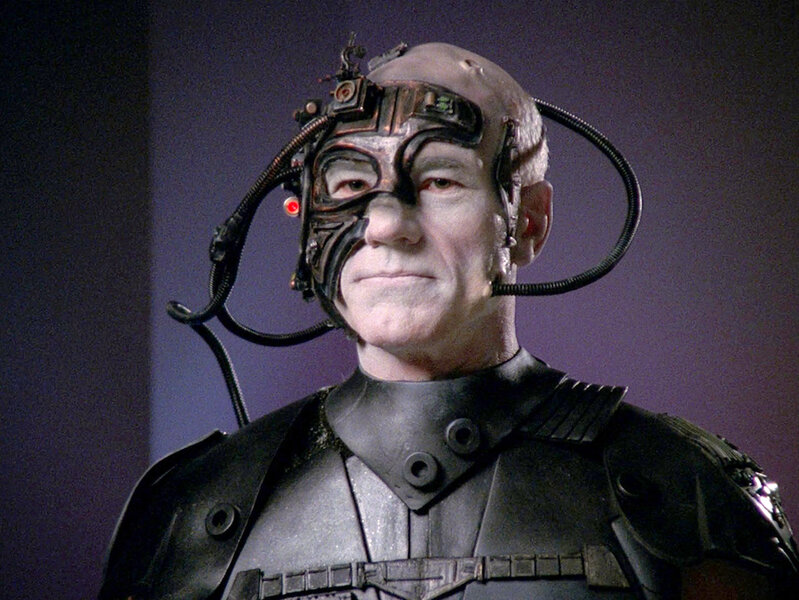
Star Trek ’s first-ever season-finale cliffhanger is one of television’s greatest. More than three decades later, fans still get chills at the end of “Best of Both Worlds, Part I” when Riker gives the chilling order to “fire” on the Borgified version of his former Captain Picard.
The wait for this iconic storyline’s resolution made the Summer of 1990 a very long and agonizing one for Trek fans, but it was worth it. “Best of Both Worlds, Part I” has TNG mining similar character drama as Star Trek II: The Wrath of Khan did, with Commander Riker forced to confront why he keeps passing up one promotion to Captain after another — just as his Captain is taken by the Borg in a violent attempt to turn Picard into Locutus, the public face of their campaign to assimilate Earth and all of humanity. The episode is a nail-biter, thanks to a perfect script from the late writer Michael Piller. The former TNG showrunner takes a bigger-than-usual swing with the characters to tell a story somewhat outside of the series’ comfort zone. While “Part II” falls a bit short of the dramatic highs of “Part I,” it finds great success in dramatizing the crew’s struggle to get their Captain back (even if their final solution is ultimately more convenient than inspired.)
The Enterprise crew’s second encounter with the evil cybernetic beings would have consequences throughout the next 30-plus years of Star Trek , especially in 1996’s Star Trek: First Contact . The hit movie serves as a big-screen, action packed therapy session for Picard to deal with the trauma of his assimilation into the Borg collective.
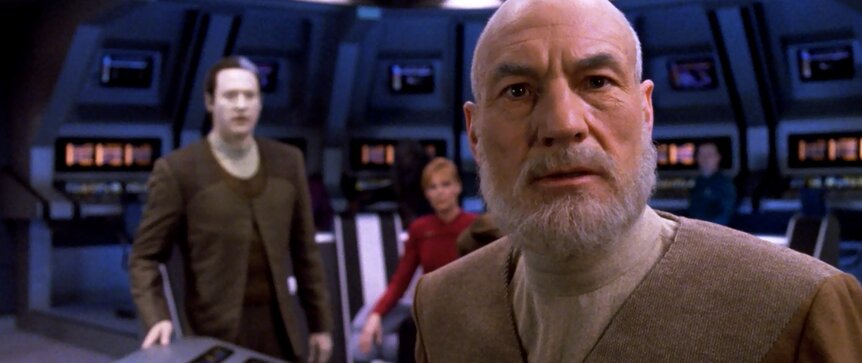
1. “All Good Things…” (Season 7)
“All Good Things…” is the best Star Trek series finale ever and The Next Generation ’s crowning achievement.
Written by Brannon Braga and Ronald D. Moore, “All Good Things” proved to be a better cinematic-worthy adventure than The Next Generation crew’s first movie, Star Trek: Generations . The briskly plotted, feature-length episode — and its complex storyline involving paradoxes and second chances — finds a disoriented Picard struggling to uncover why he is moving back and forth through time. He slips in and out of three key time periods: The past, just before the launch of Enterprise-D’s first mission; the present, and the future. In the future, Picard is a very retired, very old man, who runs his family’s vineyard. He also is afflicted with a debilitating neurological syndrome that makes it hard for his former shipmates to believe him when he starts pulling a Sliders across multiple timelines. Picard’s mission — which, of course, is being manipulated by the omnipotent Q — forces the captain to convince all three versions of his crew to work together in each timeline in order to stop an anomaly from unraveling existence as we know it.
TNG gives the beloved cast and their characters a perfect final episode that brings them together as a family in ways the series left surprisingly unexplored for most of its run. As impressive as the action is in “All Good Things”, especially the scene where the futuristic Enterprise-D flies on its Z-axis while blasting newly-mounted phaser cannons, the episode’s best scenes are the quieter ones spent with these characters. The finale truly shines in its final moments, when Picard joins his crew for the first time at their regular poker game. Picard’s arrival at the poker table resonates with his crew as deeply as it does for fans, which is a testament to the finale’s commitment to giving Next Generation the emotional send off it deserves.
Watch Resident Alien
- Star Trek: The Next Generation
- SYFY Insider
Related Stories

Before the Dark Universe, Van Helsing Was a Wild Remix of Universal's Monsters

All of the Fight and Battle Scenes in Gladiator, Ranked

Where Is The Continental Hotel Located In New York City?
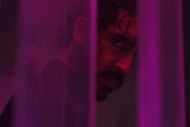
The 15 Best Summer Movies to Stream on Peacock Right Now

Why Don't People in Ghostbusters Remember the Ghosts?

The Thing Documentary Digs Into John Carpenter Classic

The 5 Best Anime Series on Peacock in June 2024

Why Alice Eve's Carol Marcus Didn't Return in Star Trek Beyond

John Wick Easter Eggs in Peacock's The Continental

The 5 Best Animated Shows on Peacock in June 2024

The Best Fantasy Movies Streaming on Peacock in June 2024
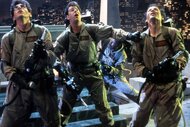
The 14 Best Sci-Fi Movies on Peacock in June 2024
Recommended for you.

Linda Hamilton on Resident Alien Role: "I'm Not the Funny Girl, I'm the Straight Man"

The Classic Twilight Zone Episode That Inspired Jordan Peele's Us

Resident Alien's Alan Tudyk on Harry's New Love Interest, Edi Patterson's Blue Avian
10 Best Episodes of Star Trek: The Original Series, According to IMDb

Your changes have been saved
Email Is sent
Please verify your email address.
You’ve reached your account maximum for followed topics.
Shogun Star Teases Her Character's Arc for Season 2
The game of thrones franchise is moving in the wrong direction, doctor who pulled a rey skywalker origin, but it opened up many plot holes.
It's impossible to imagine a world without Star Trek in it. Gene Roddenberry's creation, which he explained as " Wagon Train to the stars " influenced not only the look and design of cellphones, but was the doorway to science, math, and engineering for hundreds, if not thousands, of the people who work in those fields today. And it all started with a low rated TV series that barely lasted three seasons.
RELATED: Star Trek: The 8 Most Memorable Episodes The Original Series
Star Trek: The Original Series seemed destined to be a forgotten relic before syndication brought it a whole new fanbase in the 1970s, relaunching the franchise to grand new heights that continue to this day. We took the time to find out what the 10 best episodes of Star Trek: The Original Series are, according to the fans over at IMDb...
10 The Devil In The Dark: 8.4
Over the years, the original Star Trek episodes have taken their fair share of jabs, due in part to the many cheesy looking aliens the shows have had. "Devil in the Dark" is a favorite for people to goof on. From the outside, it's easy to see why people would laugh at this episode; the threat is an alien that looks like an old dirty rug. In truth, "Devil in the Dark" shows just how great these stories could be.
In the episode, the Enterprise is sent to investigate a mining colony that is being terrorized by an underground creature. When they find the monster, Mister Spock uses his mind-meld abilities to connect with the creature and discovers that it is only trying to protect its young.
9 The Enterprise Incident: 8.5
After the Enterprise travels into Romulan space, breaking the treaty between the Federation and the Romulan Empire, Captain Kirk and Spock are taken aboard a Romulan ship. Spock claims that Kirk has gone mad and ordered the crew to break the treaty. When Kirk tries to escape, Spock is forced to stop him and in the fight, Kirk appears to die. All of this, of course, is part of a larger plan for the Federation to get their hands on the Romulan cloaking technology. This episode has everything that makes Star Trek great; action, intrigue, and William Shatner playing it up for the audience.
8 Journey To Babel: 8.6
As the Enterprise transports diplomats to a conference on the planet Babel, things go from tense to deadly after Kirk is badly wounded by an assassin and the Enterprise is damaged by a surprise attack. With a spy on the ship, the Captain out of commission, and the delegates all blaming one another, Mister Spock is put in charge.
RELATED: Star Trek: Ranking the 20 Best Recurring Characters
One of the diplomats on the ship, Sarek, is actually Spock's dad, which comes as a surprise to the Science Officer's shipmates. And adding to all the drama, Sarek is dying and needs a blood transfusion that only Spock can provide.
7 Amok Time: 8.7
The Vulcans pride themselves on their mental strength, always putting logic above all else. That is why they don't like to tell others about the Pon Farr, a period that every Vulcan goes through where they devolve to a more base creature driven by a need to mate above all else. If Spock isn't treated for the condition within eight days, he will die.
To save Spock, Kirk diverts the Enterprise to Vulcan where Spock is to marry T'Pring. At the marriage ceremony, T'Pring stops the proceedings and demands the right of challenge, allowing her to select a person for Spock to fight to the death. The person T'Pring chooses to fight the mad Vulcan? Kirk.
6 The Doomsday Machine: 8.8
Following a trail of decimated star systems, the Enterprise finds the badly damaged USS Constellation. The only survivor is the ship's commander, Matt Decker. Decker explains that the Constellation was attacked by a giant machine that is ripping planets apart and using them for fuel. To stop the planet killer, Kirk decides to fly the damaged Constellation into the machine himself. The plan calls for Scotty to teleport Kirk back to the Enterprise just before the Constellation explodes, hopefully taking out the planet killer at the same time, but when the transporter breaks down, things get scary for everyone.
5 Space Seed: 8.9
There are a number of great adversaries across the seven Star Trek shows and the thirteen movies they have spawned, but no adversary is as great as Khan Noonien Singh. Khan, as the crew of the Enterprise, learns after waking him and his own crew up from suspended animation aboard the SS Botany Bay, was a leader in the Eugenics Wars of the 1990s, controlling a quarter of the Earth as a dictator before being brought down and launched into deep space. Khan quickly tries to take over the Enterprise, leading to one of the best Captain Kirk fights of all time. Without this episode, there would be no Star Trek II: The Wrath of Khan , and we would all be worse off for it.
4 The Trouble With Tribbles: 8.9
The humor of Star Trek often gets overlooked by the masses, but the shows are actually very funny when they want to be . Perhaps no episode better shows this than "The Trouble With Tribbles". After receiving a Priority One distress call, the Enterprise arrives at Deep Space Station K7 to learn that they were summoned there to protect a grain shipment that is scheduled to be delivered to a planet that the Klingons are also trying to colonize.
RELATED: 20 Star Trek Relationships That Make No Sense
With little to do, the crew of the Enterprise uses there time on the station for a little R&R only to find that there are Klingons on K7 as well. While Scotty and Checkov get into a bar fight, the others become obsessed with a man selling little pets called Tribbles. They're cute, they're furry, and they are a whole lot of trouble.
3 Balance Of Terror: 9.0
One of the most in your face episodes when it comes to messages about racism, "Balance of Terror" is an intense episode where the Enterprise and a Romulan ship find themselves in a submarine-style standstill as both crews try to outmaneuver the other. As we learn in the episode, this is the first time anyone from the Federation has ever actually seen a Romulan, and when the crew of the Enterprise learns that Romulans look just like Vulcans, some members begin to question Mister Spock's loyalty to the Federation.
2 Mirror, Mirror: 9.2
A transporter accident sends Captain Kirk and his crew to an alternate universe where they come face to face with evil versions of themselves. Possibly the most referenced episode of any Star Trek series, "Mirror, Mirror" and the evil alternate universe , usually called the "Mirror Universe", has played an important part in other Star Trek series, including Deep Space Nine , Enterprise , and Discovery .
The idea of a reality where evil versions of our heroes exist wasn't a new idea when Star Trek introduced the Mirror Universe, DC Comics showed readers Earth-Three just four years earlier. On Earth-Three, the members of the Justice League were world dominators called the Crime Syndicate of America, and Lex Luthor was a hero.
1 The City On The Edge Of Forever: 9.3
The most celebrated episode of Star Trek not only by fans but by the world, "The City On The Edge Of Forever" sees Kirk, Spock, and Doctor McCoy trapped in New York City in 1930, right at the height of the Great Depression. As Kirk and Spock search for a crazed McCoy who had accidentally injected himself with an overdose of cordrazine, they take shelter in the 21st Street Mission and meet Edith Keeler, played by Joan Collins.
As Kirk finds himself falling in love with Edith, Spock learns her fate. Edith Keeler, the leader of a pacifist movement, will be struck by a car and die in just a few days. Kirk wants to save her, but if he does, there is a great chance that her movement will keep the United States out of World War II, leading to Hitler taking over the world and changing history forever. With no other choice, Kirk must stand by as the woman he loves is killed.
NEXT: 10 Ways Star Trek Spinoffs Are Better Than The Original Series (And 10 Ways TOS Takes The Cake)

The best 'Star Trek' episode of all time, according to fans. Plus, see if your favorite ranks in the top 25.
Posted: June 24, 2024 | Last updated: June 29, 2024
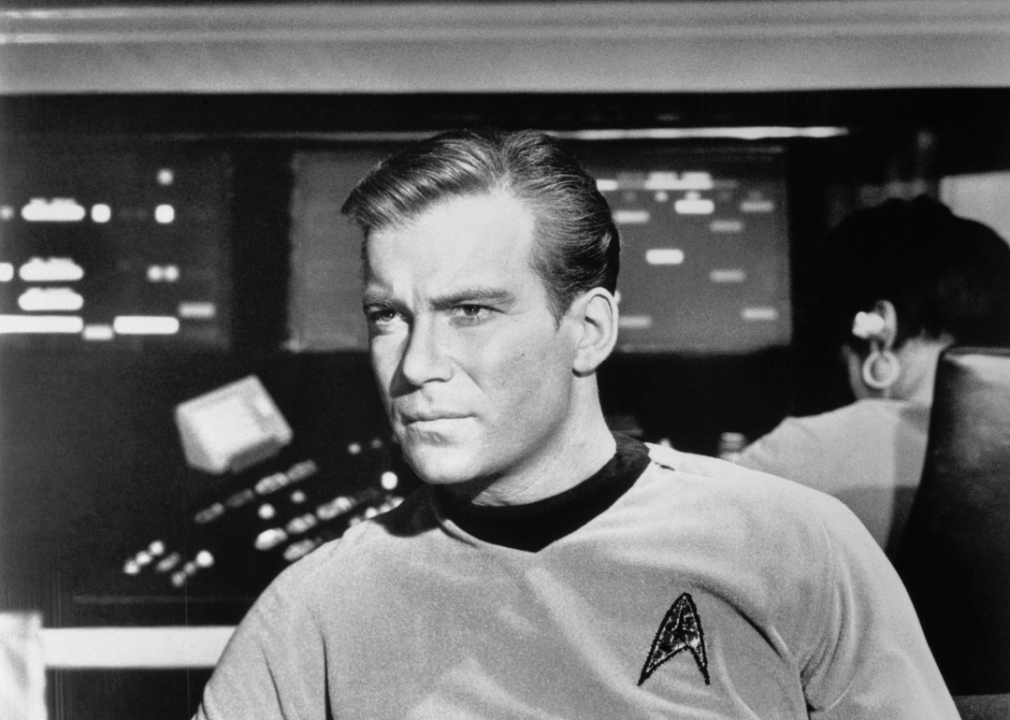
Best 'Star Trek' episodes
It's hard to think of a more everlasting and impactful science fiction property than "Star Trek." In 1966, what is now known as "Star Trek: The Original Series" premiered on NBC, the brainchild of creator, writer, and executive producer Gene Roddenberry. What made "Star Trek" unique for its time was its devotion to an optimistic vision of society, one where human civilization has moved past war and poverty, boldly going "where no man has gone before."
This utopian future was reflected by a diverse cast, with the crew of the USS Enterprise including a woman of African descent (Nyota Uhura, played by Nichelle Nichols) and an Asian man (Hikaru Sulu, played by George Takei). Starting in Season Two, "Star Trek" added a Russian character (Pavel Chekov, played by Walter Koenig) during a real-life period of tension between the U.S. and the Soviet Union. The cast was headlined by William Shatner as Captain James T. Kirk, Leonard Nimoy as First Officer Spock, and DeForest Kelley as Dr. Leonard McCoy.
Unlike the campier and fantastical sci-fi fare of the 1960s— like "Lost in Space" —"Star Trek" tackled issues not limited to racism, sexism, and nationalism, with episodic stories that served as allegories for present-day issues. One of the most commonly cited groundbreaking moments in "Star Trek" was a kiss between the characters of Kirk and Uhura in Season Three, one of the earliest on-screen interracial kisses .
While the original "Star Trek" was marred with low ratings on NBC, fan mail campaigns kept the show alive until its eventual cancellation in 1969. However, the series found new life in syndication in the 1970s, and the property has since grown into a multimedia franchise that includes 11 television shows and 13 theatrical movies.
To honor the original 79 episodes, Stacker gathered IMDb data for all episodes of the original "Star Trek" series and ranked the top 25 by user rating as of June 2023, with ties broken by the number of votes received. Read on to see if your favorite "Star Trek" episodes made the cut.
You may also like: 100 best episodes from TV dramas
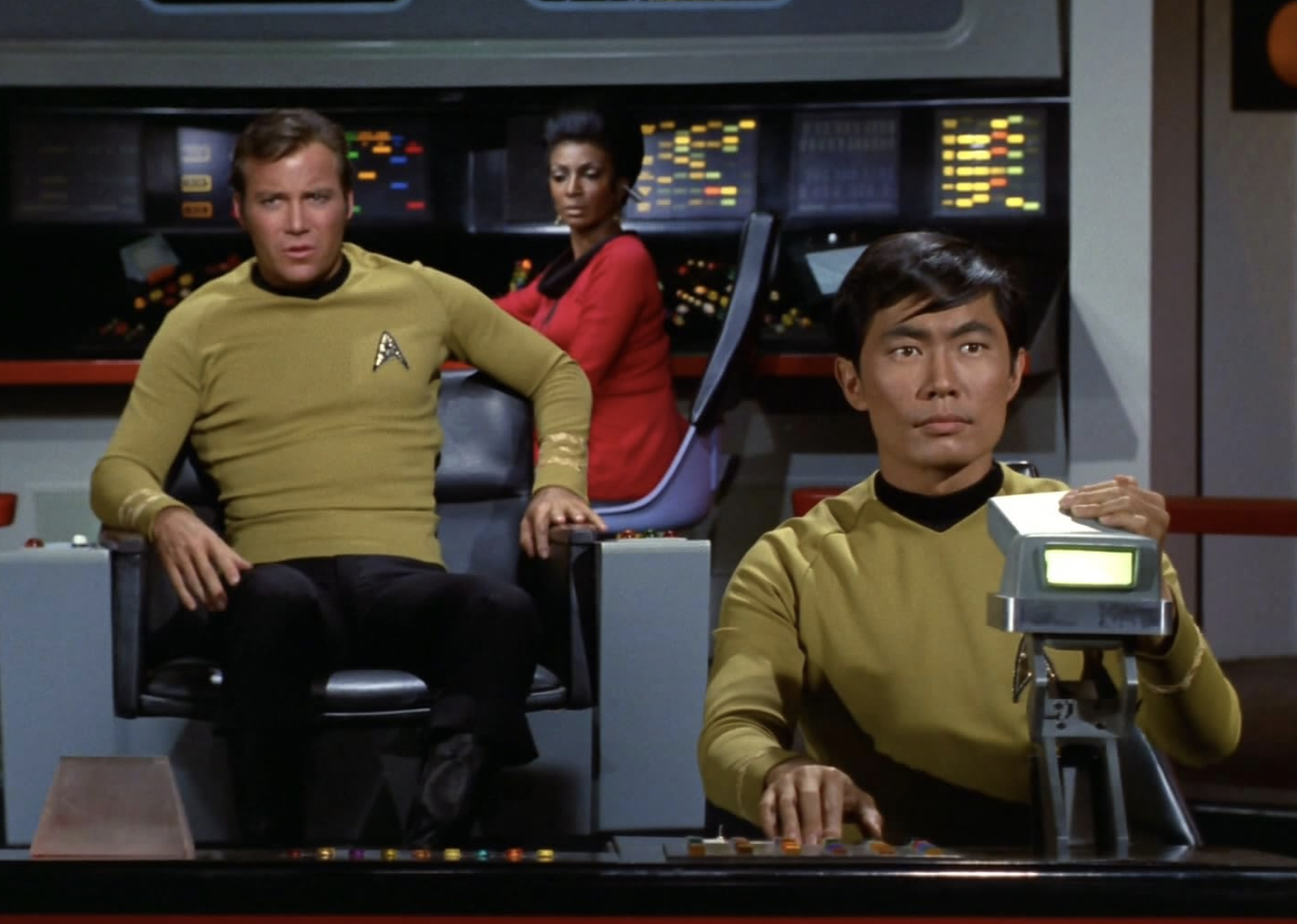
#25. Day of the Dove (1968)
- IMDb user rating: 7.7 - Season 3, Episode 7 - Director: Marvin J. Chomsky
The seventh episode of the third season of "Star Trek" once again pitted the Enterprise crew against the brutal Klingons. A being of pure energy creates confusion between the two factions, inserting false memories and creating conflict—in one instance, Chekov becomes aggressive towards the Klingons for killing a brother of his that never existed in the first place. The Klingon character of Kang, who originated from this episode, would return in the "Deep Space Nine" and "Voyager" shows decades later.
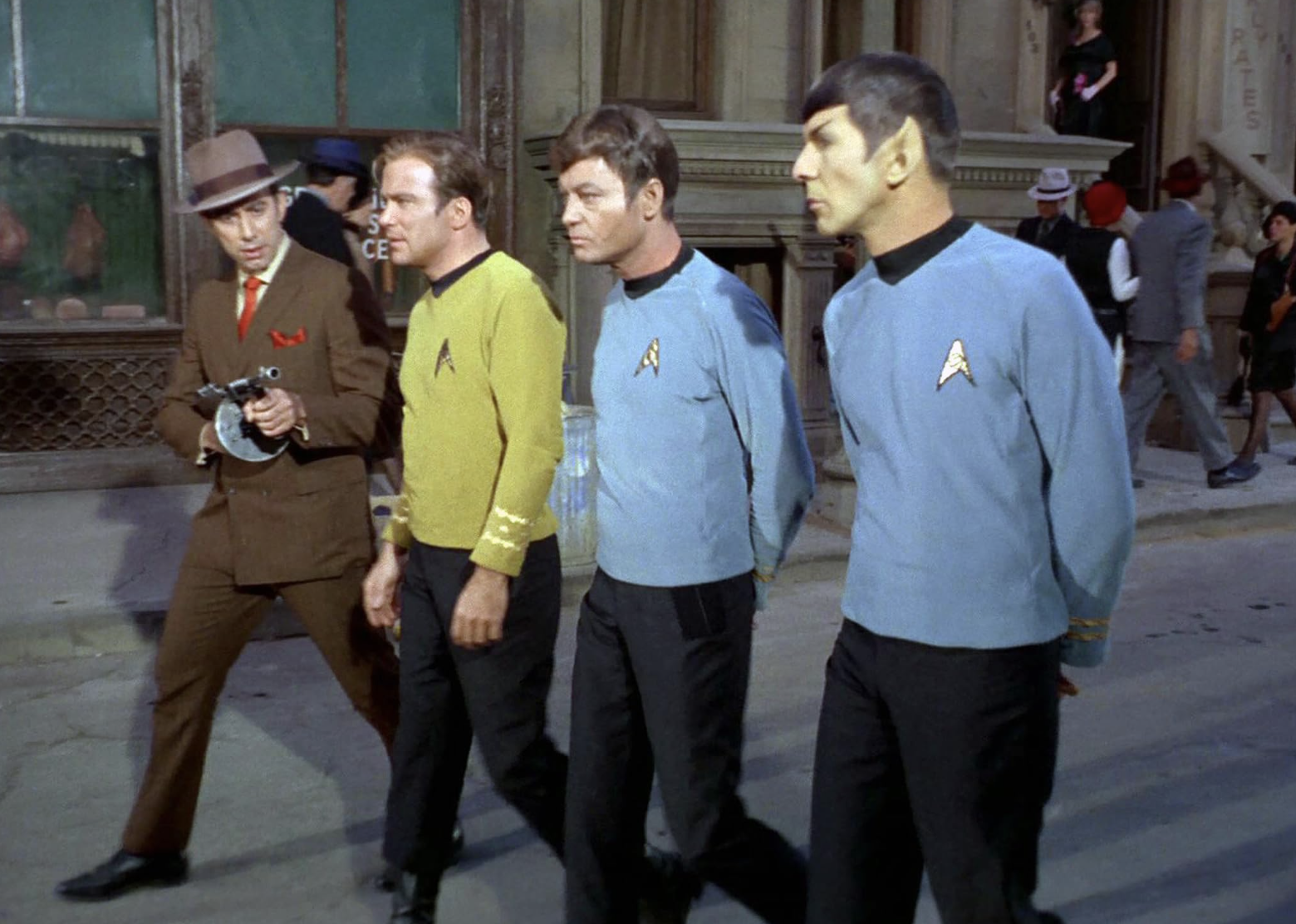
#24. A Piece of the Action (1968)
- IMDb user rating: 7.7 - Season 2, Episode 17 - Director: James Komack
Sometimes, "Star Trek" likes to incorporate time travel to create period-piece episodes, but in the case of Season Two, Episode 17, Kirk, Spock, and McCoy land on a planet that emulates 1920s Chicago gangster culture. With Tommy guns, fedoras, and pulpy 1920s dialogue, this fun episode goes through many of the classic gangster tropes. It's a memorable episode, particularly to writer-director Quentin Tarantino, who in the late 2010s wanted to direct a rated-R "Star Trek" movie inspired by the episode .
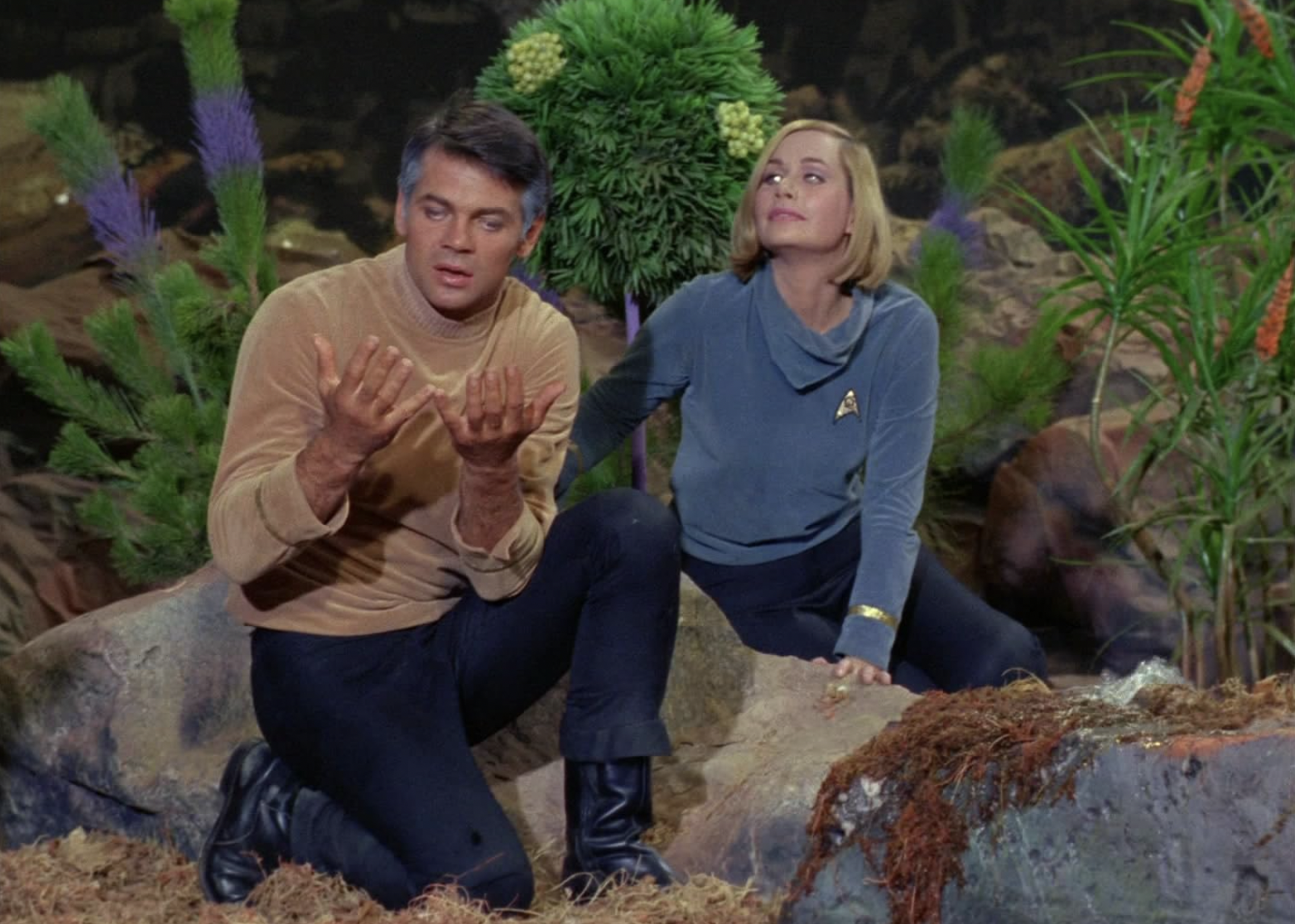
#23. Where No Man Has Gone Before (1966)
- IMDb user rating: 7.7 - Season 1, Episode 3 - Director: James Goldstone
The second pilot of "Star Trek" is titled after the famous mantra of the franchise, though "Where No Man Has Gone Before" was aired as the third episode of the first season. This episode was meant to introduce viewers to the general concepts of "Star Trek," with a standard mission gone awry—as a result, helmsman Gary Mitchell gains psychic and telekinetic powers, proclaiming himself to be god-like. "Above all else, a god needs compassion," Kirk says in one iconic scene when describing Mitchell's violent actions. As pivotal as the episode is, it lacks mainstay characters like McCoy and Uhura .
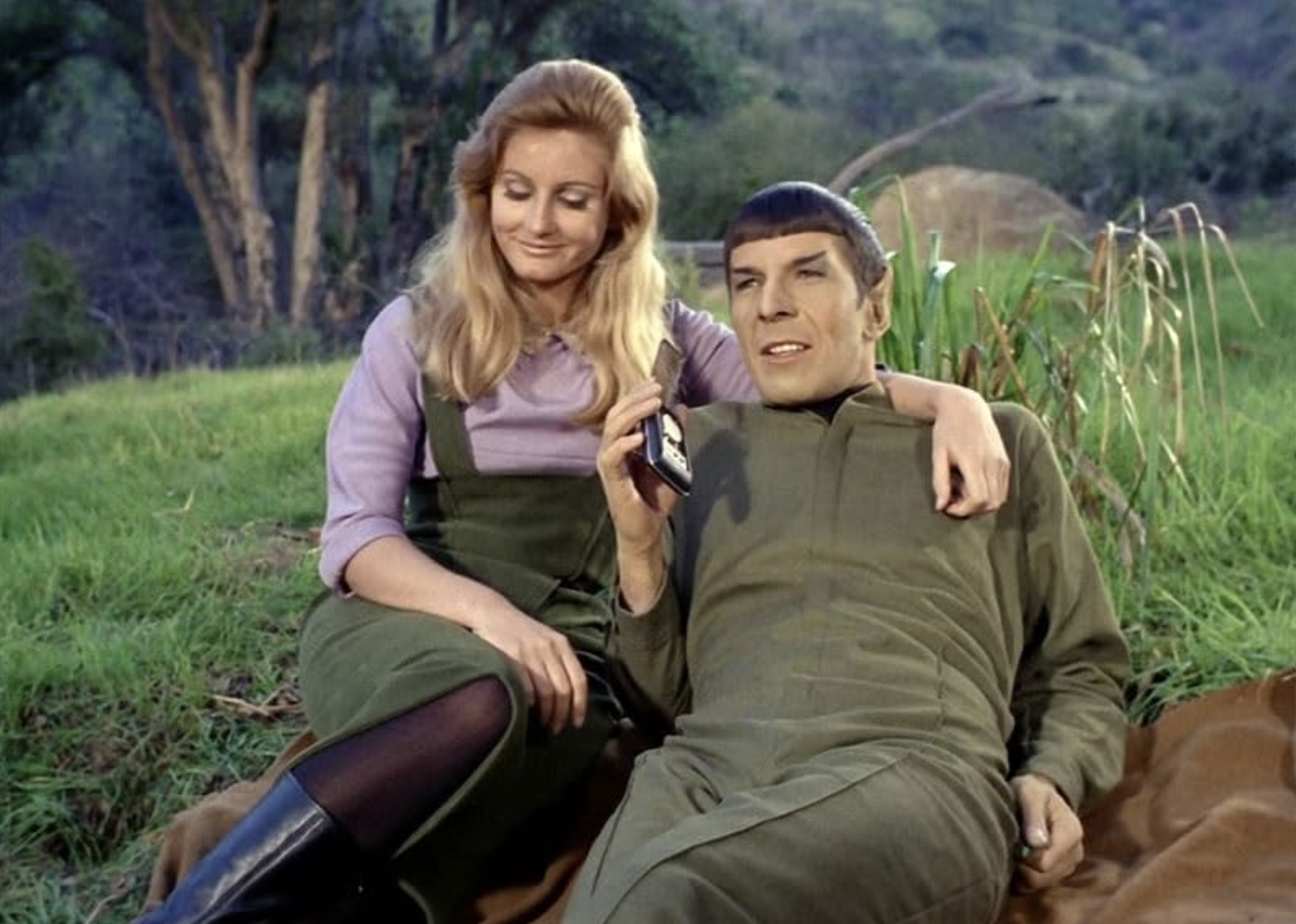
#22. This Side of Paradise (1967)
- IMDb user rating: 7.8 - Season 1, Episode 24 - Director: Ralph Senensky
Spock is often paired with short-term romantic interests in "Star Trek," and Episode 24 of the first season features one in the character Kalomi. Spock reunites with this botanist from his past on an away mission—he, Kirk, and McCoy beam down to a colony to find that all of its inhabitants are affected by spores that invoke an overly positive and lethargic attitude. For the half-human, half-Vulcan character Spock, it was another opportune time for him to explore his emotions as he found himself under the same influence.
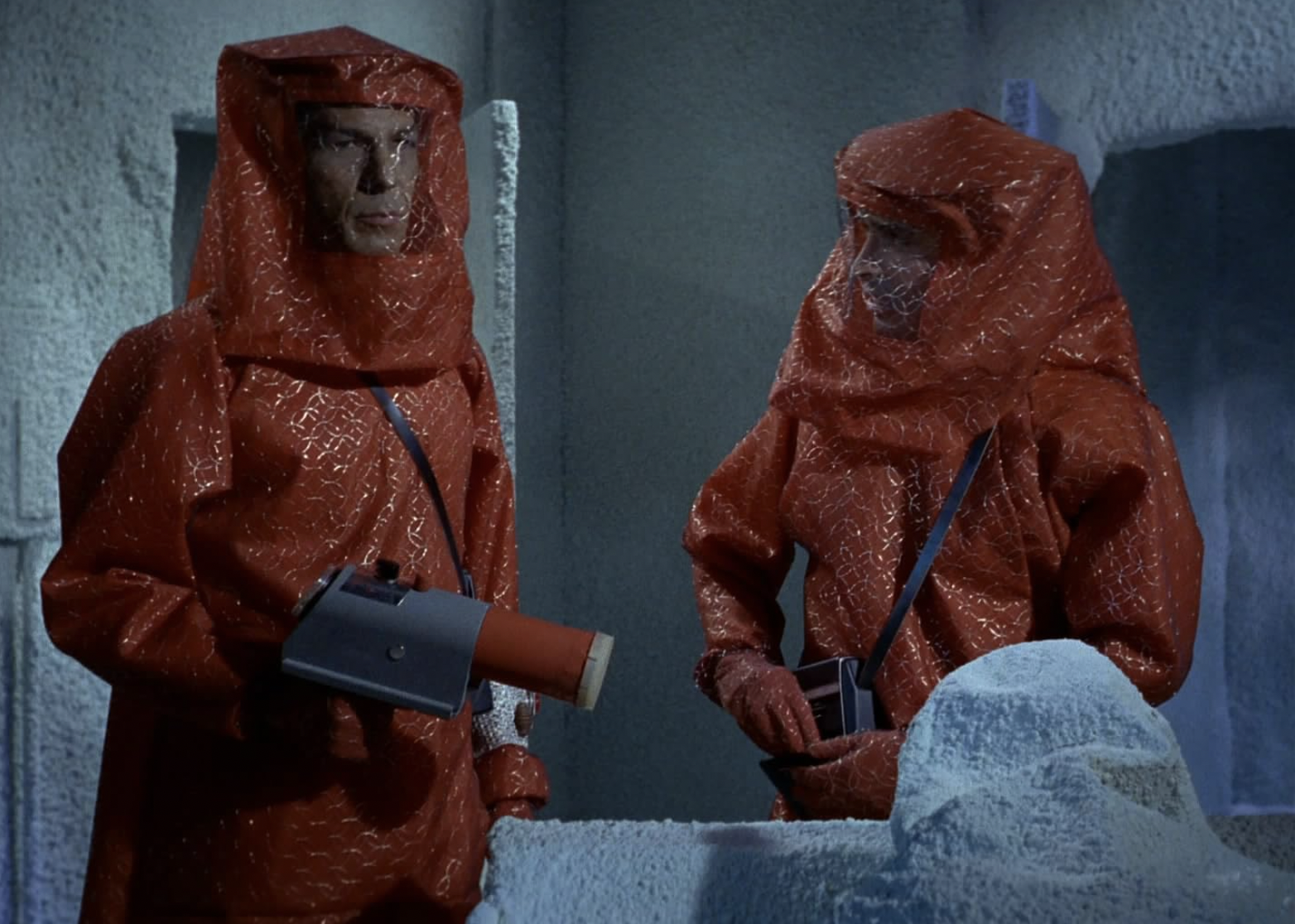
#21. The Naked Time (1966)
- IMDb user rating: 7.8 - Season 1, Episode 4 - Director: Marc Daniels
The fourth episode of the show as a whole let the cast members let loose and act out of character. "The Naked Time" starts with Spock and a lieutenant observing frozen corpses in an abandoned research facility—after which they inadvertently bring some sort of sickness to the Enterprise that makes everyone affected act irrationally. Spock sheds tears and has an intimate moment with Nurse Chapel, but in a sillier (and iconic) scene, a shirtless Sulu runs amok with a sword .
You may also like: Best Emmy-nominated shows of all time
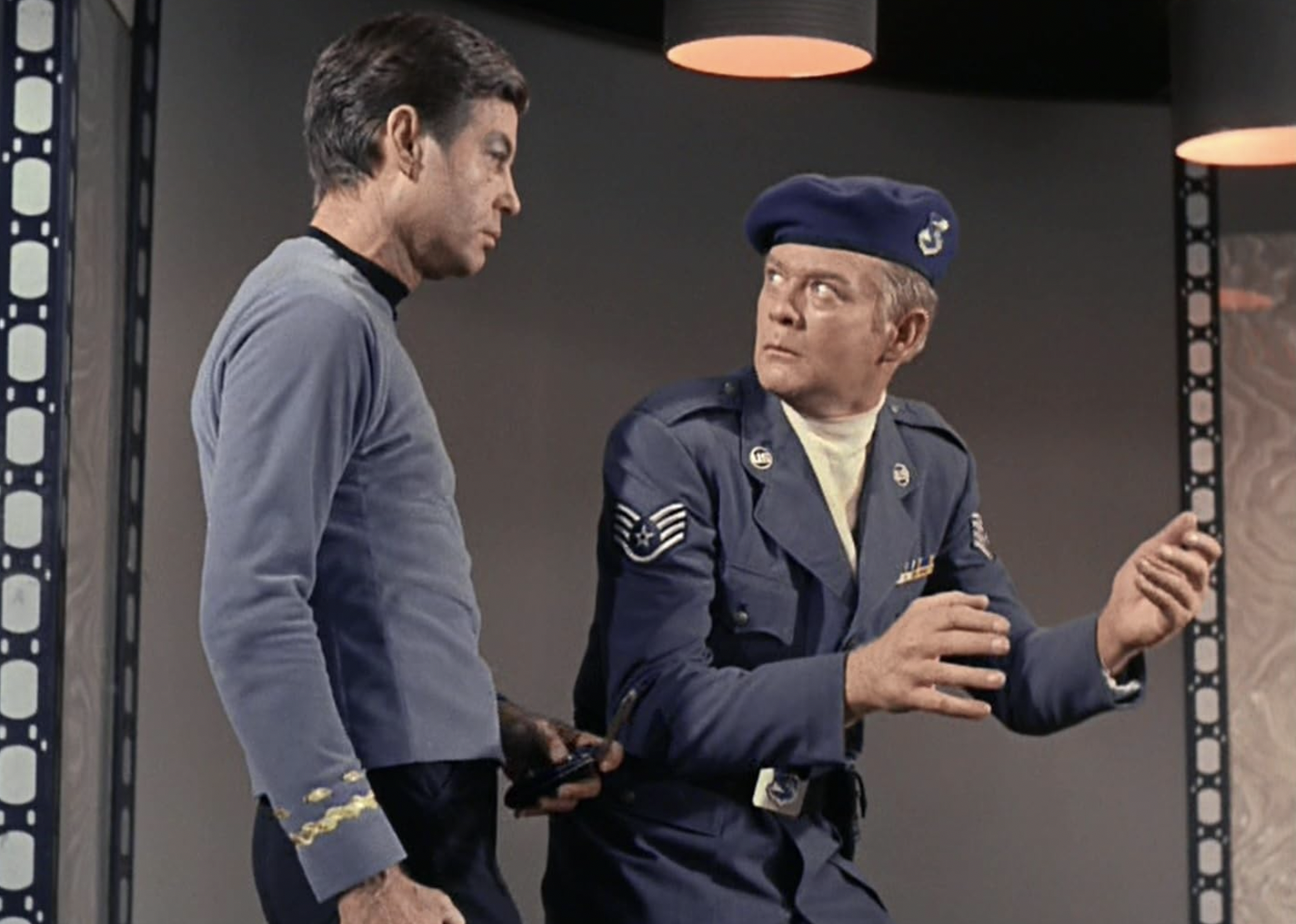
#20. Tomorrow Is Yesterday (1967)
- IMDb user rating: 7.9 - Season 1, Episode 19 - Director: Michael O'Herlihy
The 19th episode of "Star Trek" Season One is a time-travel story, with the Enterprise finding itself above 1960s Earth. A U.S. Air Force pilot named John Christopher flies up to identify the ship, only to be beamed up by the crew. What ensues is a race to scrub all evidence of the Enterprise's visit to the 1960s while containing Christopher, all while trying to return home. In terms of "Star Trek" lore, the Enterprise's method of returning to the future is used again in "Star Trek IV: The Voyage Home" and referenced in "Star Trek: Picard."

#19. Arena (1967)
- IMDb user rating: 7.9 - Season 1, Episode 18 - Director: Joseph Pevney
Episode 18 of "Star Trek" showcases some of Kirk's physical combat abilities as he is forced to fight a member of the reptile species known as the Gorn. The fight scene between Kirk and the Gorn captain was shot at the Vasquez Rocks , a location used so frequently by the franchise that it is nicknamed the "Star Trek Rocks." Modern audiences have mocked and parodied the fight scene , but its iconic status has never been disputed.
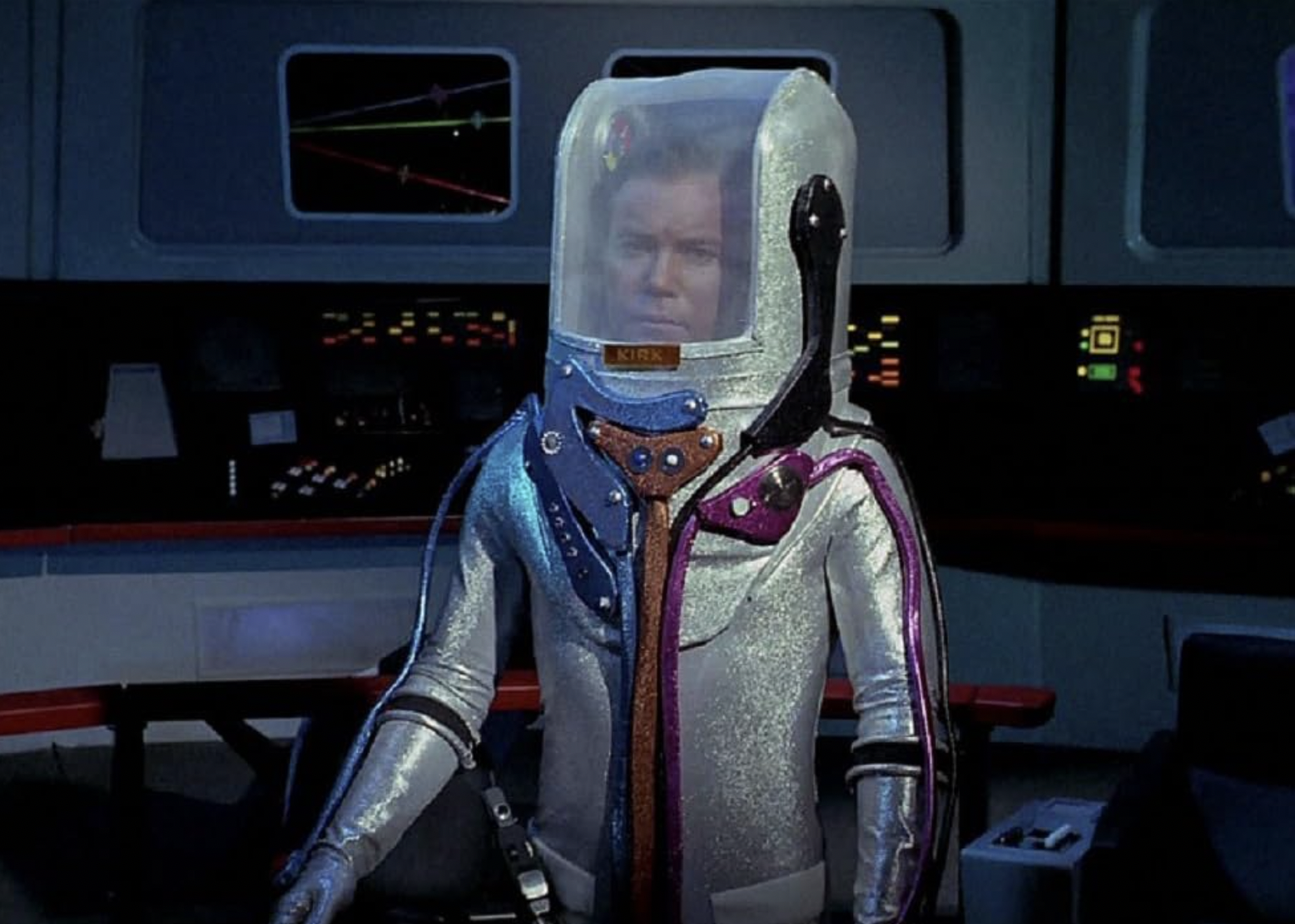
#18. The Tholian Web (1968)
- IMDb user rating: 8.0 - Season 3, Episode 9 - Directors: Herb Wallerstein, Ralph Senensky
Season Three, Episode 9 of "Star Trek" begins with the Enterprise searching for its sister ship, the Defiant. Unfortunately, the Defiant's crew had perished somehow, and the Enterprise crew find themselves up against interdimensional beings known as the Tholians. As they create an energy web around the entire Enterprise, Kirk is believed lost and the crew members begin to fall to the same madness that led to the Defiant crew's demise. The plotlines of the Defiant and the Tholian Web are followed up in the prequel show "Enterprise," in the 2005 two-part episode "In a Mirror, Darkly."
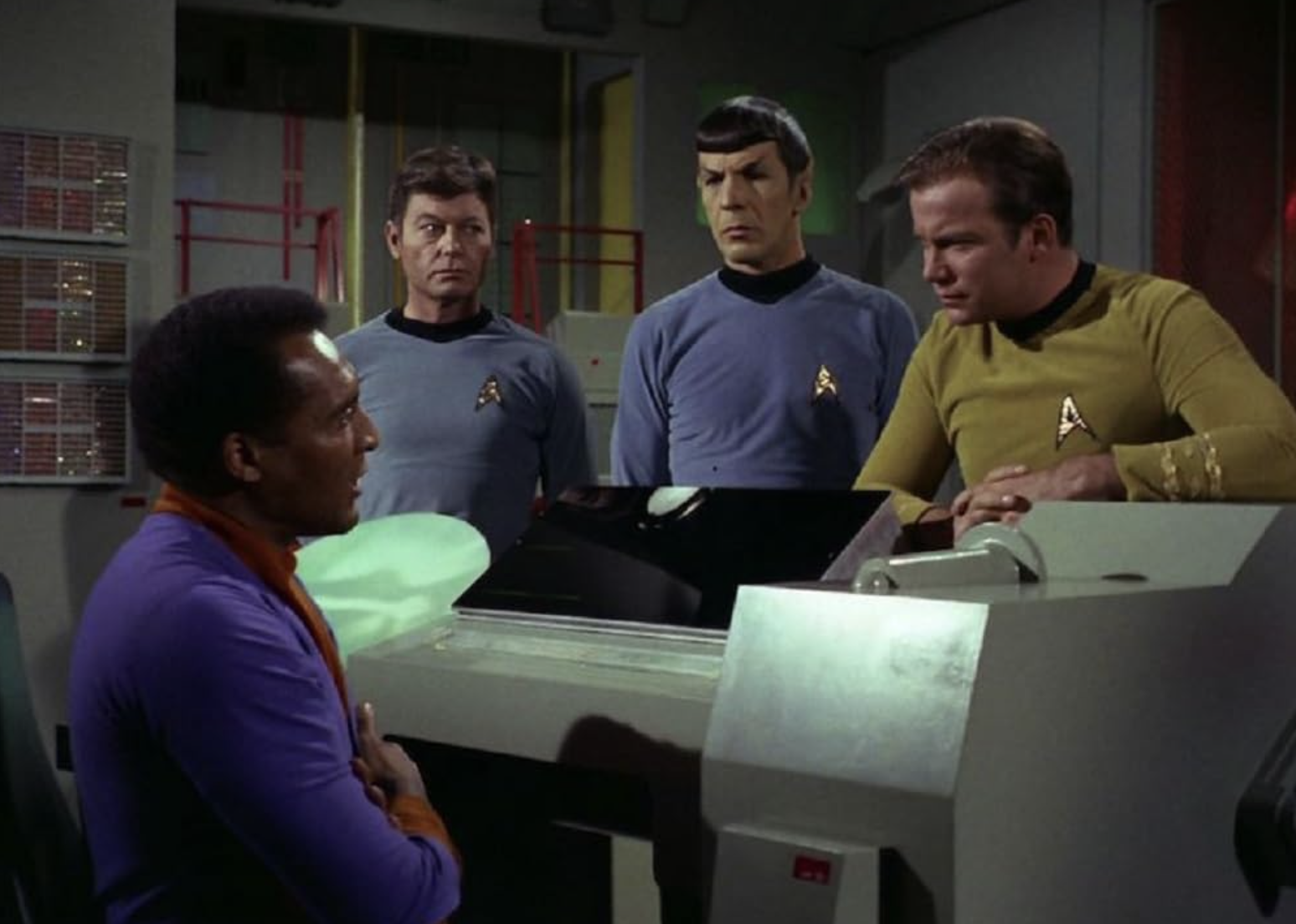
#17. The Ultimate Computer (1968)
- IMDb user rating: 8.0 - Season 2, Episode 24 - Director: John Meredyth Lucas
In a premise that still rings true today due to the prevalence of artificial intelligence, Season Two, Episode 24 features a computer named M-5, designed and built to handle all ship functions. Unsurprisingly, M-5 begins to turn malevolent, effectively trying to replace Kirk as the captain and attacking other Federation starships. "Computers make excellent and efficient servants, but I have no wish to serve under them," Spock tells Kirk at one point.
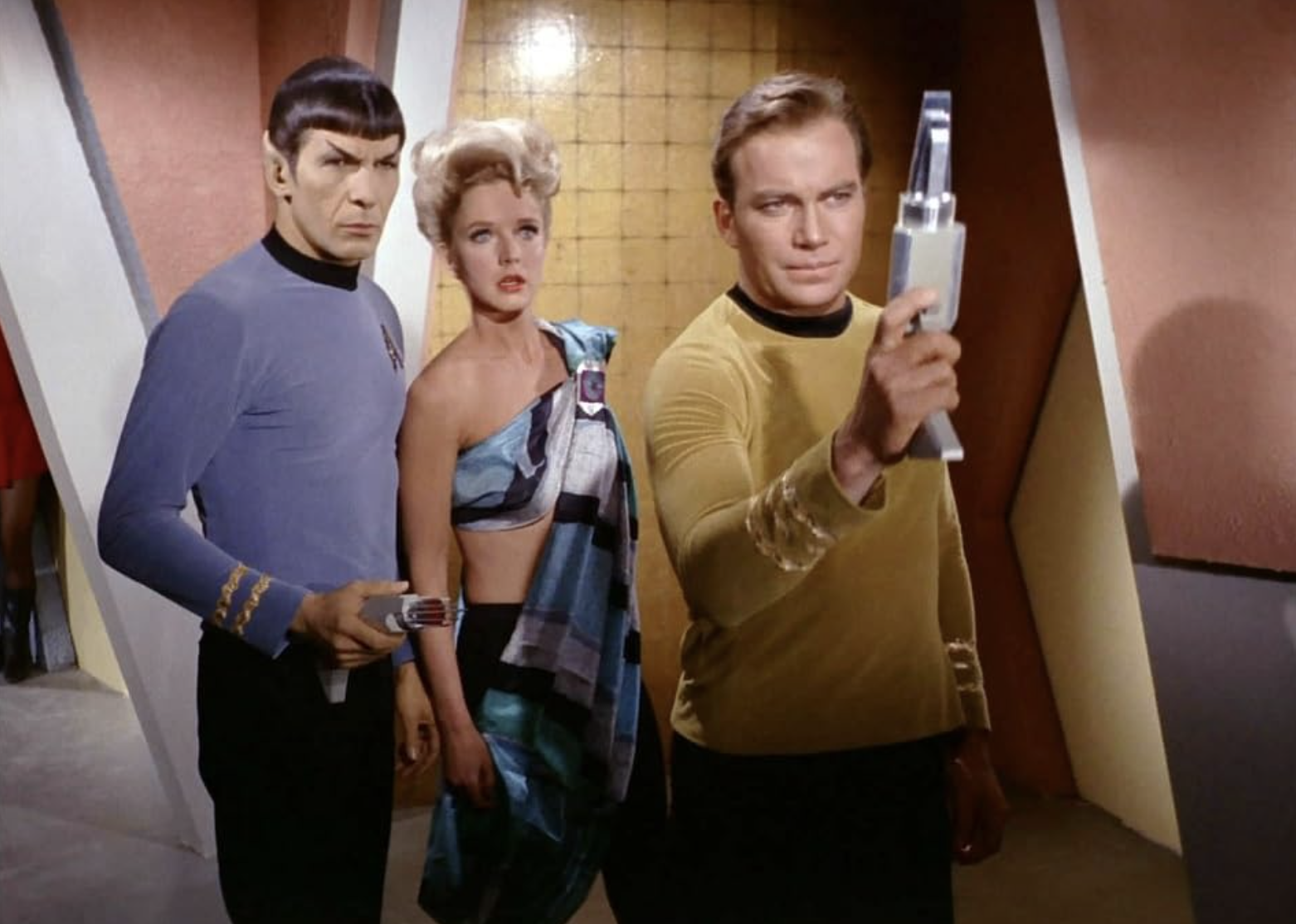
#16. A Taste of Armageddon (1967)
- IMDb user rating: 8.0 - Season 1, Episode 23 - Director: Joseph Pevney
Episode 23 of Season One features a rather unique sci-fi concept—a planet that fights war through virtual means. Kirk lands on a planet that is in conflict with another planet, and the long war between the two is fought in a simulation; when someone "dies" in the simulation, they are killed in real life. Unfortunately for Kirk, the Enterprise is destroyed in the simulation, but Kirk naturally refuses to destroy his ship and crew. Despite the dire premise, the resolution of the episode has fans believing it to be an overall optimistic story .
You may also like: Best 'Happy Days' episodes
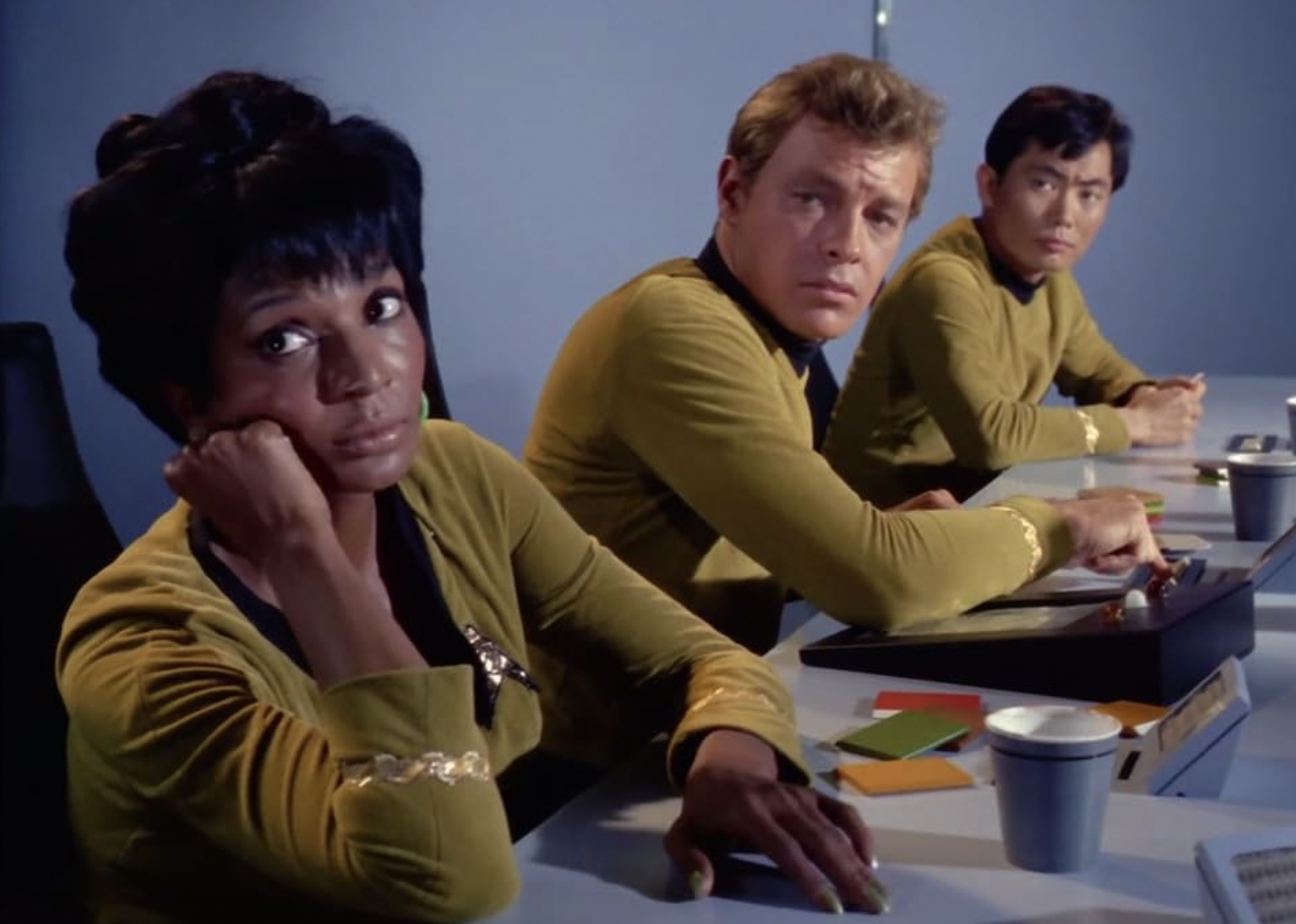
#15. The Corbomite Maneuver (1966)
- IMDb user rating: 8.0 - Season 1, Episode 10 - Director: Joseph Sargent
The 10th overall episode of "Star Trek" was the first to be shot after the pilot episode, and it features a memorable encounter with an alien named Balok (featured in the closing credits of the show). Balok claims that he is all-powerful and will destroy the Enterprise, giving the crew 10 minutes, but Kirk calls Balok's bluff. Summing up the lesson of the episode, Kirk remarks: "You know the greatest danger facing us is ourselves, an irrational fear of the unknown. But there's no such thing as the unknown—only things temporarily hidden, temporarily not understood."
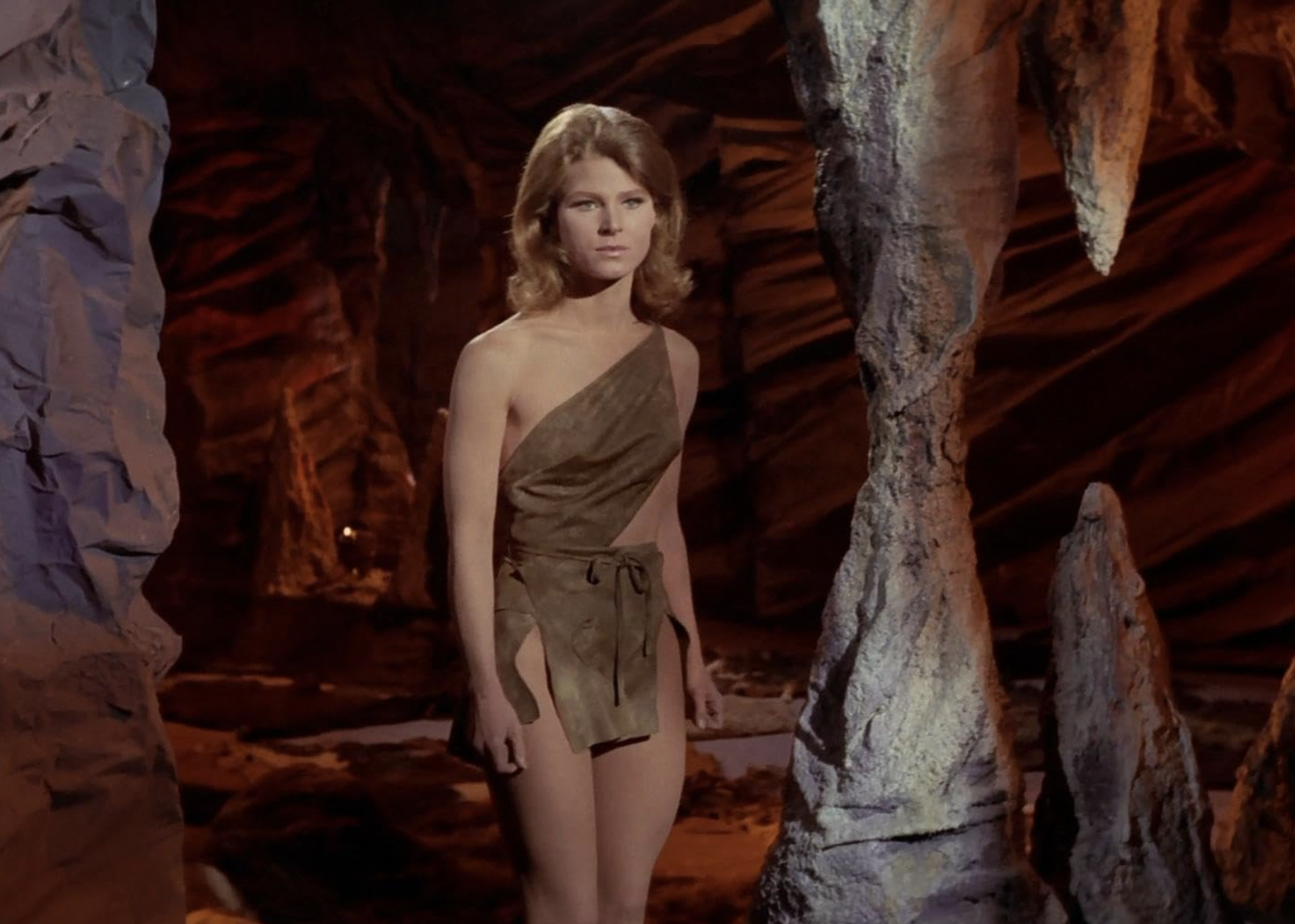
#14. All Our Yesterdays (1969)
- IMDb user rating: 8.1 - Season 3, Episode 23 - Director: Marvin J. Chomsky
Season Three, Episode 23 of "Star Trek" features some recurring tropes of the show, such as time travel and Spock having a brush with romance. The main trio of Kirk, Spock, and McCoy each end up in two distant time periods of a planet. Spock and McCoy encounter a woman named Zarabeth, whom McCoy is suspicious of and Spock falls in love with rather quickly. While most time-travel episodes center around Earth, using this narrative device to explore the past of an alien planet was thought to be unique by fans.
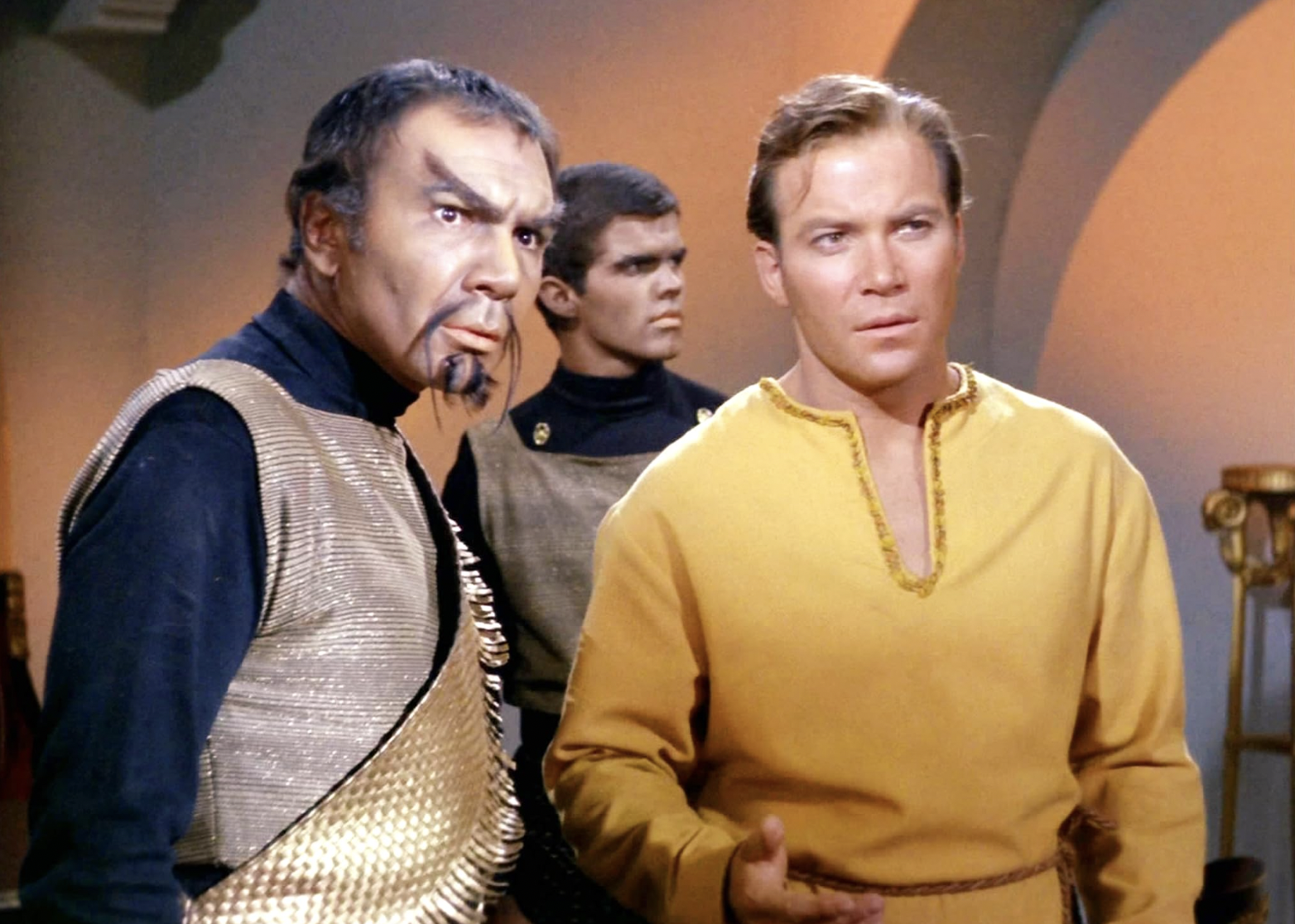
#13. Errand of Mercy (1967)
- IMDb user rating: 8.1 - Season 1, Episode 26 - Director: John Newland
Episode 26 of Season One utilizes the Klingons as the main foes, with "Errand of Mercy" depicting the beginning of a war between the Federation and the Klingon Empire. Kirk and Spock visit a neutral planet near the Klingon Border called Organia and attempt to convince its people to resist Klingon forces in this Cold War allegory episode . While the peaceful Organians appear to be primitive at first, they soon surprise Kirk and Spock as well as the Klingons. The main antagonist, the Klingon named Kor, returns in "Deep Space Nine."
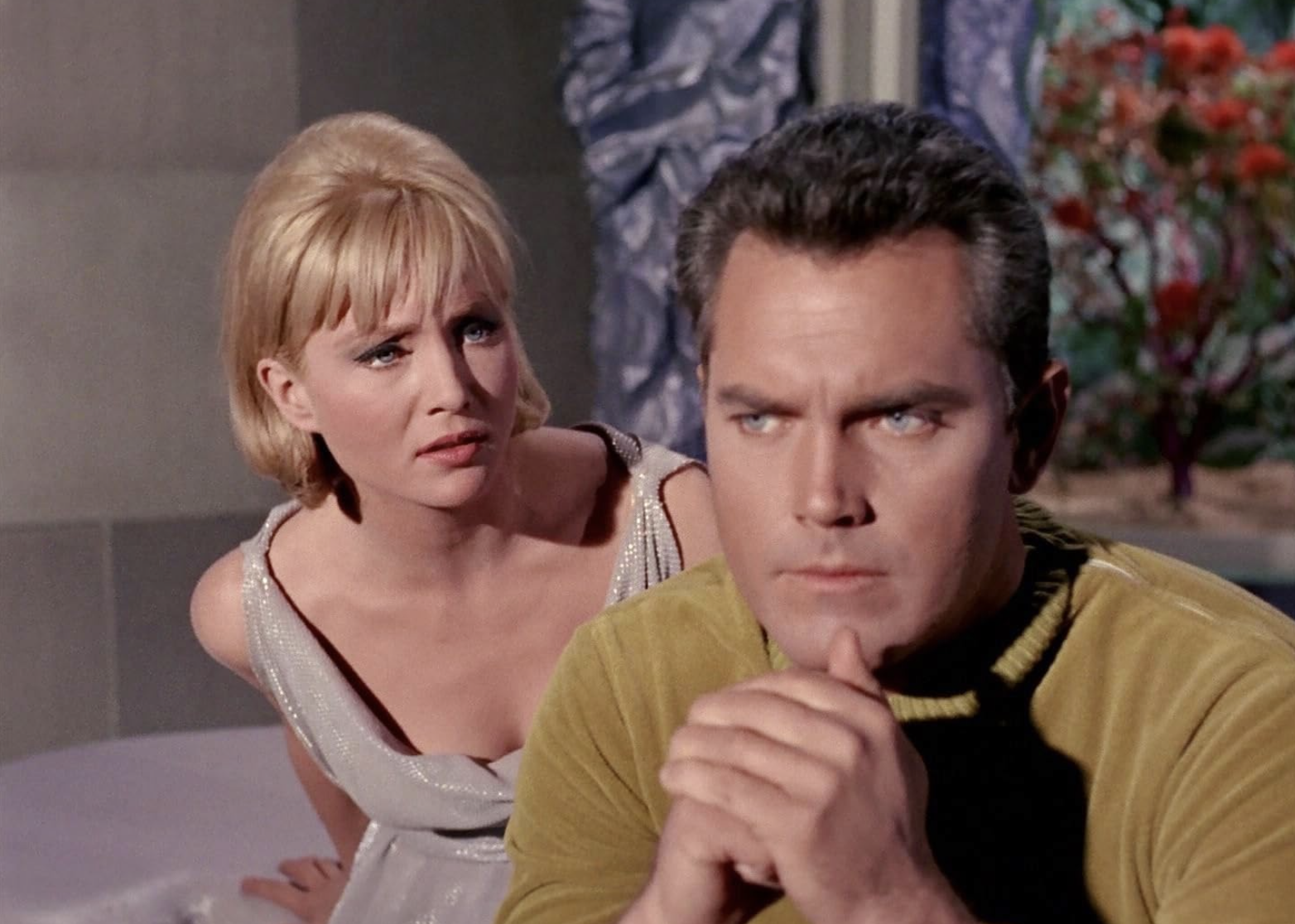
#12. The Menagerie: Part II (1966)
- IMDb user rating: 8.1 - Season 1, Episode 12 - Directors: Robert Butler, Marc Daniels
Spock is under court martial in Season One, Episode 12, in this conclusion to the previous episode. This second part features the psychic Talosian aliens more heavily, as well as the character of Number One, who is portrayed by Roddenberry's second wife, Majel Barrett. With the previous episode establishing Captain Pike's tragic injuries, this second half provides a happier ending for the former captain of the Enterprise.
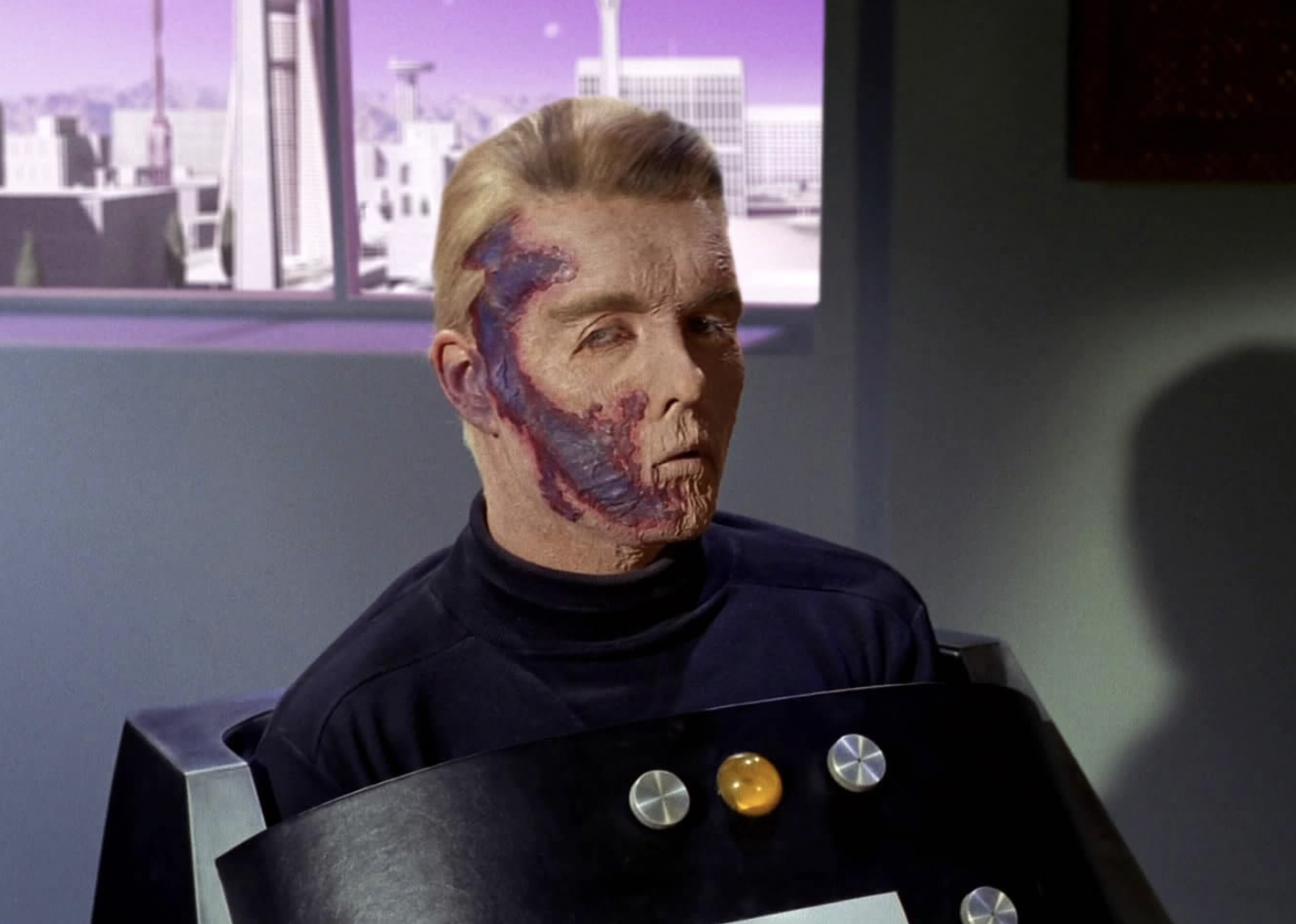
#11. The Menagerie: Part I (1966)
- IMDb user rating: 8.2 - Season 1, Episode 11 - Directors: Marc Daniels, Robert Butler
Season One, Episode 11 revisited events from the unaired pilot episode of "Star Trek," titled "The Cage." That pilot had featured Captain Pike (Jeffrey Hunter) instead of Kirk, but "The Menagerie" clarifies that Pike was the captain of the Enterprise before Kirk. At this point in time, Pike has been horrifically injured, bound to a chair, and only able to communicate through beeps. Pike and Spock once again end up on the planet Talos IV for some unfinished business, and the episode utilizes footage from "The Cage" extensively as flashbacks for budgetary reasons.
You may also like: Best 'Golden Girls' episodes
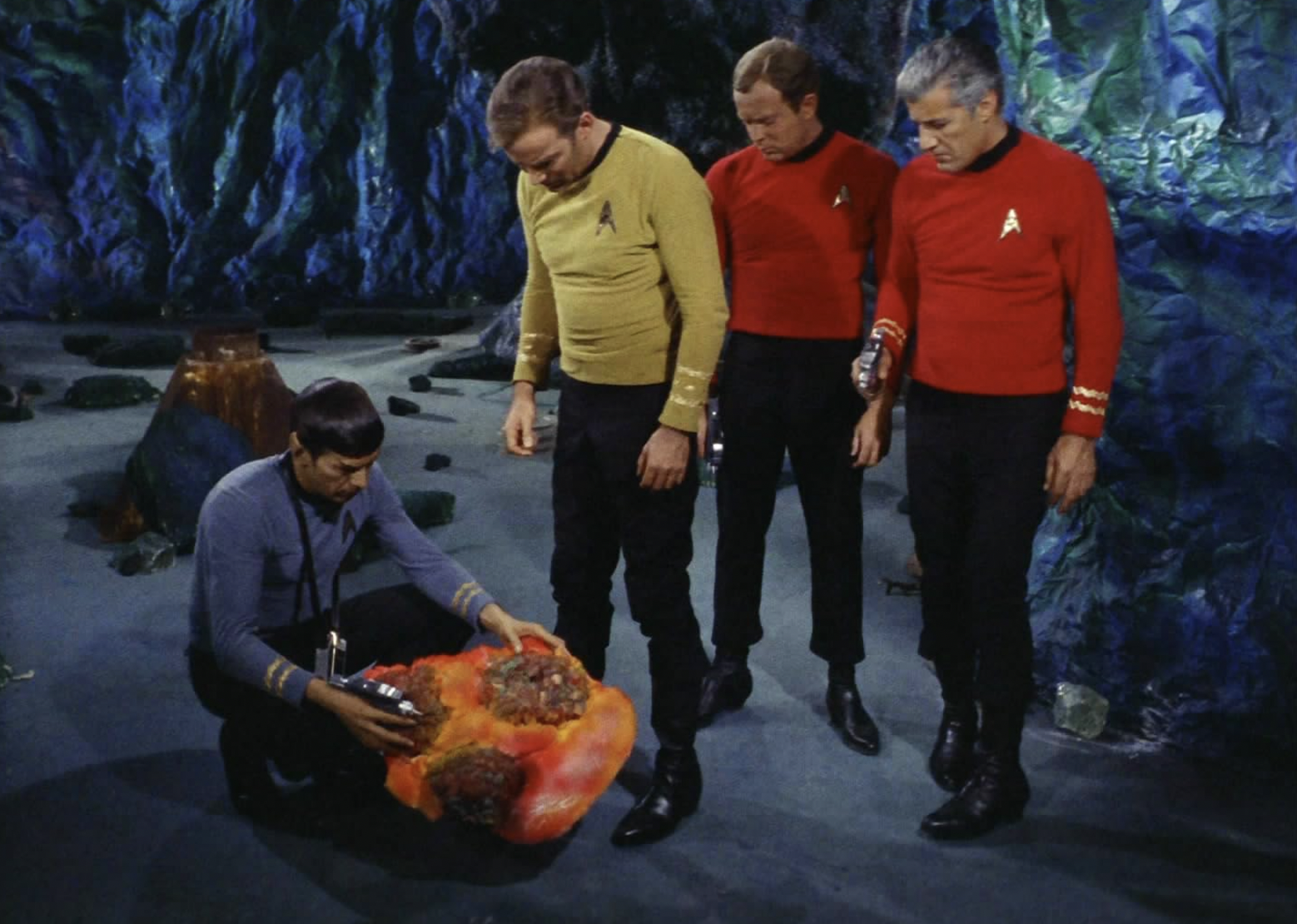
#10. The Devil in the Dark (1967)
- IMDb user rating: 8.3 - Season 1, Episode 25 - Director: Joseph Pevney
"Star Trek" is arguably its most memorable when it teaches viewers about compassion and pacifism, and Episode 25 of the first season very much demonstrates this. Kirk, Spock, and McCoy begin to assist a mining colony dealing with a creature responsible for killing workers. Upon encountering the creature, the main characters begin to understand its nature better, and instead spare it and cure it, facilitating a symbiotic relationship between the creature and the miners.
William Shatner considers the episode one of his favorites, but behind the scenes, Shatner's father passed away during production , necessitating the temporary use of a body double while he attended his father's funeral.
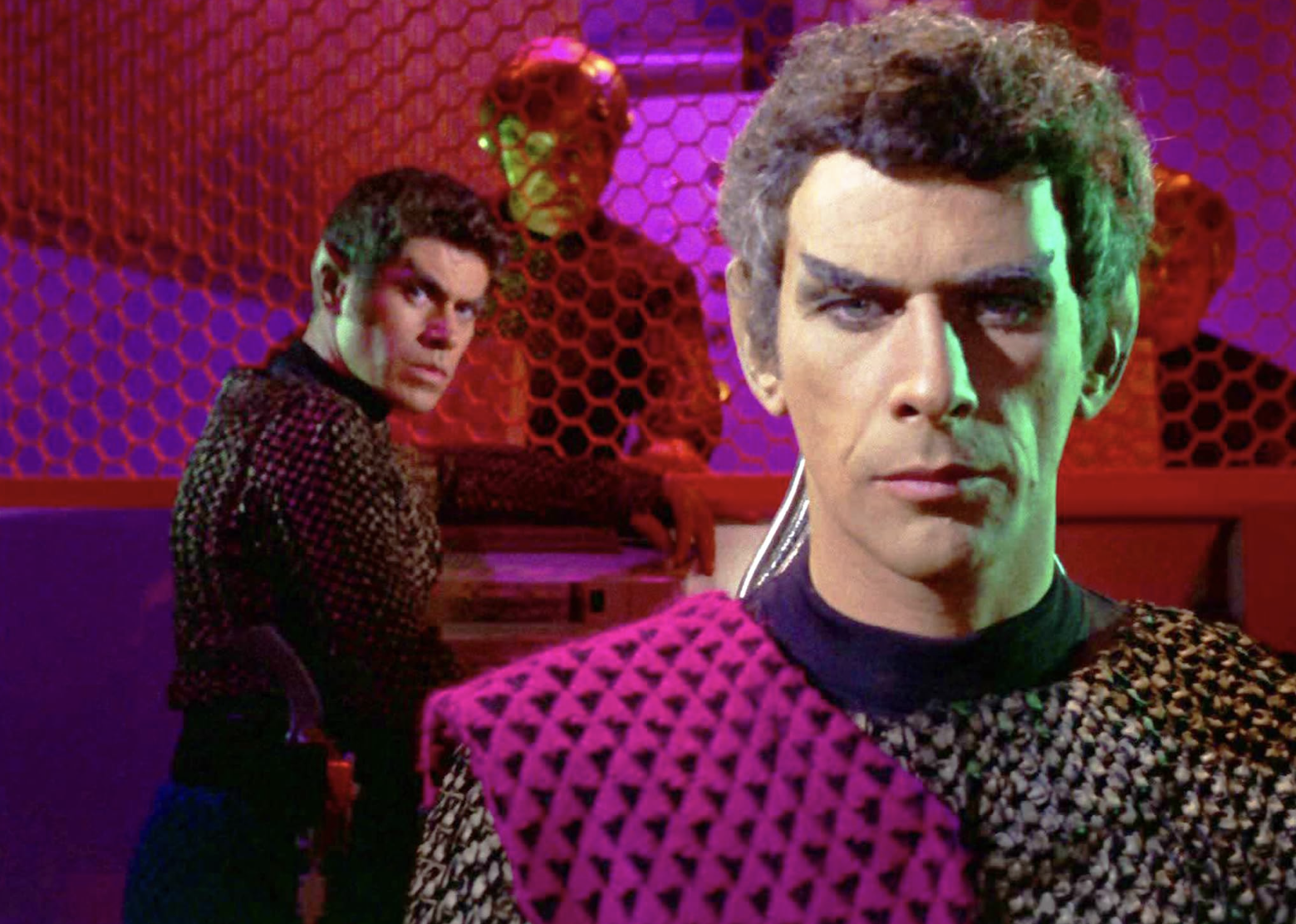
#9. The Enterprise Incident (1968)
- IMDb user rating: 8.4 - Season 3, Episode 2 - Director: John Meredyth Lucas
The writers of "Star Trek" loved to use sudden irrational behavior by the characters as plot devices, and Episode 2 of the third season features Captain Kirk going off the rails. The Enterprise is on a secret mission to steal a Romulan cloaking device, and they encounter a female Romulan commander who eventually takes an interest in Spock. Kirk acts erratically through the episode and is even declared unfit to captain, leading to a dramatic episode overall.
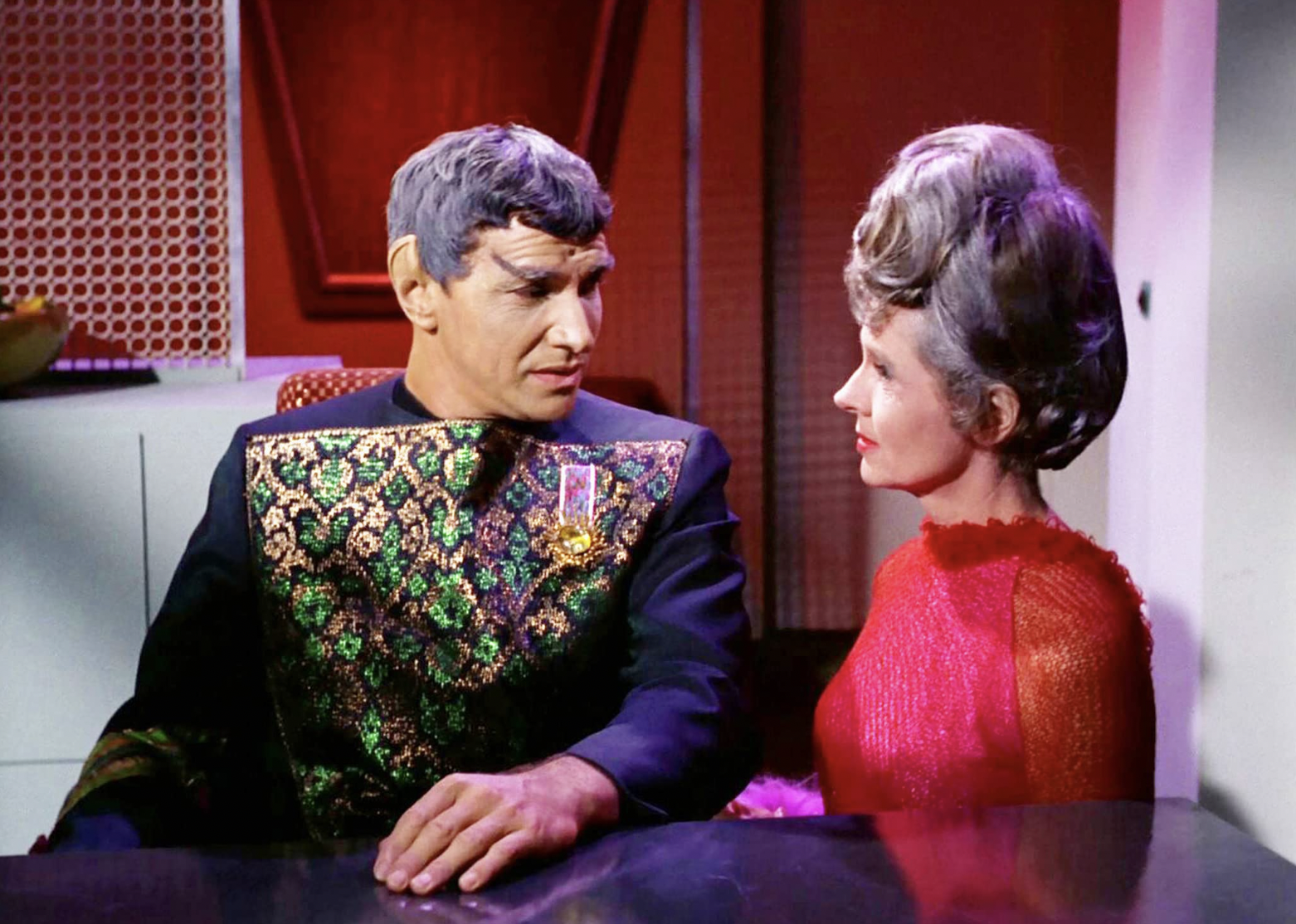
#8. Journey to Babel (1967)
- IMDb user rating: 8.5 - Season 2, Episode 10 - Director: Joseph Pevney
Some significant characters in "Star Trek" lore make their first appearance in Episode 10 of Season Two, as Spock's parents Sarek and Amanda (the latter being human) feature heavily. Sarek, an ambassador, is wrongly accused of murdering a foreign dignitary, and it's up to Spock to clear his name. While Sarek and Amanda made more appearances in future "Star Trek" media, this episode is their only appearance in the original series.
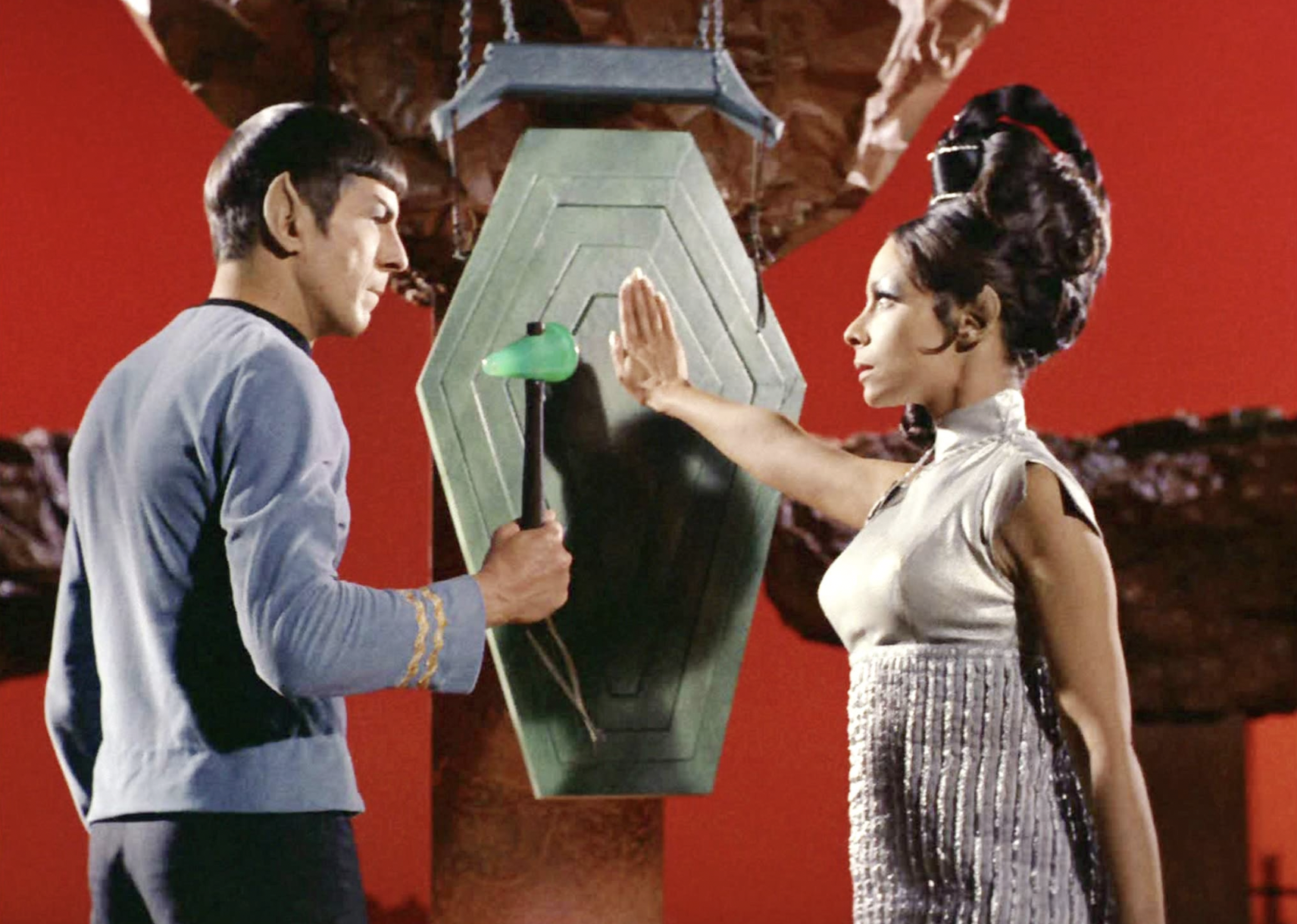
#7. Amok Time (1967)
- IMDb user rating: 8.6 - Season 2, Episode 1 - Director: Joseph Pevney
The season premiere of "Star Trek" Season Two introduced concepts that would permeate larger popular culture. Spock's bizarre behavior leads the characters to learn about pon farr, a physiological phenomenon related to Vulcan mating. Viewers meet Spock's betrothed, a Vulcan named T'Pring, and the iconic Vulcan salute is used for the first time in this episode. The events culminate in a fight between Kirk and Spock, with the scene and its incidental music parodied in movies like "The Cable Guy" and shows including "Futurama."
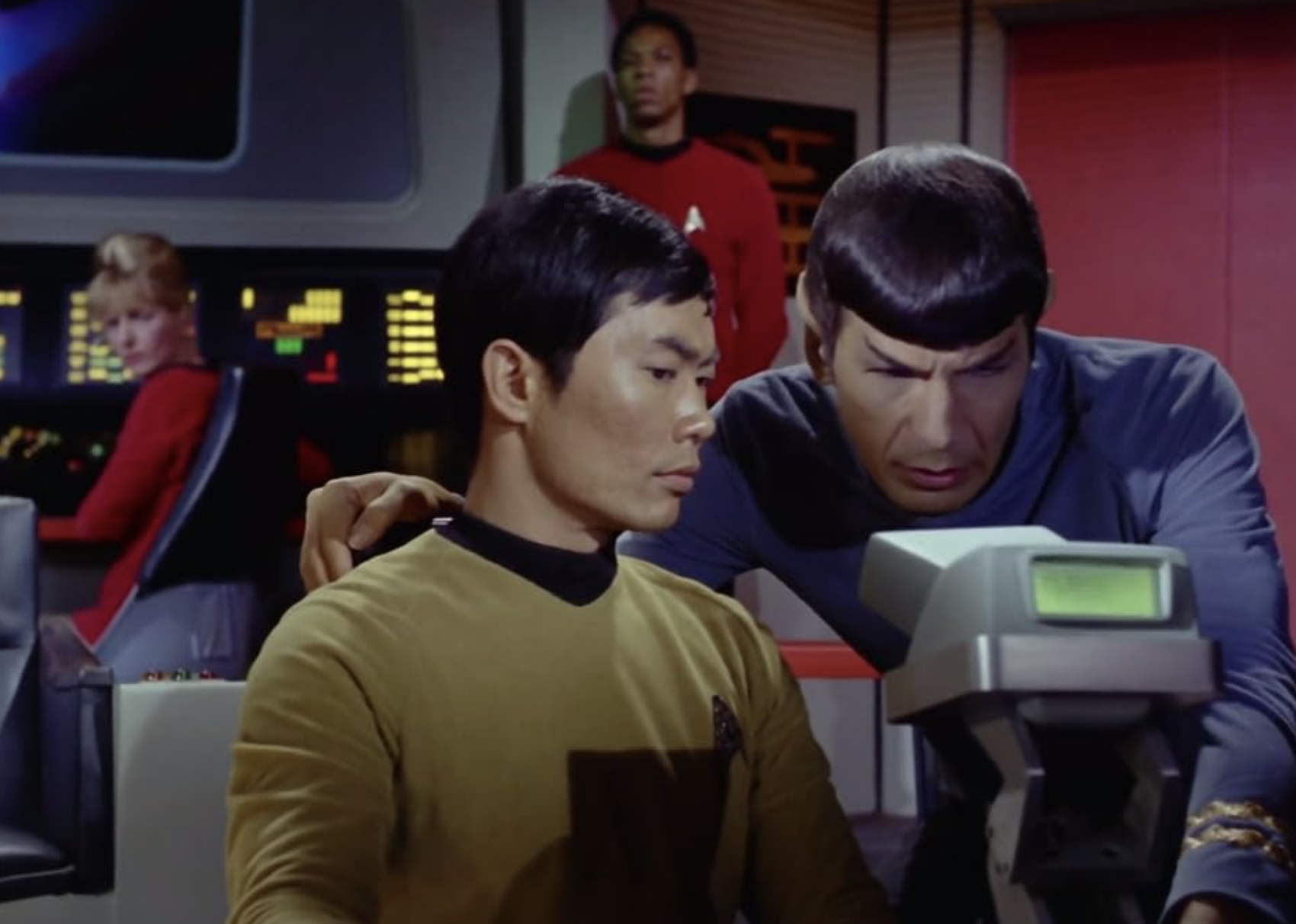
#6. The Doomsday Machine (1967)
- IMDb user rating: 8.7 - Season 2, Episode 6 - Director: Marc Daniels
Catastrophic destruction is the main threat of Season Two, Episode 6, aptly titled "The Doomsday Machine." The Enterprise finds that one of its sister ships, the Constellation, has been heavily damaged by a machine capable of destroying planets. Matt Decker, one of the ship's survivors, goes on a mad campaign against the machine, jeopardizing the Enterprise in the process. While Decker doesn't make it by the end of the episode, his son Willard Deckard is a main character in 1979's "Star Trek: The Motion Picture."
You may also like: Most popular TV shows on Max this week
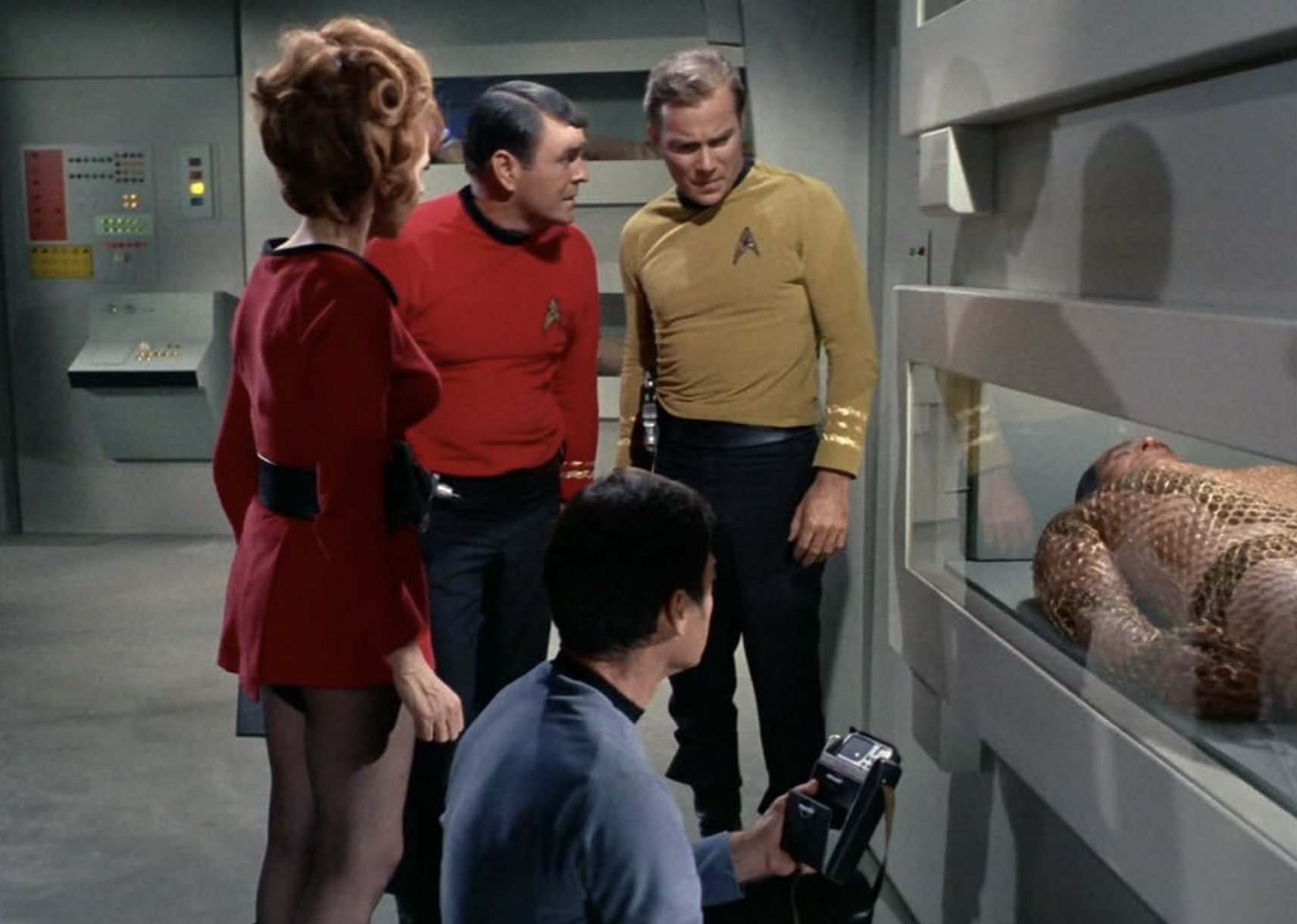
#5. Space Seed (1967)
- IMDb user rating: 8.7 - Season 1, Episode 22 - Director: Marc Daniels
Episode 22 of the first season introduced perhaps the most recognizable villain in all "Star Trek" media: Khan Noonien Singh, portrayed by Ricardo Montalbán. A genetically engineered man from the past, Khan attempts to lead his people in overthrowing the Enterprise. While Khan was thwarted and exiled, he would later return in "Star Trek II: The Wrath of Khan," widely thought to be the greatest "Star Trek" movie in the franchise .
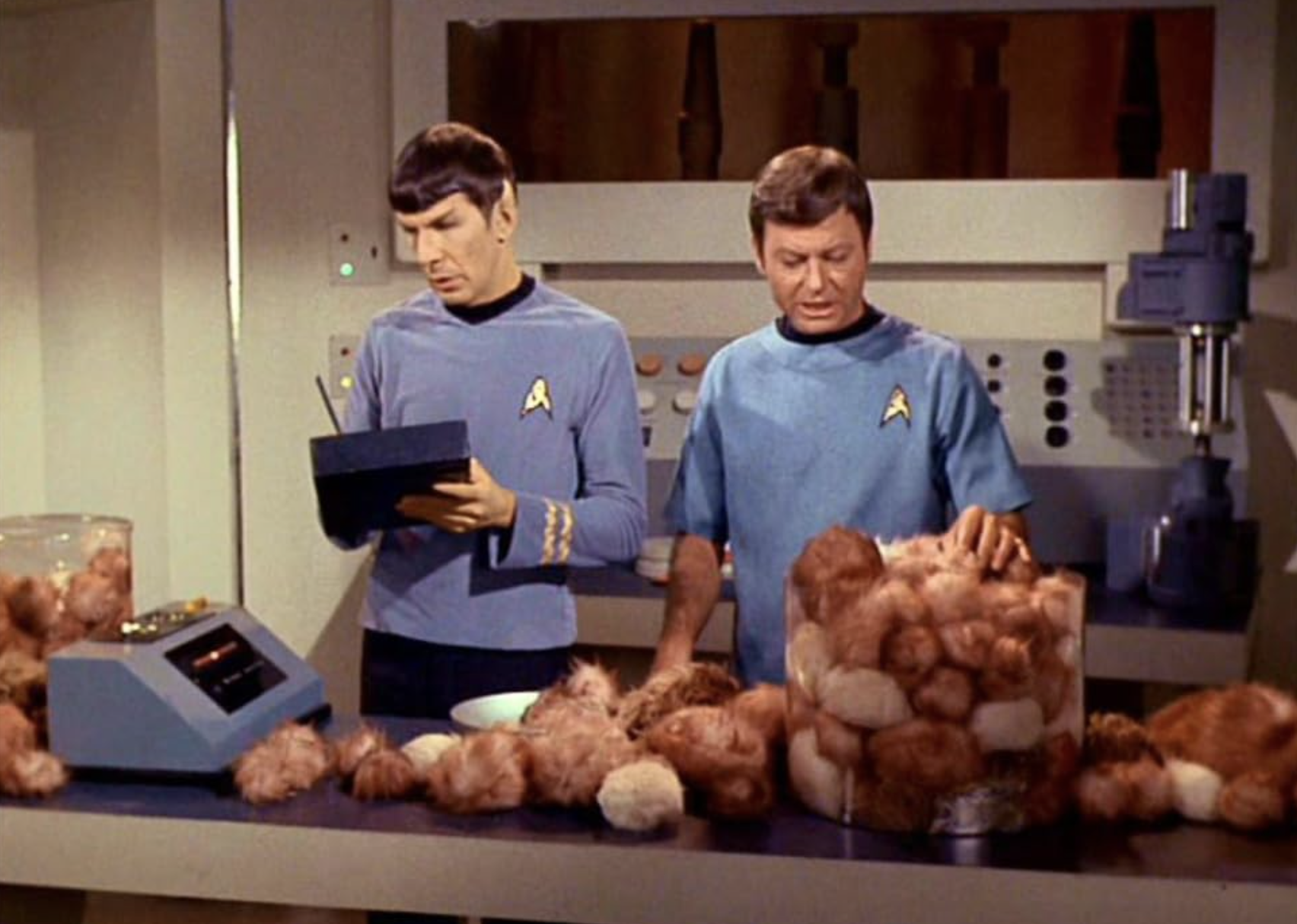
#4. The Trouble with Tribbles (1967)
- IMDb user rating: 8.8 - Season 2, Episode 15 - Director: Joseph Pevney
"Star Trek" isn't just political allegory and technobabble—there has to be levity sometimes as well. Enter the tribbles, cute little fuzzy creatures that create a problem for the Enterprise, as a tribble found in a space station begins multiplying rapidly. Meanwhile, conflict arises between Enterprise crew members and Klingons, culminating in a brawl in the space station. For the 30th anniversary of "Star Trek," an episode of "Deep Space Nine" titled "Trials and Tribble-ations" revisited the events of this episode, digitally inserting the "Deep Space Nine" cast into the events of the original episode.

#3. Balance of Terror (1966)
- IMDb user rating: 8.8 - Season 1, Episode 14 - Director: Vincent McEveety
Episode 14 of the first season of "Star Trek" is essential viewing, as it introduces the antagonistic Romulan race, a staple of the "Star Trek" universe. The centerpiece of this action-packed episode is a cat-and-mouse game between the Enterprise and a Romulan vessel with cloaking capabilities, leading to exciting and tense encounters. It's an episode full of high emotion that explores the effect and ramifications of war, with Kirk and the Romulan commander speculating that in another life, perhaps they could have been friends.
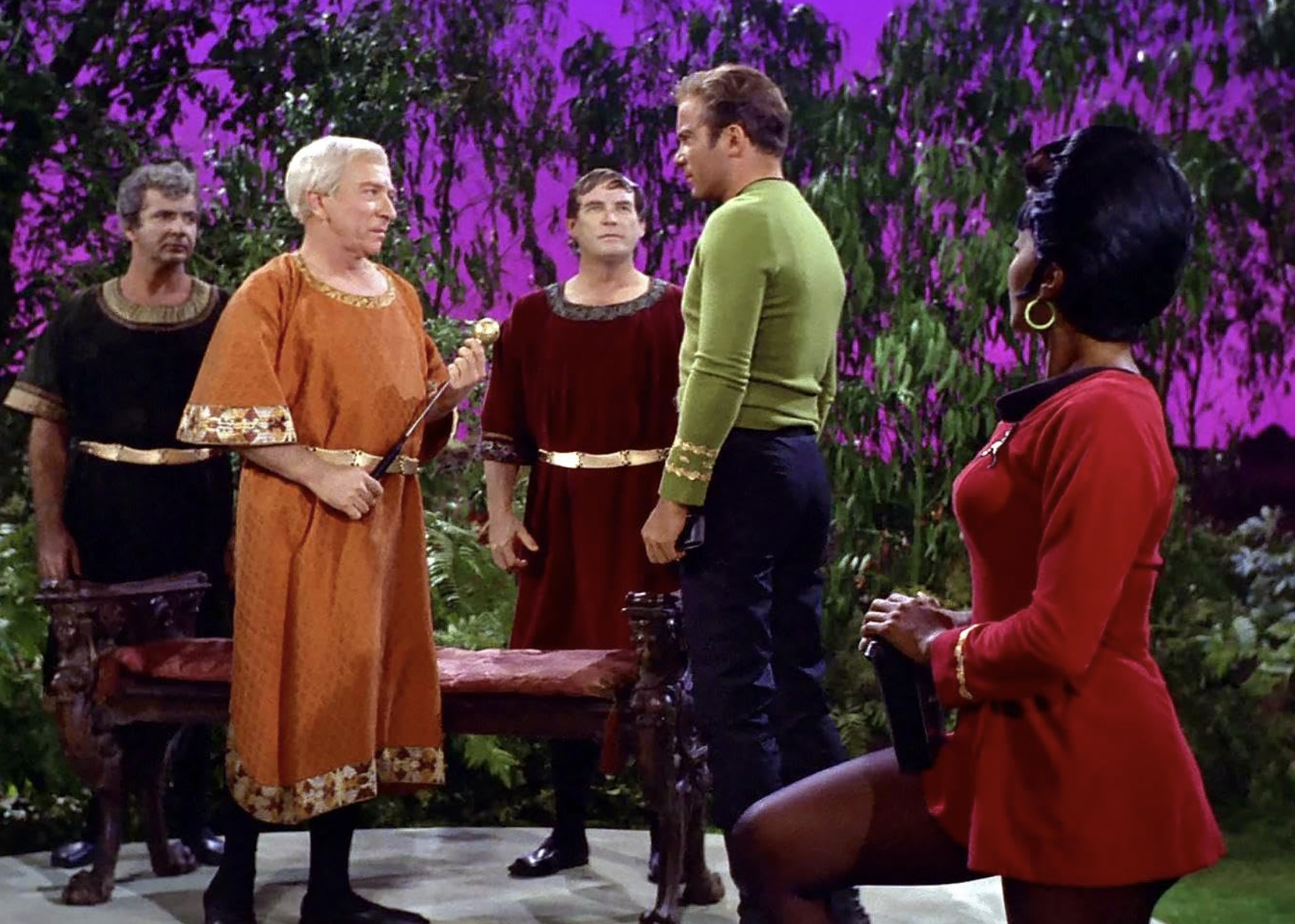
#2. Mirror, Mirror (1967)
- IMDb user rating: 9.0 - Season 2, Episode 4 - Director: Marc Daniels
Episode 4 of Season Two of "Star Trek" had the first look into another dimension within the lore, often referred to as the Mirror Universe. In this reality, the Federation is instead the Terran Empire, which is aggressive and militaristic in nature. The USS Enterprise is instead the ISS Enterprise, torture in the Agony Booth is the main form of discipline, and Mirror Spock famously fashions a goatee . The Mirror Universe has become a mainstay in most "Star Trek" shows, and the use of a beard to signify an evil doppelganger is an often used and parodied trope .
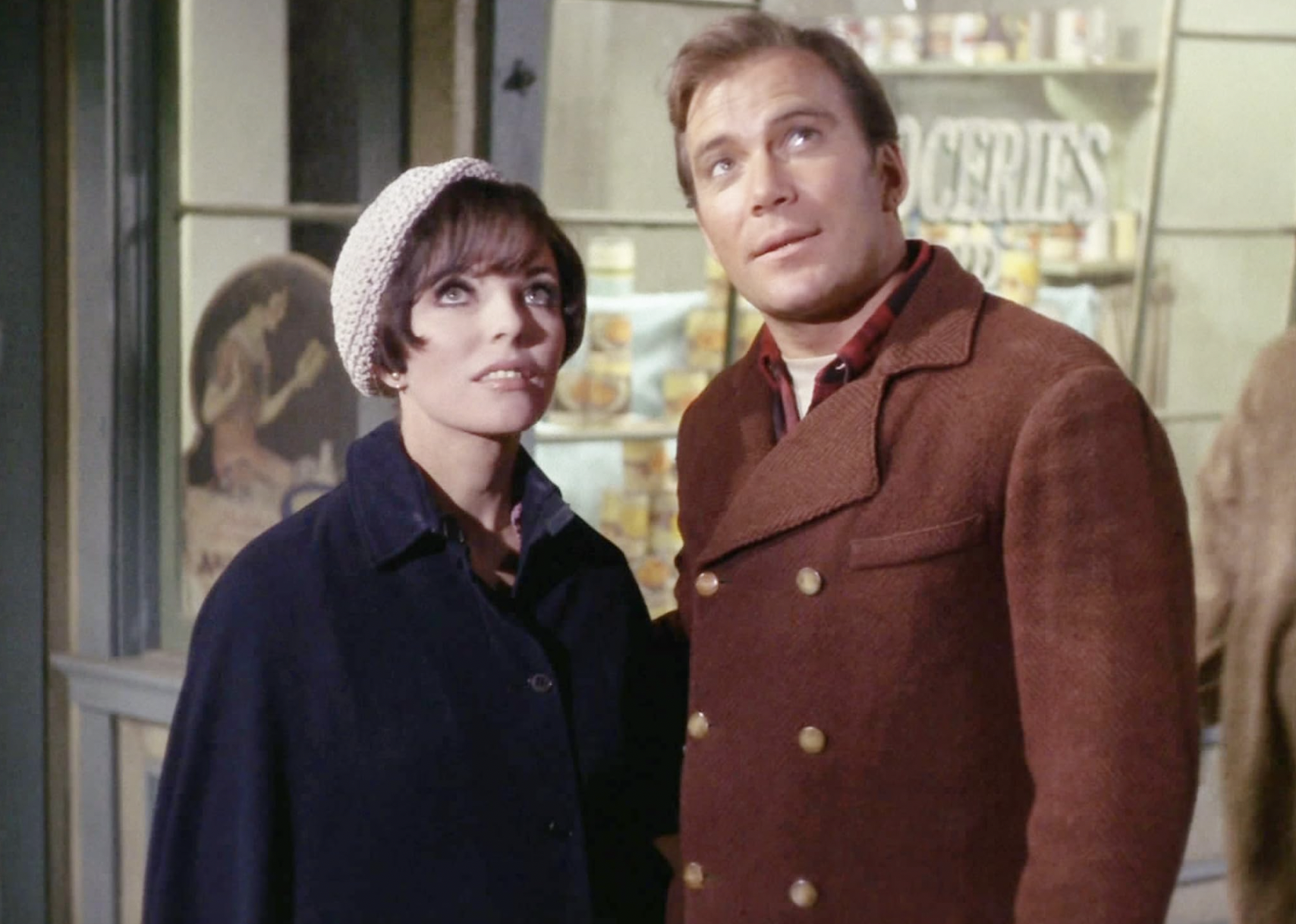
#1. The City on the Edge of Forever (1967)
- IMDb user rating: 9.2 - Season 1, Episode 28 - Director: Joseph Pevney
In quite possibly the most famous episode in the entire "Star Trek" franchise, Captain Kirk faces an unimaginable moral dilemma. A chase for an unwell McCoy leads to history being changed, and the Enterprise crew members find themselves in Depression-era New York City to repair the damage. Kirk falls in love with a social worker named Edith Keeler, but to his dismay, he discovers that for the timeline to be restored, Edith must be allowed to die. The tragic ending, Shatner's performance, high regard from both the cast and crew of "Star Trek," and multiple awards solidified "City" as the most celebrated "Trek" episode of all time .
Data reporting by Luke Hicks. Copy editing by Tim Bruns. Photo selection by Clarese Moller.
You may also like: Best 'The Mary Tyler Moore Show' episodes
More for You
Customers upset after Costco makes change to rotisserie chicken
Watch Michael J. Fox Join Coldplay on Guitar at Glastonbury
You Should Really Think Twice Before Killing That Earwig
‘That was terrifying.’ Lolo Jones competes at US Olympic trials aged 41
Ignore the critics – Kevin Costner’s three-hour western is a must-watch
This Is What a TSA Agent First Notices About You
Klay Thompson Reportedly Makes Decision on Warriors Future, NBA Free Agency
World reaction to US presidential debate: Mockery from China and Russia, concern from allies
You have 4 days to get paid up to $349 as part of an Apple iPhone settlement — here's how to know if you qualify
Caitlin Clark Rails Against Indiana Fever Coach Christie Sides
‘Trillion dollar trainwreck’: US super stealth fighter is eating the next generation
‘They took almost everything’: Cincinnati veteran, 80, is living in his car after selling his home to a company that offered sale leasebacks. Here’s what you can learn from his situation
LeBron James and Lakers lose desired NBA star to New Orleans Pelicans
WOW: Celebrity Doppelgängers Past & Present
"He offered me some cash in front of my grandma" - Kevin Garnett on how his grandmother pulled out a shotgun on a recruiter
The Rogue Alligator Authorities Found Prowling Up in the Mountains
A New Aluminum Alloy Is About to Drive the Evolution of Engines
13 Polite Habits That Fast-Food Employees Secretly Dislike
I’m a CEO and 12 of my employees are in ‘flextirement.’ With boomers opting not to retire, the arrangement will become more common
10 Genius Ways To Reduce Your Retirement Taxes
The 10 Best Captain Kirk Episodes in 'Star Trek: The Original Series'

Your changes have been saved
Email Is sent
Please verify your email address.
You’ve reached your account maximum for followed topics.
A good Captain in Star Trek is the embodiment of the ideals of the Federation. Captain James T. Kirk ( William Shatner ) came first, so he set the standard. He taught all of us Trekkers what it means to believe in this future: standing up to bigotry, treating everyone as equals, and always helping when possible. Equality in Star Trek is not leaving the less fortunate to suffer; it is lifting each other up so that they, too, can go forward and lift others.
Captains must also be tested, forged, and tempered. Kirk relishes conquering a challenge. He has faced sacrifices that tempered him and taught him when to bluff to the last breath and when to have mercy. The crew has absolute loyalty and trust in Kirk, and they know that to serve him is to stand by the same ideals as their Captain. To do otherwise would be to fail him. The following are shining examples of what it means to live by the values of Star Trek. As well as reasons why Captain Kirk of Star Trek: The Original Series will always be one of the finest Captains in Starfleet .
Star Trek: The Original Series
*Availability in US
Not available
10 "Obsession"
Season 2, episode 13.
This is Kirk's Captain Ahab moment long before Khan , but how he handles it shows that while he is not faultless, he can be brought back to reason. In this episode, Kirk confronts a familiar creature, one he previously battled and felt he had failed to defeat. He feels guilt and shame about the incident. When young Ensign Garrovick ( Stephen Brooks ) shows the same hesitation, Kirk is harsh, and the young ensign quickly shows the same shame. The Captain is at first uncharacteristically illogical in his obsession with the creature's demise.
It's only once he sees that a phaser blast does not affect the beast that he's able to forgive himself, and in doing so, the young ensign can forgive himself as well. This shows that the Captain can still make mistakes. He, too, is human, but he can still learn. He doesn't stay stubborn and hateful; he learns, adjusts, and forgives.
9 "A Taste of Armageddon"
Season 1, episode 23.
In "A Taste of Armageddon," Kirk and Spock ( Leonard Nimoy ) land on a planet that has learned how to sanitize war. The society of Eminiar VII is at war with a neighboring planet, but in a way that avoids damage to their buildings and materials. Computers initiate the attacks and provide the leaders with the projected casualties if the attack had been real. The people then surrender themselves to suicide booths. They consider this a cleaner and superior way to go to war.
Kirk is disgusted once he fully comprehends the situation. He decides to destroy the suicide booths , despite the possible consequences, to force them to face the horrors of war once again. Thousands have died. Kirk knows if they see the truth of war again—the ugliness of it—they will be forced to strive for peace. "That's all it takes...knowing that we're not going to kill today."
8 "The Corbomite Maneuver"
Season 1, episode 10.
"The Corbomite Maneuver" is a classic episode, often cited as one of Star Trek's best . It opens with Kirk in his quarters. Faced with dietary restrictions from Doctor McCoy ( DeForest Kelley ), and served by Yeoman Janice ( Grace Lee Whitney ), Kirk tells McCoy the only female he can worry about is The Enterprise. It's a slice-of-life moment, giving us a glimpse of the Captain's downtime and his commitment to the ship .
The Enterprise then comes across a new foe seemingly intent on trapping them. Kirk won't abide an unwinnable scenario, so he bluffs his way through. The crew is surprised to meet Balok ( Clint Howard ), a jovial character who only wished to learn about the ship's inhabitants by testing them. When Lt. Bailey volunteers to stay with Balok and teach him about us, Balok asks if he's Earth's best. Bailey answers no, that he will make mistakes, but Kirk states that he'll "...find out more about us that way." After all, to err is to be human.
7 "The Cloud Minders"
Season 3, episode 21.
Kirk and Spock land on a planet ruled by a literal upper class . Below them live the Troglytes, a people responsible for mining the planet's goods but prevented from enjoying the toils of their labor. The Enterprise is there on a mission for zenite, which can save another planet from a plague. Unfortunately, the citizens of Stratos made the deal while the people in charge of mining were busy fighting for their freedom.
Kirk is repulsed to see the High Advisor Plasus and his daughter Droxine (who claimed that Stratos was rid of violence) use torture, a violent and futile tactic , on one of the fighters. Plasus considers the Troglytes less evolved and incapable of learning civility, but McCoy quickly finds that the mines are filled with a gas that lowers IQ. When Plasus refuses to let Kirk dispense filtered masks, the Captain takes the masks straight to the Troglytes. No matter the politics and the zenite, he cannot stand seeing such inequity.
6 "The Omega Glory"
Season 2, episode 23.
Responding to a distress signal, Kirk finds a member of Starfleet, Captain Tracey ( Morgan Woodward ), manipulating two cultures in the hopes of commandeering what he believes to be their fountain of youth. Kirk has no desire to take down a fellow Captain, but he firmly believes that his morality outweighs that of any individual . The message, written by Gene Roddenberry himself, is undeniably overhanded. Its intention must nonetheless be acknowledged.
When Kirk begins to quote the Constitution, the words ring clear and sincere. "We the People of the United States, in Order to form a more perfect Union, establish Justice, insure domestic Tranquility, provide for the common defense, promote the general Welfare, and secure the Blessings of Liberty....They must apply to everyone, or they mean nothing!" To Spock and Bones, he states, "Liberty and freedom must be more than just words." There are few instances in which the message is so absent of subtext or metaphor. Here, Roddenberry has Kirk say it plainly, hoping that viewers will hear it.
5 "Balance of Terror"
Season 1, episode 14.
"Balance of Terror" shows Kirk once again facing bigotry, but this time on his own bridge . The Enterprise faces an unknown ship led by a Romulan Commander played brilliantly by Mark Lenard , who would later play Spock's father, Sarek. When the crew sees their likeness to Vulcans, Lt. Stiles ( Paul Comi ), whose family had lost members to Romulan attacks, grows suspicious of Spock and his pointy ears. Kirk immediately makes it clear what he thinks of prejudice aboard his ship.
Kirk and the Romulan Commander then enter an intense battle of wits. While the Romulan ship has cloaking capabilities and powerful plasma torpedoes, the Enterprise is swifter and more maneuverable, packing quite a punch herself. The two commanders grow a healthy respect for one another's shrewd strategy as the game unfolds. The Enterprise is ultimately victorious, and the Romulans choose to self-destruct, showing the crew of the Enterprise their resolve as warriors. The encounter is later revisited in Star Trek: Strange New Worlds with Captain Christopher Pike ( Anson Mount ).
4 "The Enemy Within"
Season 1, episode 5.
A transporter malfunction tore Kirk's psyche asunder, creating two physical forms of the Captain. One embodies kindness and timidity, while the other exudes aggression and a cavalier attitude. This episode gives Shatner a chance to chew up the scenes with some Olympian acting and shows what Kirk would be like if he were to lose balance. When the "bad" Kirk attacks Yeoman Janice, his crew's devotion is again shown in her hesitation to blame the Captain or "get him in trouble." Spock immediately deduces that there must be an imposter aboard because the possibility of his Captain committing such a heinous act is illogical.
When Kirk fears that his darker half has all of his best traits, McCoy reminds him that his softer side is the bravest. It takes courage to stand by your principles. As the situation comes to a head, he is given a choice: risk death by attempting to rejoin his worse half or deprive the Enterprise of her Captain. For Kirk, it is no choice at all.
3 "Space Seed"
Season 1, episode 22.
"Space Seed" begins Kirk's most significant arc as a character and sows the seed for the greatest Star Trek movie : The Wrath of Khan . The Enterprise happens on the U.S.S. Botany Bay, a ship from the 20th century. Kirk finds the vessel full of genetically modified warriors, led by Khan, who is played exquisitely by Ricardo Montalban . Lt. Marla McGivers, the ship's historian, is undone by an immediate attraction to this living embodiment of the ancient Sikh warriors of her texts.
Despite Khan's ability to lure Marla to his side, Kirk clocks Khan's instincts and sees the danger inherent. Kirk must stay in step with Khan's intellect without any genetic advantages or lose the ship entirely. There are multiple instances throughout the show where Kirk outsmarts robots and A.I., but none deliver the challenge that Khan does. Kirk regains command of the Enterprise with help from his crew and still offers Khan mercy: a planet of his own with which to make his destiny. He goes, a sign of the respect Khan now holds for Kirk.
2 "Let That Be Your Last Battlefield"
Season 3, episode 15.
"Let That Be Your Last Battlefield" perfectly encapsulates the road of futility that prejudice will take you down . Commissioner Bele ( Frank Gorshin, fresh off 1966's Batman as The Riddler ) and Lokai ( Lou Antonio ) are two beings locked in an eternal duel, all because one is black on the right side and the other on the left. Bele seizes control of the ship to escort Lokai to their home world of Cheron, but Kirk chooses to activate the ship's self-destruct sequence rather than let anyone take his Enterprise. "You can use your will to drag this ship to Cheron, but I command the computer. MINE is the final command ."
Once control of the ship is back in his hands, he offers mercy yet again. He explains that the Federation is ruled by peace and implores them to consider finding a new purpose. But the two are so entrenched in their hatred that they choose instead to continue to pursue each other, presumably until the end of time, on a dead planet, ravaged by their resentment.
1 "Court Martial"
Season 1, episode 20.
The original trial episode, "Court Martial," started a fan-favorite tradition in the form of the courtroom drama. Kirk stands accused of murder by a crewman's daughter, Jame ( Alice Rawlings ). He recalls perfectly not jettisoning the pod until he had activated red alert and had no choice . Yet, the computer's record doesn't match his recollection. Kirk, unafraid to dig for the truth and steadfast in the knowledge that he would never doom a man without cause, demands a trial.
During the trial, Spock explains, "It is impossible for Captain Kirk to act out of panic or malice. It is not his nature." Even an angry young daughter is later shaken by her conviction and pleads with Kirk's defense attorney, Cogley ( Elisha Cook ), to help him. Kirk has no resentment toward her for the accusation. Even once he finds the man responsible for putting him in this position, he wants only to help him. "Court Martial" shows Kirk strong and steady in his principles, his crew's utter faith in him, and his unfailing belief in mercy over violence. Star Trek continues the tradition most recently through Strange New Worlds ' second season.
NEXT: What We Know About Captain Pike's Next Voyage in 'Star Trek: Strange New Worlds' Season 3
- William Shatner
Screen Rant
The complete star trek timeline explained.

Your changes have been saved
Email Is sent
Please verify your email address.
You’ve reached your account maximum for followed topics.
How To Watch All Star Trek TV Shows In Timeline Order
Every star trek movie in chronological order, to me, william shatner’s movie star trek v is great comfort food.
- Star Trek's timeline is a complex tapestry that spans over a thousand years, filled with time travel and alternate realities.
- Star Trek: Enterprise chronicles the pioneering voyages of Captain Jonathan Archer, setting the stage for the United Federation of Planets.
- Star Trek: The Next Generation and Star Trek: Deep Space Nine continue the legacy of the original series, shaping the 24th century era.
Star Trek has been one of the premiere science fiction franchises in the world for nearly 60 years, spanning over a dozen TV series consisting of 900+ episodes, and 13 feature films with more on the way. Star Trek' s Prime Timeline now encompasses a thousand years of the United Federation of Planets and Starfleet seeking out strange new worlds, and boldly going where no one has gone before in the 22nd, 23rd, 24th, 25th, and 32nd centuries.
Star Trek has rarely told its stories in a straight, chronological line; time travel tropes, alternate realities, and massive jumps into the future are all commonplace. Star Trek is a multiverse of myriad realities, including an alternate Mirror Universe. The Star Trek timeline is a rich tapestry of compelling characters and science fiction parables - and it's still going strong.
Here is a definitive guide to Star Trek' s timeline, primarily centering on the Prime Universe's Star Trek TV series and feature films in chronological order, including the alternate Kelvin Timeline of J.J. Abrams' Star Trek movies where noted.
An Untitled Star Trek Origin movie reportedly set "decades before" J.J. Abrams' Star Trek (2009) is in development, and may end up preceding this entire chronology.
The Star Trek TV franchise has existed for 57 years and consists of 12 shows (and counting). Here's how to watch them all in timeline order.
28 Star Trek: Enterprise
(2151-2155).
Star Trek: Enterprise is, chronologically, the first Star Trek series in the timeline (although technically the 6th produced) chronicling the pioneering 22nd-century voyages of Captain Jonathan Archer (Scott Bakula) and the NX-01 Enterprise. Archer's Enterprise is Starfleet's first Warp 5-capable starship, which allowed the NX-01 to make pivotal First Contact missions and lay the groundwork for the creation of the United Federation of Planets. Star Trek: Enterprise 's 4 seasons only depict the first few years of Archer's 10-year saga that ends with the first Captain of the Enterprise helping to found the Federation in 2161.
Star Trek: Enterprise
*Availability in US
Not available
27 Star Trek: The Original Series - "The Cage"
"The Cage" is the original Star Trek pilot that was rejected by NBC. However, "The Cage" is a canonical story set 2 years before Star Trek: Discovery season 1 and 12 years before Star Trek: The Original Series . Set in 2254, "The Cage" sees Captain Christopher Pike (Jeffrey Hunter) and the USS Enterprise lured to Talos IV, where Pike is held captive the planet's illusion-casting inhabitants. Star Trek: The Original Series turned "The Cage" into a two-part episode titled "The Menagerie", and "The Cage" also laid the foundation for Star Trek: Strange New Worlds.
26 Star Trek: Discovery Seasons 1 and 2
(2256-2258).
Star Trek: Discovery begins with a disastrous meeting between Starfleet and the Klingon Empire in 2256, which leads to a long, bloody war that nearly cost the Federation its soul. Centering on Commander Micheal Burnham (Sonequa Martin-Green), Discovery deals with the personal prices of war, as well as the themes of redemption and empathy.
Star Trek: Discovery season 1 depicted the Klingon War, while Discovery season 2 brought in USS Enterprise Captain Christopher Pike (Anson Mount). When faced with a genocidal artificial intelligence called Control, the crew of the USS Discovery realize the only way to save all organic life in the universe would be to jump to the 32nd century, permanently leaving Star Trek: Discovery' s original 23rd century era behind.
Star Trek: Discovery season 1 also ventured to the 23rd century MIrror Universe for a multi-episode arc.
Star Trek: Discovery
25 star trek, (kelvin timeline 2233/kelvin timeline 2258/2387).
Directed by J.J. Abrams, Star Trek is a reboot that spawns the alternate reality known as the Kelvin Timeline. Star Trek 's main story is set in 2258 of the parallel reality , but the film's branching timeline is made possible by the supernova of the Romulan sun in 2387 in the Prime Universe, which Ambassador Spock (Leonard Nimoy) is unable to prevent.
The Romulan villain Nero (Eric Bana) time travels back to 2233, and his attack on the USS Kelvin ignites an all-new reality that changes the lives of Captain James T. Kirk (Chris Pine) and the crew of the USS Enterprise. After Kirk and the Enterprise defeat Nero, they set forth into the great unknown of their new reality.
In the Kelvin Timeline, Kirk and his friends become the crew of the USS Enterprise roughly 7 years before Captain Kirk (William Shatner) and his crew take command of the Enterprise in Star Trek 's Prime Universe.
Star Trek (2009)
24 star trek into darkness, (kelvin timeline 2259).
Set a year after Star Trek 's events, Star Trek Into Darkness sees the crew of the Starship Enterprise take on Khan Noonien Singh (Benedict Cumberbatch), whose life has also been massively altered in the Kelvin Timeline. Rather than being discovered by the Enterprise in 2267, Khan's derelict ship was discovered much earlier by Starfleet's Section 31, led by the corrupt Admiral Alexander Marcus (Peter Weller). Marcus attempts to use Khan to militarize Starfleet and wage war with the Klingons, but Captain Kirk and the Enterprise defeat both Marcus and Khan.
Star Trek Into Darkness remakes and reverses key elements of Star Trek II: The Wrath of Khan , which takes place 26 years later in the Prime Timeline.
Star Trek Into Darkness
With 13 entries in the Star Trek movie series from 1979-2006, there are a couple of ways to watch the films chronologically.
23 Star Trek: Strange New Worlds
(2259-onward).
Star Trek: Strange New Worlds begins in 2259, months after Star Trek: Discovery season 2, with Captain Christopher Pike leading the Starship Enterprise on all-new missions of exploration. Strange New Worlds sets the stage for what will eventually become Star Trek: The Original Series , with young versions of Lieutenant Spock (Ethan Peck), Ensign Nyota Uhura (Celia Rose Gooding), Nurse Christine Chapel (Jess Bush), Scotty (Martin Quinn), and even Lieutenant James T. Kirk (Paul Wesley) serving on the Enterprise.
Although Pike's tragic future of being horribly disfigured is inevitable, Strange New Worlds fills in the years before Kirk takes over as Captain of the Enterprise with optimism and an anything-goes attitude. Strange New Worlds ' deftness in adapting to different genres, from comedy, to action, to Star Trek 's first musical episode , makes the episodic series the purest Star Trek show in years.
Star Trek: Strange New Worlds
22 star trek beyond, (kelvin timeline 2263).
Back in the alternate Kelvin Timeline and 3 years into their five-year mission of exploration , the crew of the Starship Enterprise are attacked by the mysterious Krall (Idris Elba). Krall's mechanized drone army destroys the Enterprise, stranding Captain Kirk and his captured crew on the planet Altamid. Kirk and his friends escape with the help of their new ally, Jaylah (Sofia Boutella), and they defeat Krall before he destroys Starfleet's USS Yorktown space station. At the end of Star Trek Beyond , Captain Kirk takes command of the new USS Enterprise-A.
Star Trek Beyond is dedicated to Leonard Nimoy and Anton Yelchin, who passed away in 2015 and 2016, respectively.
Star Trek Beyond
21 star trek: the original series, (2266-2269).
The Star Trek show that started it all, Star Trek: The Original Series chronicles the first three years of Captain James T. Kirk and the USS Enterprise's historic five-year mission of exploration, starting in 2266. The original Star Trek is an all-time classic, establishing the core tropes of the franchise, from starships, to beaming down to planets, to the unbreakable three-way friendship between Captain Kirk, Mr. Spock, and Dr. Leonard "Bones" McCoy (DeForest Kelley). Star Trek: The Original Series would not only be emulated by every other Star Trek that followed, but it would also become an enduring part of pop culture.
Star Trek: The Original Series
20 star trek: the animated series, (2269-2270).
While Star Trek: The Original Series was unceremoniously canceled after its third season, the show would go on to become a phenomenon in syndication. The first hint that Star Trek would outlive its somewhat humble beginnings was Star Trek: The Animated Series , an Emmy-winning cartoon that aimed for a family-friendly vibe without sacrificing what made the live-action original Star Trek work. Star Trek: The Animated Series is essentially the fourth season of Star Trek: The Original Series , and its status as canon has been made official by its numerous references in Star Trek on Paramount+'s shows .
Gene Roddenberry did not consider Star Trek: The Animated Series to be official canon, which made the cartoon apocryphal for decades.
19 Star Trek: The Motion Picture
Star Trek: The Motion Picture is the first feature film that launched Star Trek as a successful movie franchise . Set in the 2270s, years after the USS Enterprise's five-year mission ended, Admiral James T. Kirk takes command of his starship once more and reunites his crew to intercept a threat to Earth. Star Trek: The Motion Picture reunited the entire cast of Star Trek: The Original Serie s for a ponderously-paced adventure that had the virtue of dazzling visual effects . But Star Trek: The Motion Picture proved the human adventure was, indeed, just beginning.
18 Star Trek II: The Wrath of Khan
Star Trek II: The Wrath of Khan, still widely considered the gold standard of Star Trek films, picks up Admiral Kirk's saga in 2285. A sequel to the Star Trek: The Original Series episode "Space Seed", Admiral Kirk faces a midlife crisis just as his old enemy, Khan Noonien Singh (Ricado Montalban) steals both the USS Reliant and the Genesis Device super weapon to seek revenge on Kirk. Star Trek II ends with the sacrifice and death of Spock, but opens the door for the Vulcan's resurrection and much more.
17 Star Trek III: The Search For Spock
Set immediately after the events of Star Trek II: The Wrath of Khan, Star Trek III: The Search For Spock finds Admiral Kirk and friends stealing the USS Enterprise in an effort to save Spock's katra - his soul - after the wily Vulcan transferred it to Dr. McCoy just before his death. The crew would eventually save Spock, but at great cost; Kirk would not only lose his son, David Marcus (Merritt Burrick) , to a Klingon attack, but the Starship Enterprise is destroyed to prevent it from falling into Klingon hands. Thankfully, Kirk succeeds in bringing back Spock.
Star Trek III: The Search for Spock is the first film directed by Leonard Nimoy.
16 Star Trek IV: The Voyage Home
(2286/1986).
Star Trek IV: The Voyage Hom e takes place in 2286 , months after Star Trek III: The Search for Spock . Or, at least, the 23rd century bookends of the movie do. The bulk of Star Trek IV is set in 1986 San Francisco, where Admiral Kirk and the former crew of the USS Enterprise time travel in order to find two humpback whales to bring back to the future in order to save Earth. A delightful, fish-out-of-water, time travel romp, Star Trek IV proved a Star Trek movie doesn't need action, violence, and death to be a mainstream success.
Kirk is demoted to Captain and given command of the USS Enterprise-A at the conclusion of Star Trek IV.
15 Star Trek V: The Final Frontier
Directed by William Shatner, Star Trek V: The Final Frontier begins with the malfunctioning USS Enterprise-A less than a year out of space dock . But Captain Kirk and crew are still called into action when a mysterious Vulcan named Sybok (Laurence Luckinbill) takes a group of diplomats hostage, demanding a starship in exchange for their release. Sybok would be revealed as Spock's half-brother who seeks God on the fabled planet Sha Ka Ree. When "God" (George Murdock) turns out to be a malevolent alien, Sybok sacrifices himself so that Kirk and Spock can destroy the false Almighty.
William Shatner's Star Trek V: The Final Frontier is a comforting watch with enjoyable banter, a compelling villain in Sybok, and good intentions.
14 Star Trek VI: The Undiscovered Country
Star Trek VI: The Undiscovered Country is set in 2293 when the Klingon moon Praxis' explosion leaves the Klingon Empire in dire financial straits. But a conspiracy within the Federation, the Romulans, and Klingons seek to prevent peace, and Captain Kirk is framed for the assassination of Klingon High Chancellor Gorkon (David Warner) . Star Trek VI is the final voyage of Captain Kirk's USS Enterprise crew, and its Klingon-centric story sets the stage for the future friendship between the Klingons and the Federation in Star Trek: The Next Generation .
13 Star Trek: Section 31
Star Trek: Section 31 , which stars Academy Award-winner Michelle Yeoh, is Star Trek 's first movie made for streaming on Paramount+. While the story of Section 31 is top-secret, the movie is a spinoff of Star Trek: Discovery, taking place after Yeoh's Emperor Philippa Georgiou exited the 32nd century . Georgiou reappears in the "lost era" of Star Trek 's early 24th century , although there could be more time travel involved in Star Trek: Section 31 as Philippa confronts the sins of her own past.
Star Trek: Section 31
12 star trek: the next generation, (2364-2370).
Star Trek: The Next Generation is the pillar and foundation of Star Trek 's popular 24th-century era . TNG follows the voyages of Captain Jean-Luc Picard (Patrick Stewart) and the crew of the Galaxy Class USS Enterprise-D. TNG is Star Trek to an entire generation of fans, and the series produced some of the greatest Star Trek episodes of all-time . Expanding the universe and canon in myriad ways, and nominated for a Best Dramatic Series Emmy, Star Trek: The Next Generation was a massive hit in first-run syndication and solidified Star Trek as an A-list franchise for most of the 1990s.
Star Trek: The Next Generation
11 star trek: deep space nine, (2369-2375).
Star Trek: Deep Space Nine would break new ground for the Star Trek franchise in more ways than one. DS9 starred Avery Brooks as Commander (later Captain) Benjamin Sisko, the first Black actor to lead a Star Trek series. Taking command of a former Cardassian space station Starfleet renamed Deep Space Nine, Sisko would interact with a vast cavalcade of characters that would deepen the Star Trek universe in countless ways. Culminating with the epic Dominion War saga that reshaped the galaxy, Star Trek: Deep Space Nine is a fundamentally important part of the Star Trek universe.
Star Trek: Deep Space Nine began as a spinoff of Star Trek: The Next Generation and carried on in syndication after TNG jumped to feature films.
Star Trek: Deep Space Nine
10 star trek: voyager, (2371-2378).
Star Trek: Voyager was the flagship series of the United Paramount Network (UPN), and continues the 24th-century era of Star Trek: The Next Generation and Star Trek: Deep Space Nine , but with a twist: Captain Kathryn Janeway (Kate Mulgrew) and the USS Voyager were stranded in the uncharted Delta Quadrant. Voyager's seven-year journey home created a new generation of fans (girls and women, especially) and saw the introduction of numerous new alien species and characters, as well as the return of the Borg. Voyager ended with Janeway, Seven of Nine (Jeri Ryan), the Doctor (Robert Picardo), and its other characters as bona fide Star Trek icons.
Star Trek: Voyager
9 star trek generations, (2371/2293).
Star Trek Generations ' main story takes place in 2371, months after the series finale of Star Trek: The Next Generation. However, Star Trek Generations begins with a prologue set in 2293 where Captain James T. Kirk is believed to be killed during the maiden voyage of the USS Enterprise-B. Kirk survives within the interdimensional Nexus, where he meets Captain Jean-Luc Picard, who is out to stop a madman named Dr. Tolian Soran (Malcolm McDowell) from destroying the Veridian star system.
Kirk and Picard's team-up defeats Soran but results in Kirk's tragic death . Meanwhile, a Klingon plot leads to the destruction of the USS Enterprise-D. Star Trek Generations was a successful transition by TNG to feature films so that the 24th century era of Star Trek continued on television and in movie theaters.
- the wrath of khan

COMMENTS
1. Star Trek: Deep Space Nine (1993-1999) Everett Collection. Placing Star Trek: Deep Space Nine in the top spot is perhaps a contentious decision. However, this series did more than measure up ...
(Photo by Paramount+/CBS) Star Trek TV Shows Ranked by Tomatometer. Updated: September 8, 2023. The Star Trek universe kicked off in 1966 with the original series, created by science fiction visionary Gene Roddenberry, and later exploded into a massive film and TV juggernaut.. While the original series, which starred William Shatner as Captain James T. Kirk and Leonard Nimoy as Mr. Spock, saw ...
Here's our ranking of every Star Trek series, from worst to best. 11. Star Trek: The Animated Series (1973-1975) CBS/Viacom. Yes, it's at the bottom, but I'd never say this is a bad series ...
The Enemy Within. "The Original Series" — Season 1, Episode 5. The transporter — the cause of, and solution to, so many "Star Trek" problems — accidentally splits Capt. Kirk (William ...
6. Discovery (2017 - 2023) Strangely, Discovery only gets better as other Star Trek series embrace the standard form. When it first launched under the direction of the often wonderful but always ...
Star Trek's long history means that alongside 13 Star Trek movies and countless comics, graphic novels, and books, the number of Star Trek series is already in the double digits. On top of that, there are almost 900 episodes across the Star Trek timeline , and that number is set to hit the thousands in the not-too-distant future as the best ...
6 'Star Trek: Deep Space Nine' (1993-1999) Rotten Tomatoes Score: 91%. A spinoff of The Next Generation, Deep Space Nine is about a Federation space station guarding the entrance to a wormhole and ...
The character interactions are a highlight in the series, as is the writing, especially in the latter half of the show's run when the multi-arc episodes become tight and compelling. 2. Star Trek ...
Variety ranks the best "Star Trek" movies and television shows of the franchise so far. ... especially in the first year of a guaranteed 10 films for the Academy's top category. I would also put ...
2. Star Trek. 1966-1969 80 eps TV-PG. 8.4 (94K) Rate. TV Series. In the 23rd Century, Captain James T. Kirk and the crew of the U.S.S. Enterprise explore the galaxy and defend the United Federation of Planets. Creator Gene Roddenberry Stars William Shatner Leonard Nimoy DeForest Kelley. 3.
The first series, simply titled Star Trek, launched a massive multimedia franchise with twelve shows and counting. Some shows were better received than others, but they all boldly pushed the franchise forward in some way. More importantly, Star Trek has become one of the most influential sci-fi franchises in television history, not to mention garnering billions of dollars over the last six ...
It's worth noting that while SNW has a 98% average Tomatometer on 84 reviews across two seasons, the 2009 reboot film Star Trek in the No. 2 position is Certified Fresh on 356 reviews. Some might argue that the film's volume of reviews makes it the top title, but if we want to start nitpicking on the franchise level, the series also ...
Ricardo Montaban's single appearance on the original series as the 1990s warlord Khan Noonien Singh set the stage for the undisputed greatest Star Trek film ever, The Wrath of Khan, set 15 years ...
Summary. The best Star Trek episodes balance social messaging with entertaining genres like comedy, horror, and romance. "Far Beyond the Stars" reflects on Star Trek's power to change societal attitudes about racial equality. "Darmok" is a profound story about communication and cultural connection. With hundreds of episodes across 11 different ...
Star Trek: The Animated Series aired on NBC for 2 seasons spanning 22 half-hour episodes from 1973 to 1974. Executive produced by Gene Roddenberry and D.C. Fontana, The Animated Series was, at the time, considered to be the fourth season of Star Trek and won an Emmy in 1975 for Outstanding Entertainment - Children's Series. It featured the voices of the original Star Trek actors except for ...
TNG consistently maintained high ratings, often ranking in the top 10 of hour-long dramas, and is one of the few Star Trek shows that actually ended its run with higher ratings than when it began. Today, TNG has a 91% on Rotten Tomatoes, but places just slightly higher than Deep Space Nine on IMDb with an 8.6/10.
With that in mind, here's a perhaps controversial list of the 21 greatest "Star Trek: The Original Series" episodes. 21. A Piece of the Action (Season 2, Episode 17) NBC. Although humorous moments ...
TV Episode. Melanie, an aspiring writer, wants to know why Jake Sisko stopped writing at 40. Jake tells how his father died in an accident and then suddenly reappeared. Director David Livingston Stars Avery Brooks Rene Auberjonois Michael Dorn. 10. Star Trek: The Next Generation.
On Netflix: Season 1, Episode 11. Netflix wants you to start watching TOS with "The Cage.". Resist! This is not a great way to start the series. "The Cage" was an unaired pilot for Star ...
9. Amok Time (Season 2) Season 2 of Star Trek kicked off with our first look at Spock's home planet, Vulcan. Leonard Nimoy's character had been the breakout character of the show the previous ...
The ambitious science fiction series was constantly on the brink of cancellation and was cut short only three years into its planned five-season run. Contents. 10. Mirror, Mirror (season 2 ...
1. "All Good Things…" (Season 7) "All Good Things…" is the best Star Trek series finale ever and The Next Generation 's crowning achievement. Written by Brannon Braga and Ronald D. Moore, "All Good Things" proved to be a better cinematic-worthy adventure than The Next Generation crew's first movie, Star Trek: Generations.
1 The City On The Edge Of Forever: 9.3. The most celebrated episode of Star Trek not only by fans but by the world, "The City On The Edge Of Forever" sees Kirk, Spock, and Doctor McCoy trapped in New York City in 1930, right at the height of the Great Depression. As Kirk and Spock search for a crazed McCoy who had accidentally injected himself ...
To honor the original 79 episodes, Stacker gathered IMDb data for all episodes of the original "Star Trek" series and ranked the top 25 by user rating as of June 2023, with ties broken by the ...
A good Captain in Star Trek is the embodiment of the ideals of the Federation. Captain James T. Kirk (William Shatner) came first, so he set the standard.He taught all of us Trekkers what it means ...
Star Trek has been one of the premiere science fiction franchises in the world for nearly 60 years, spanning over a dozen TV series consisting of 900+ episodes, and 13 feature films with more on the way. Star Trek's Prime Timeline now encompasses a thousand years of the United Federation of Planets and Starfleet seeking out strange new worlds, and boldly going where no one has gone before in ...